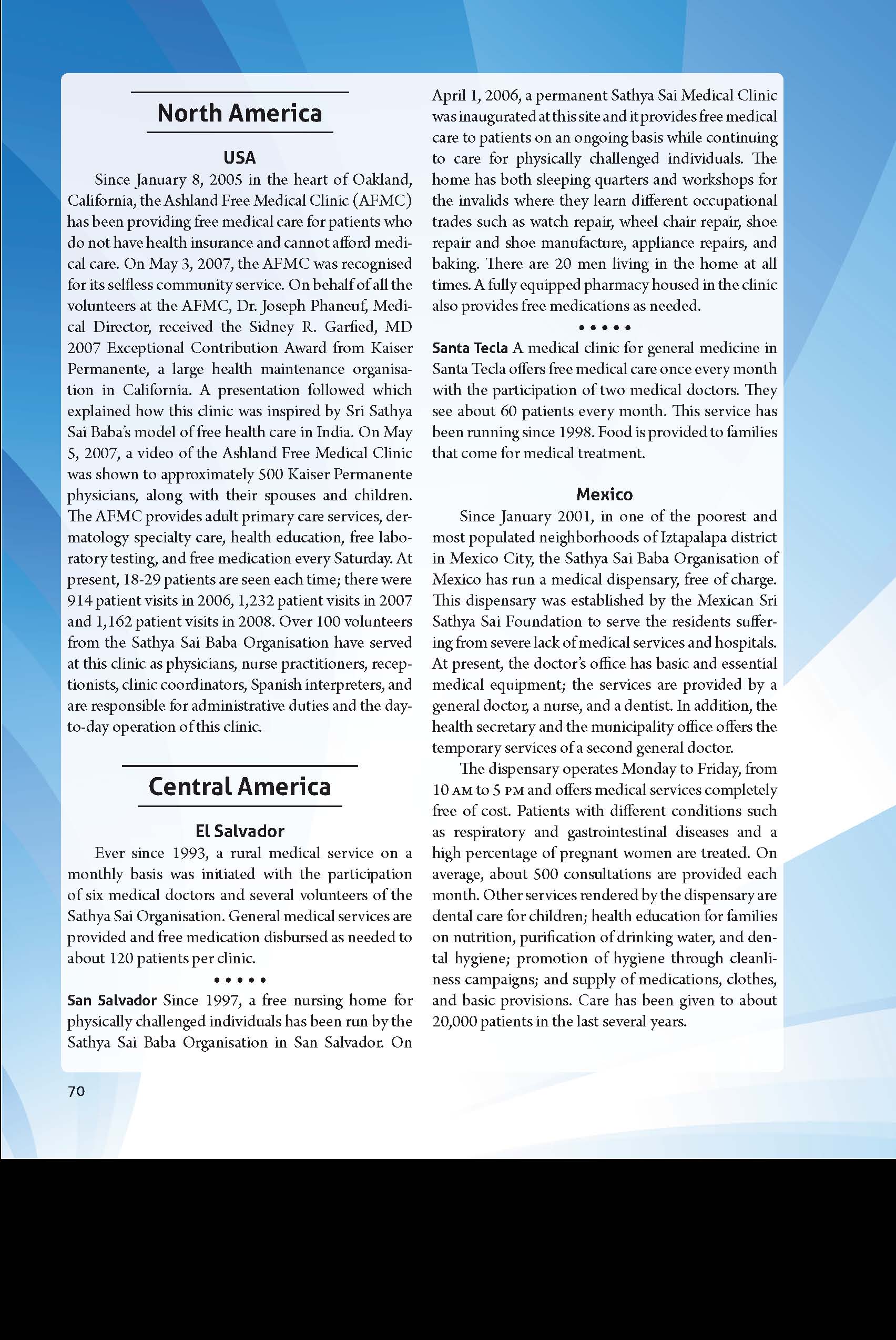
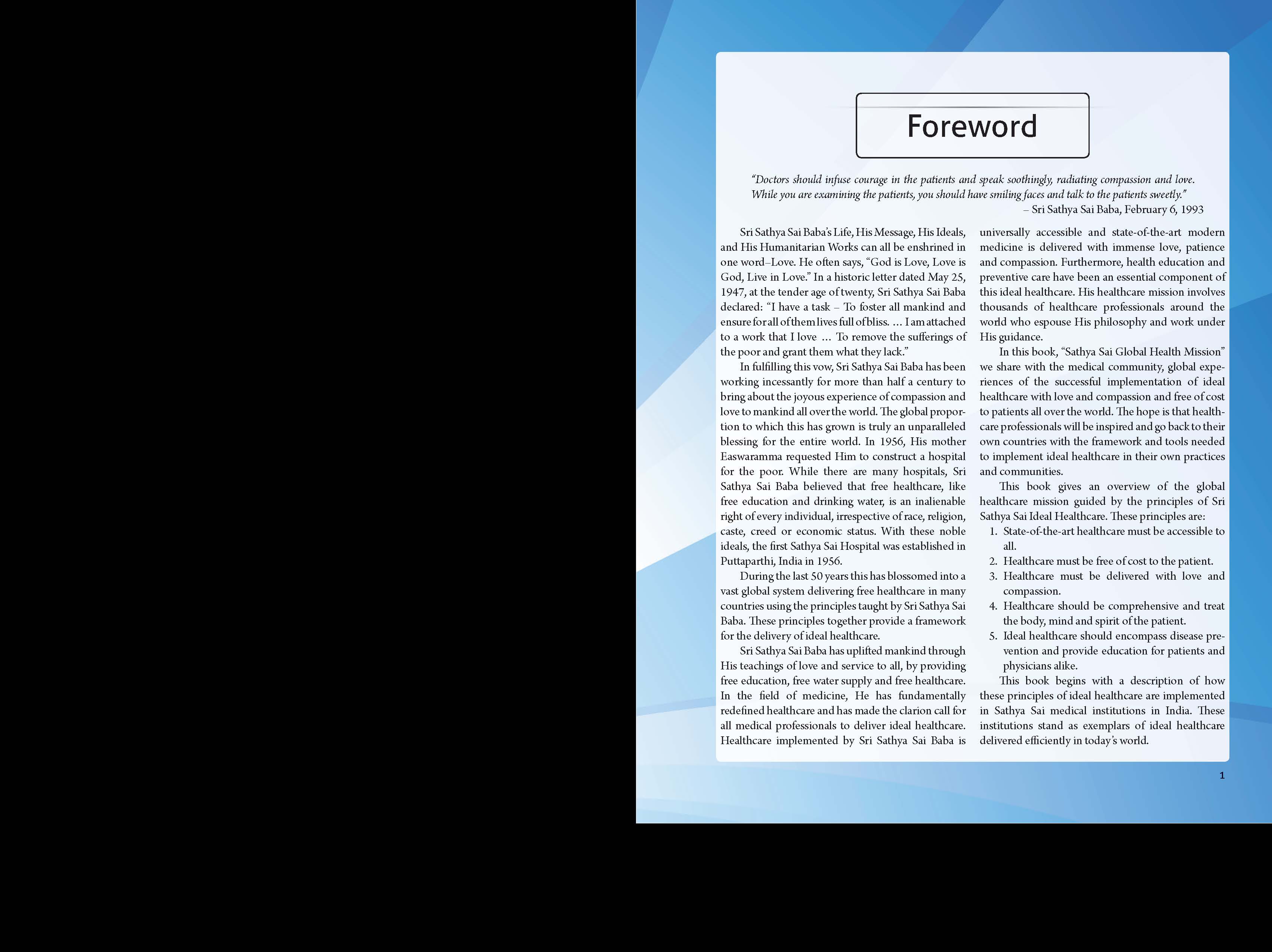
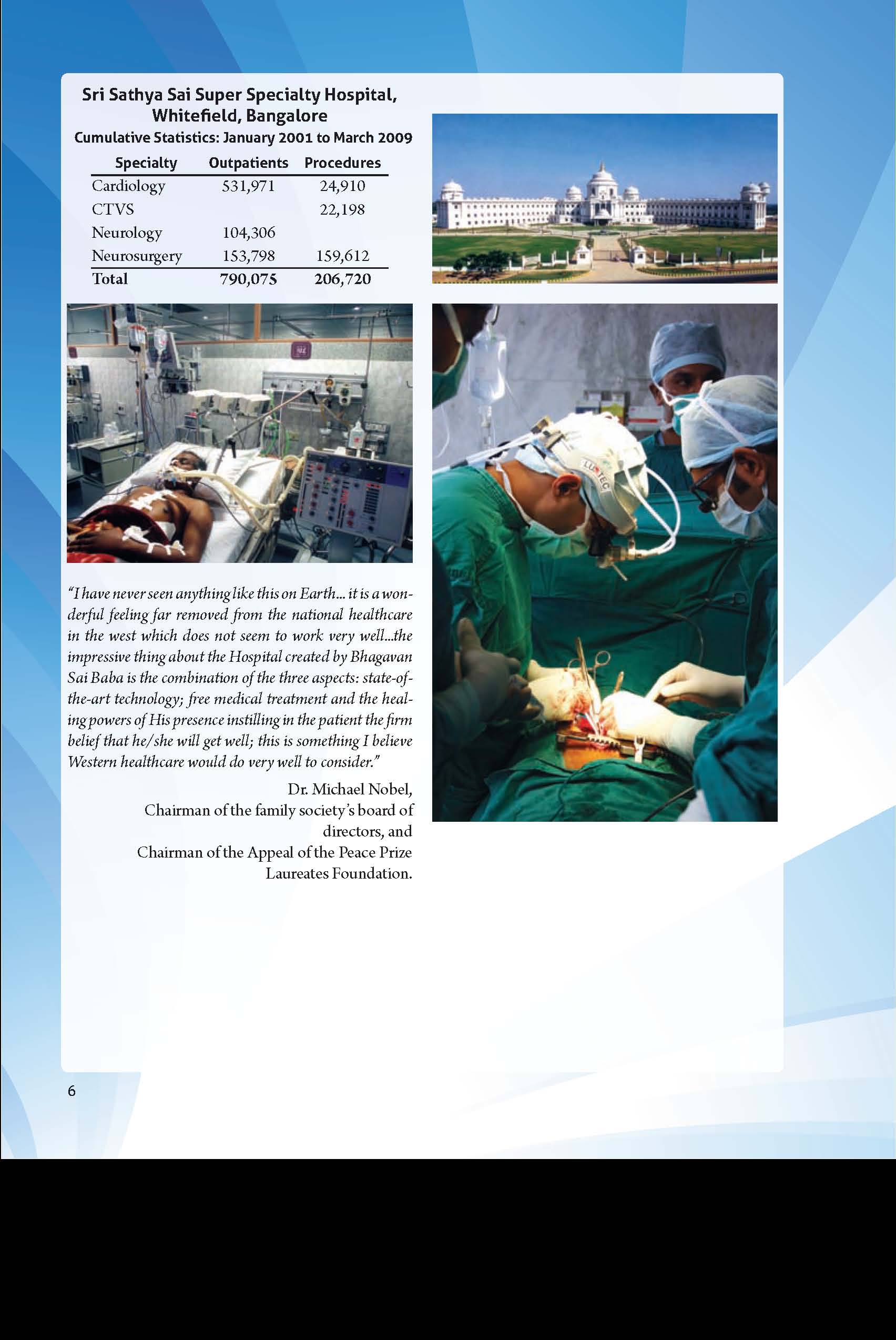
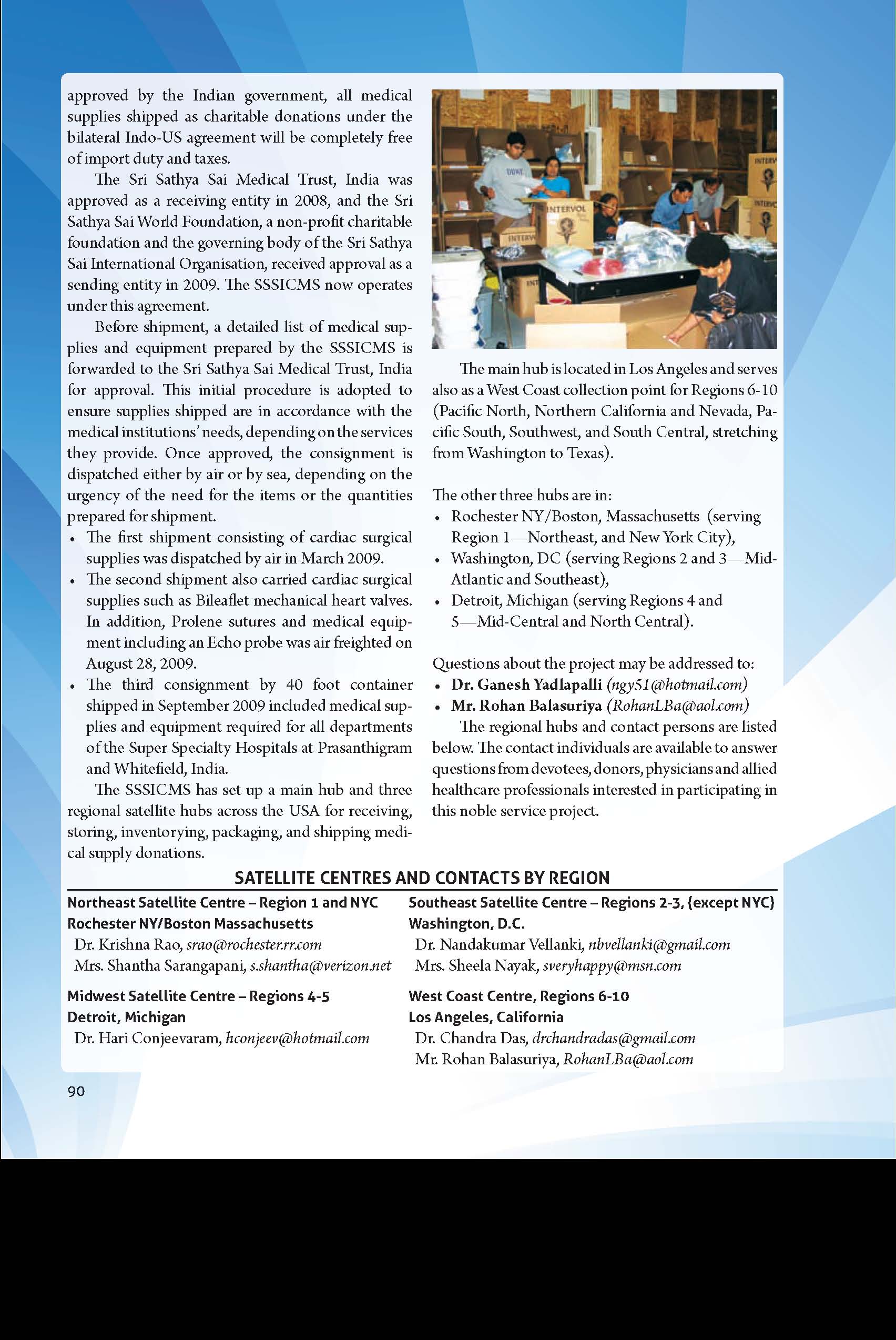
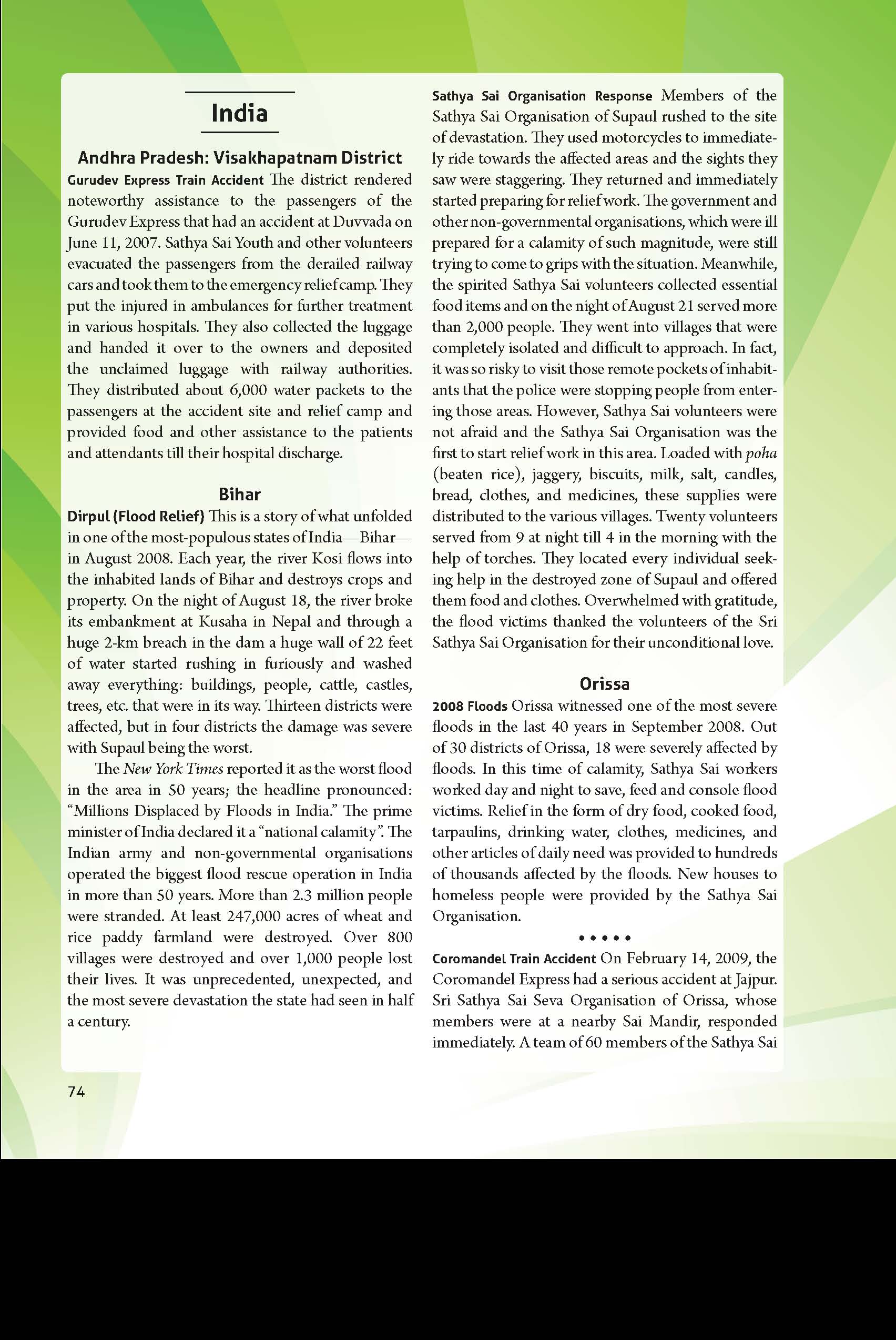
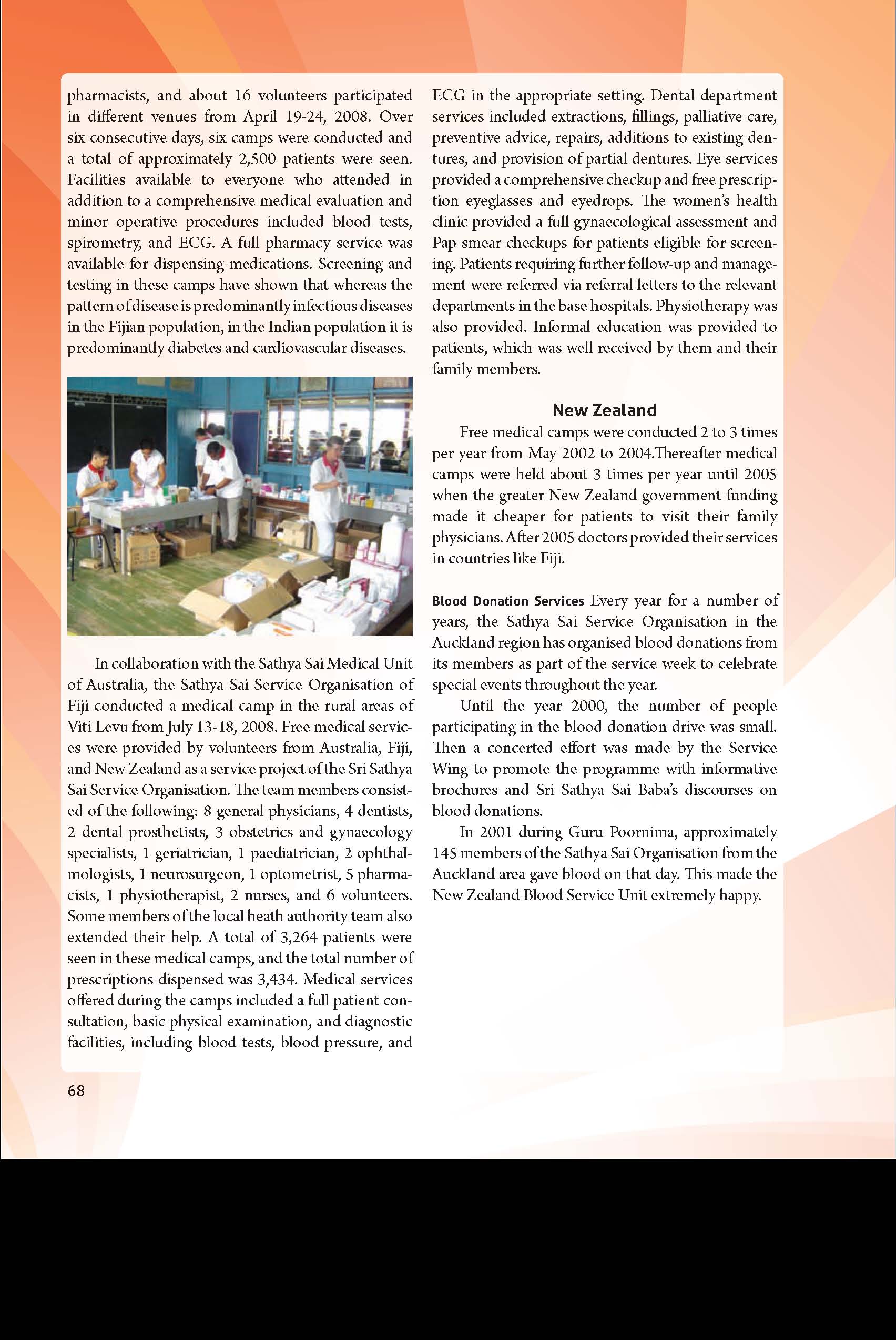

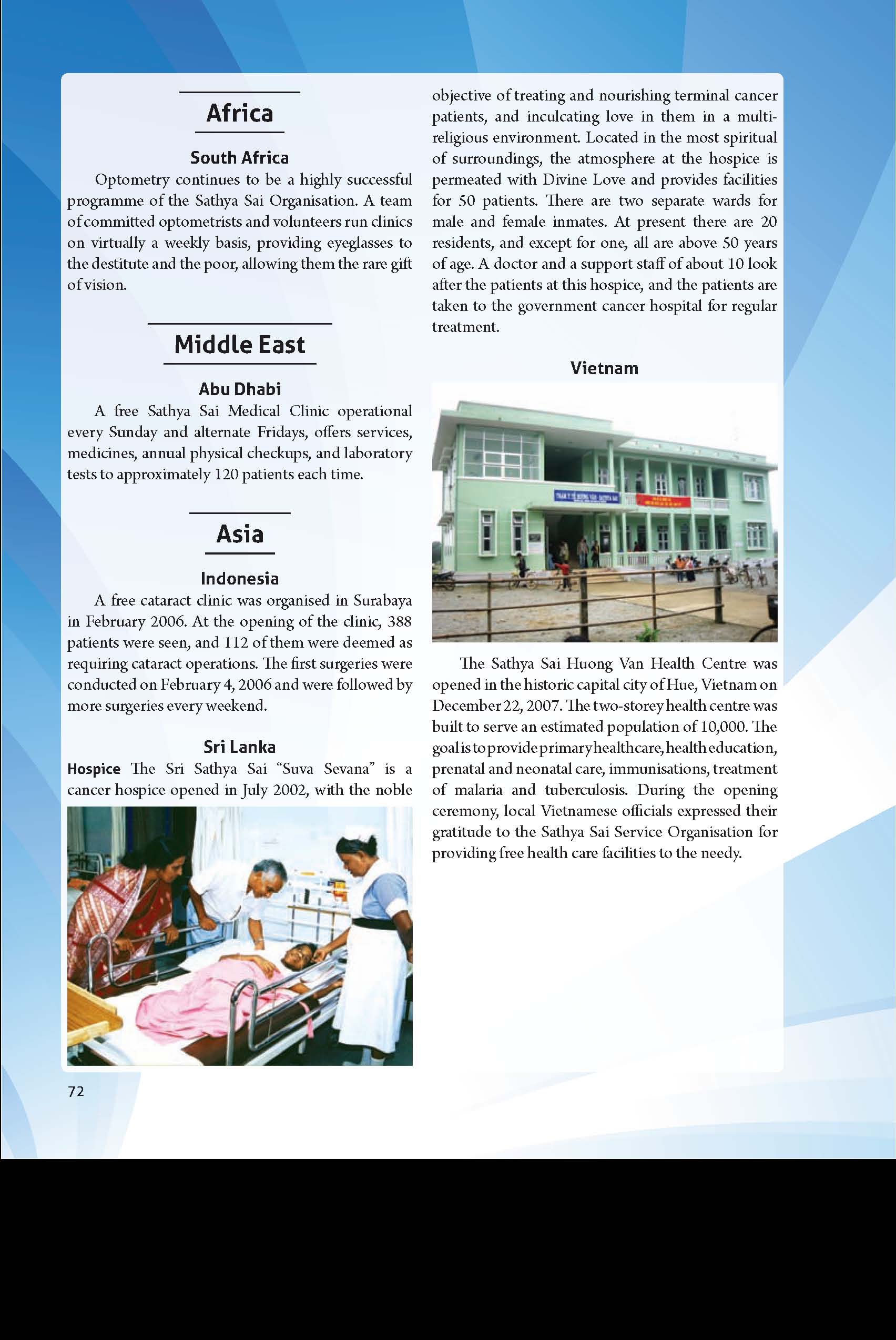
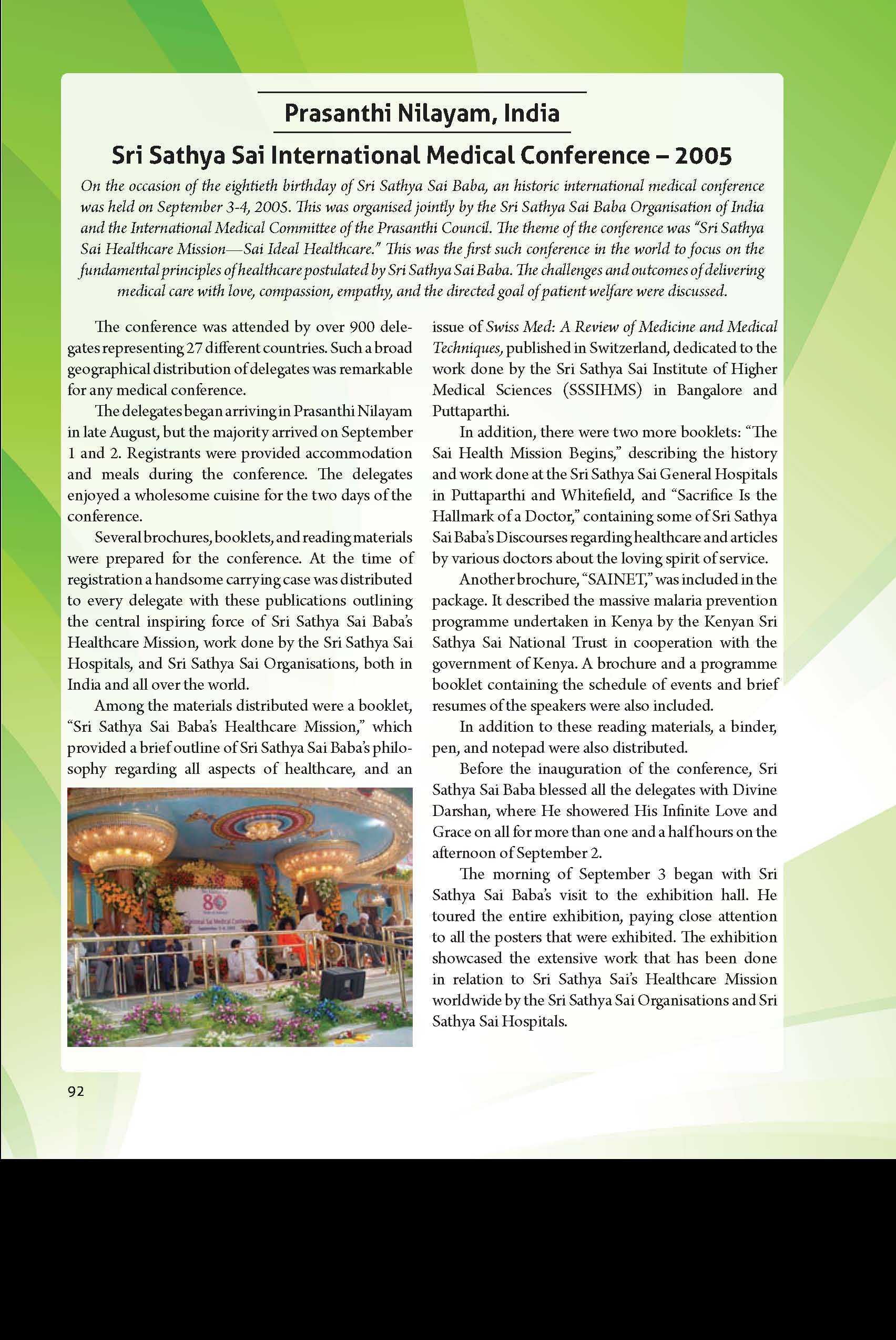
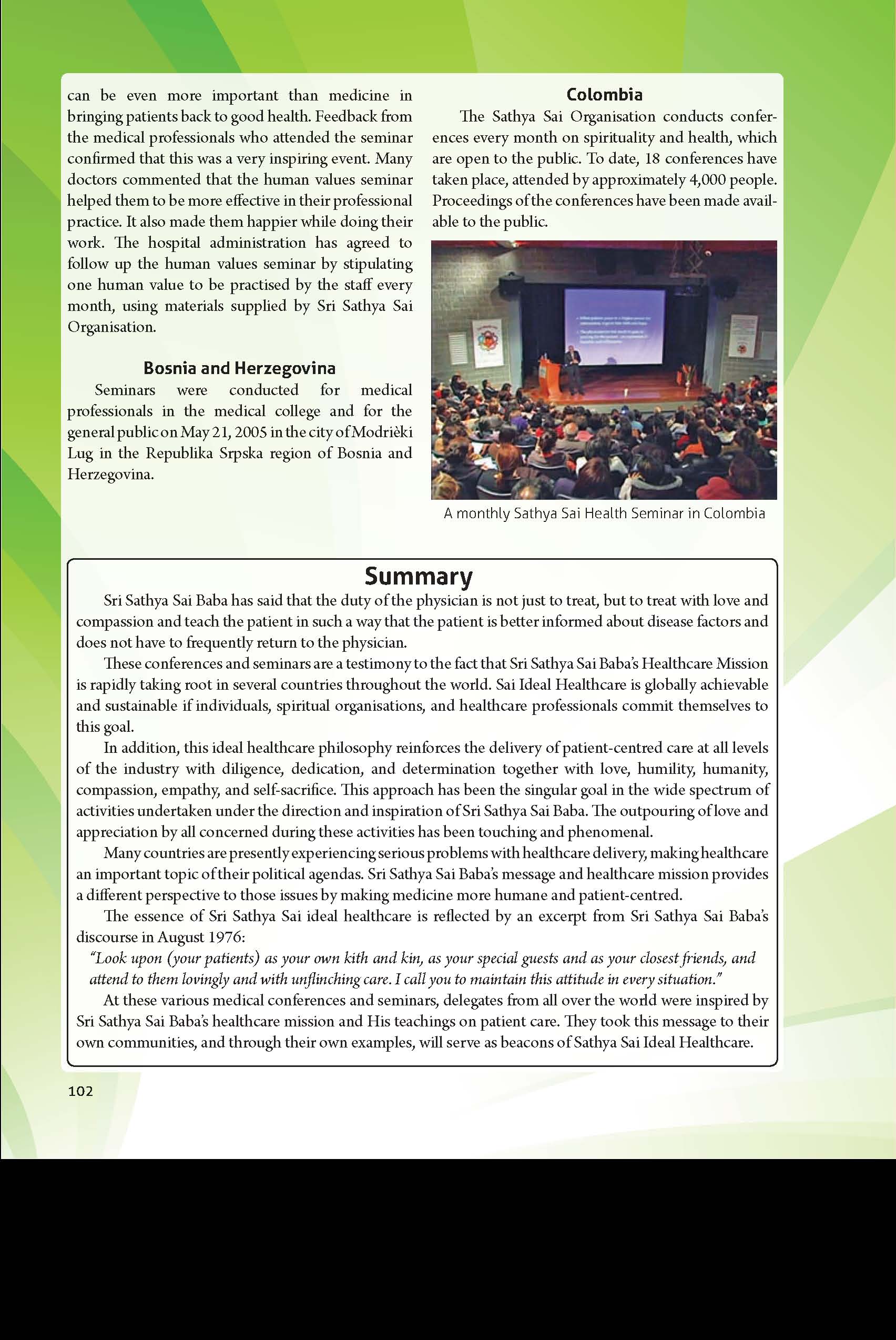
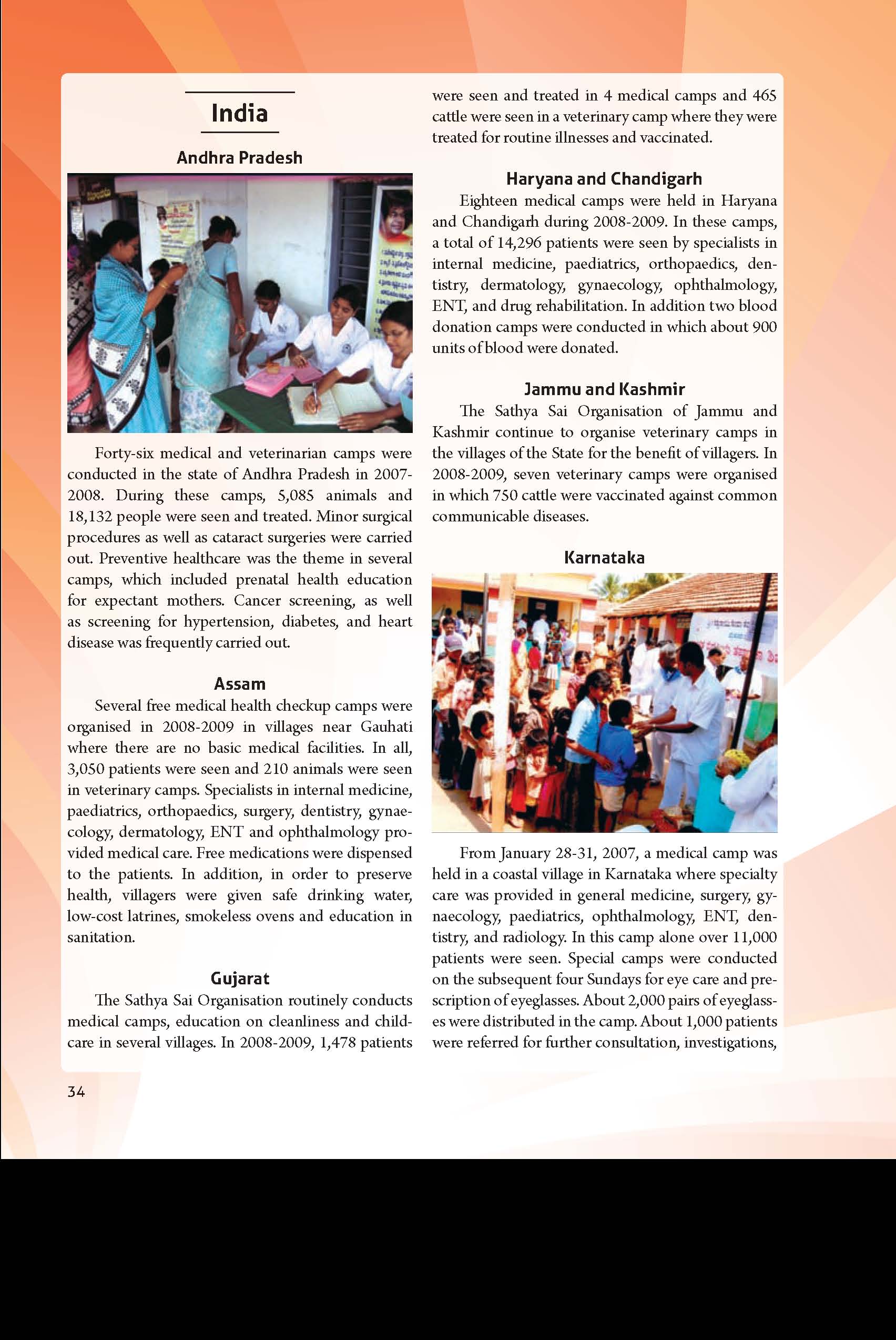
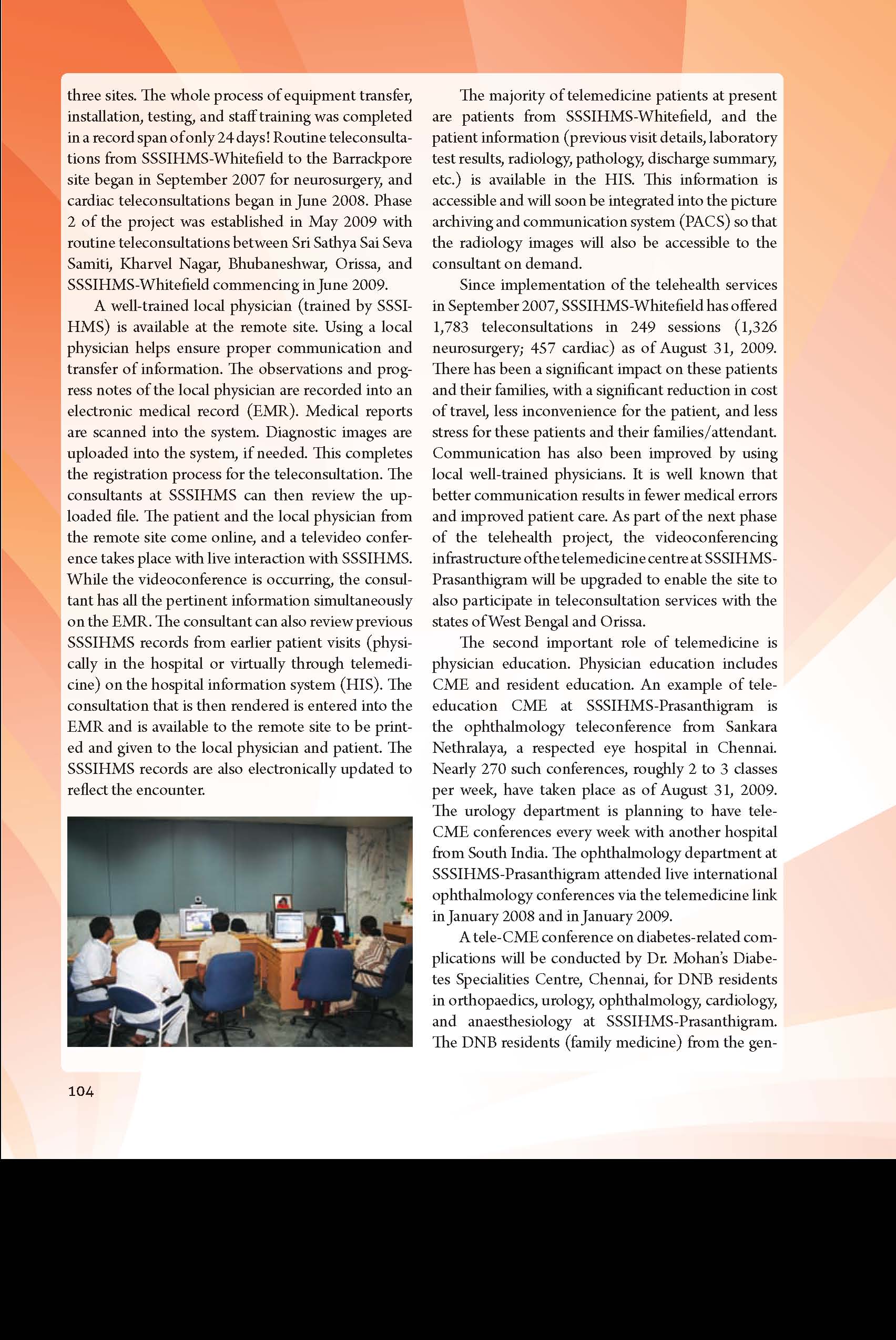
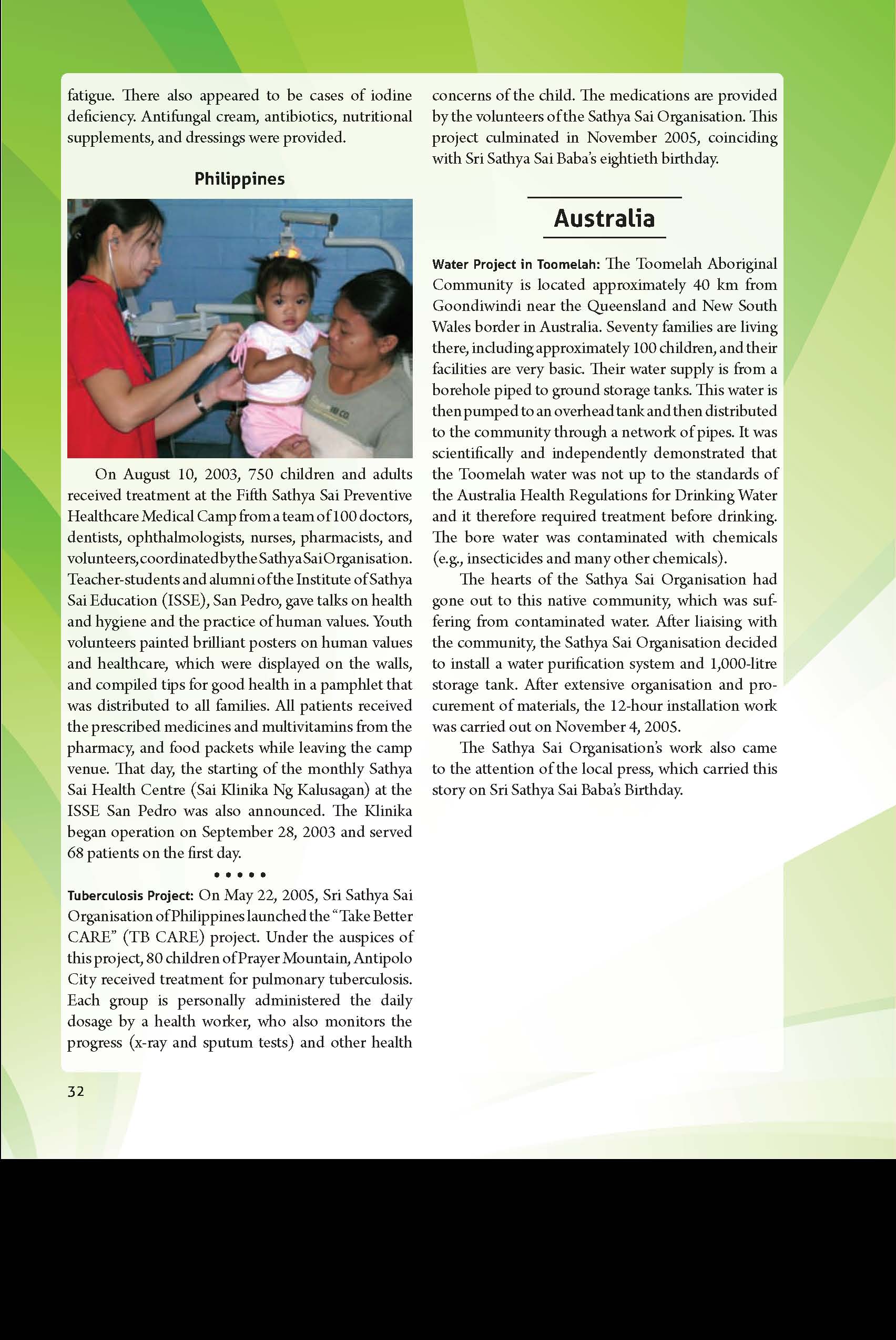
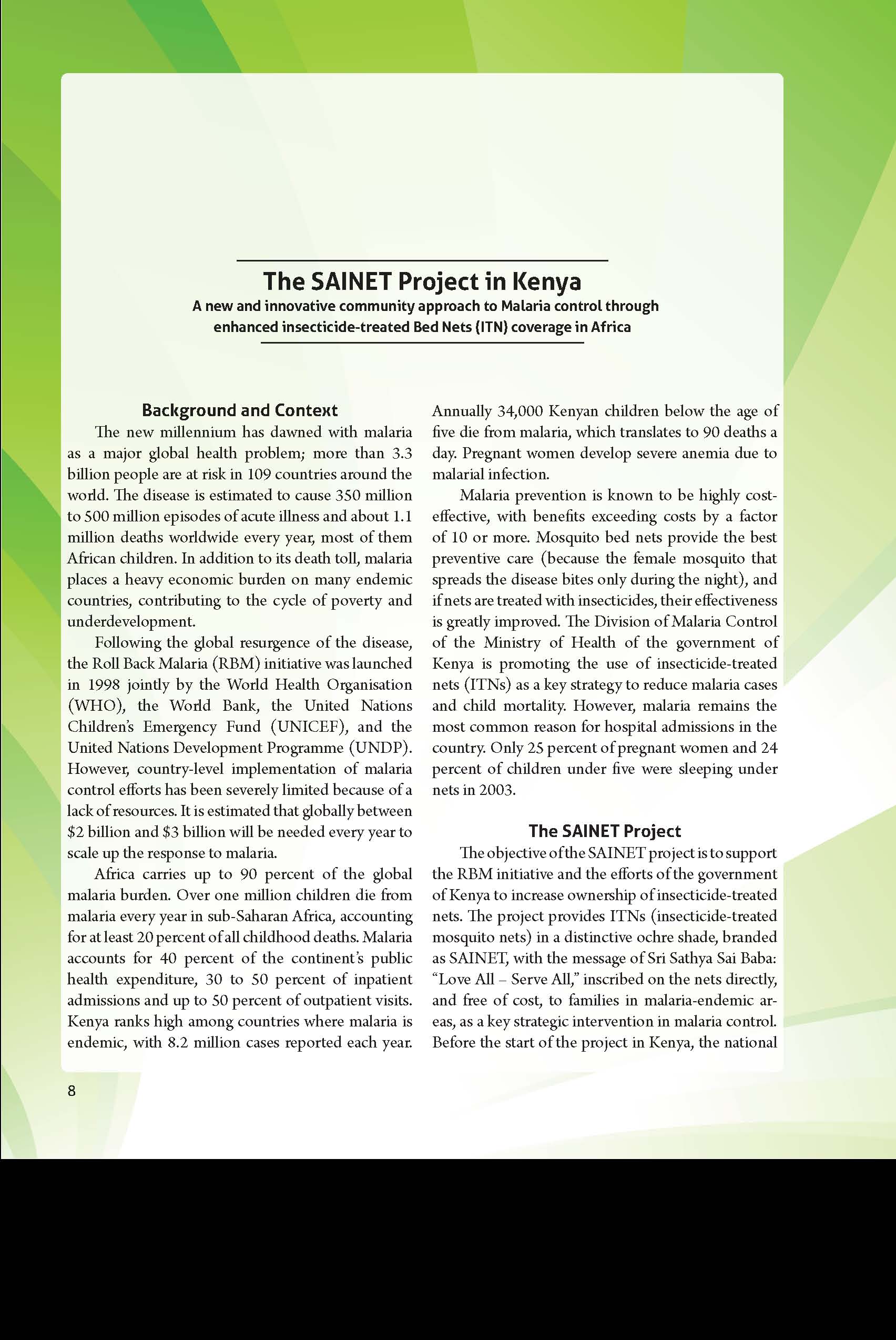
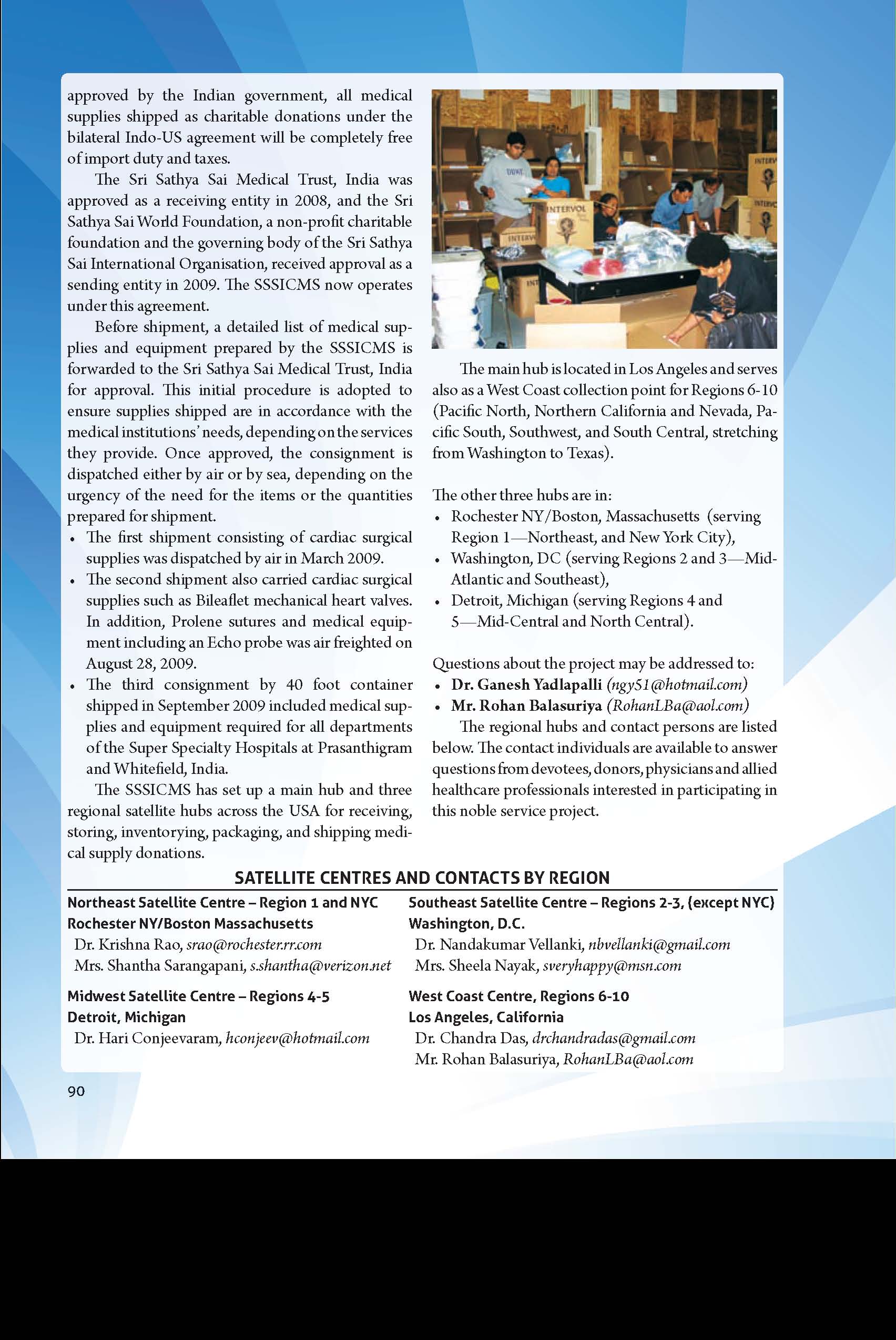
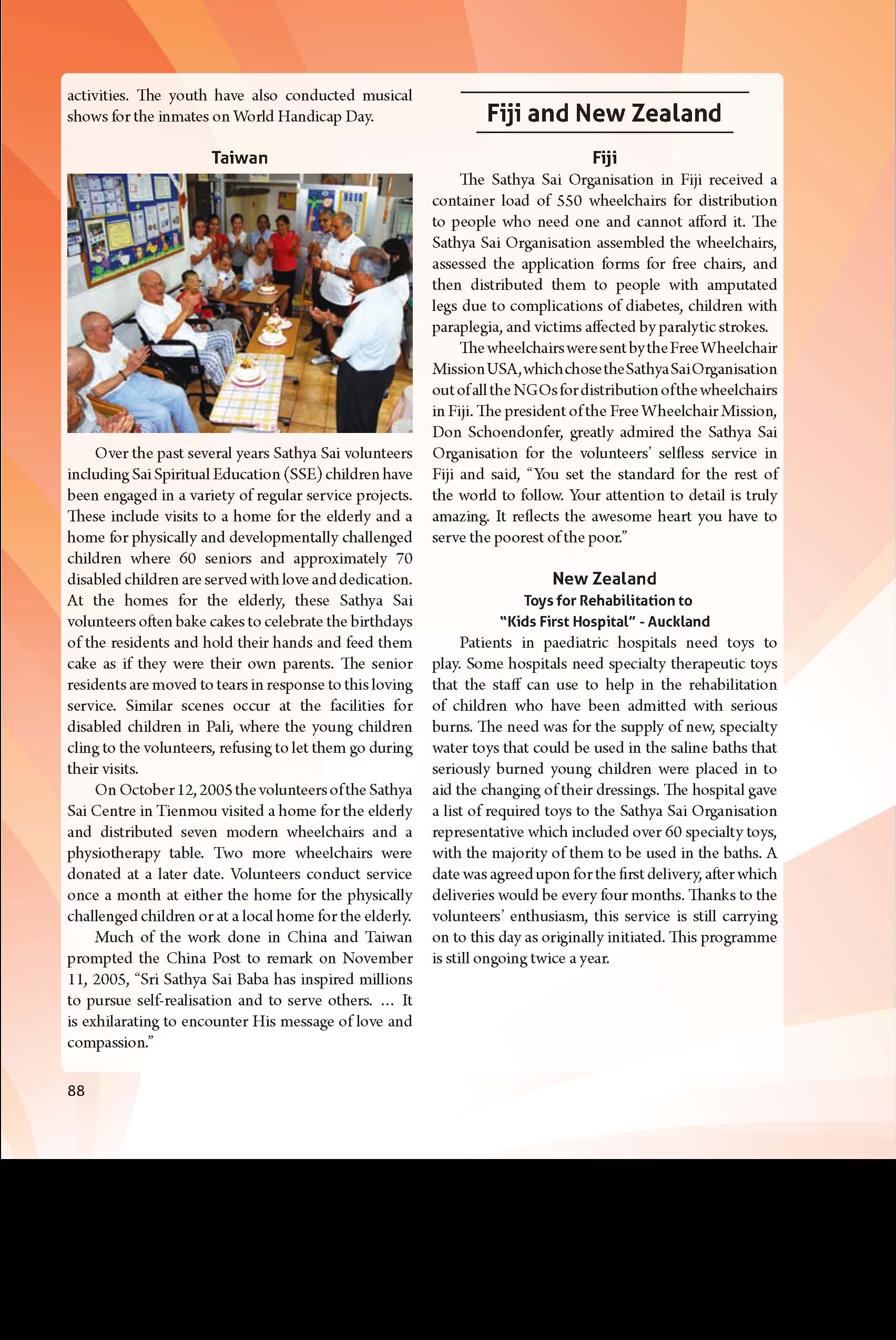
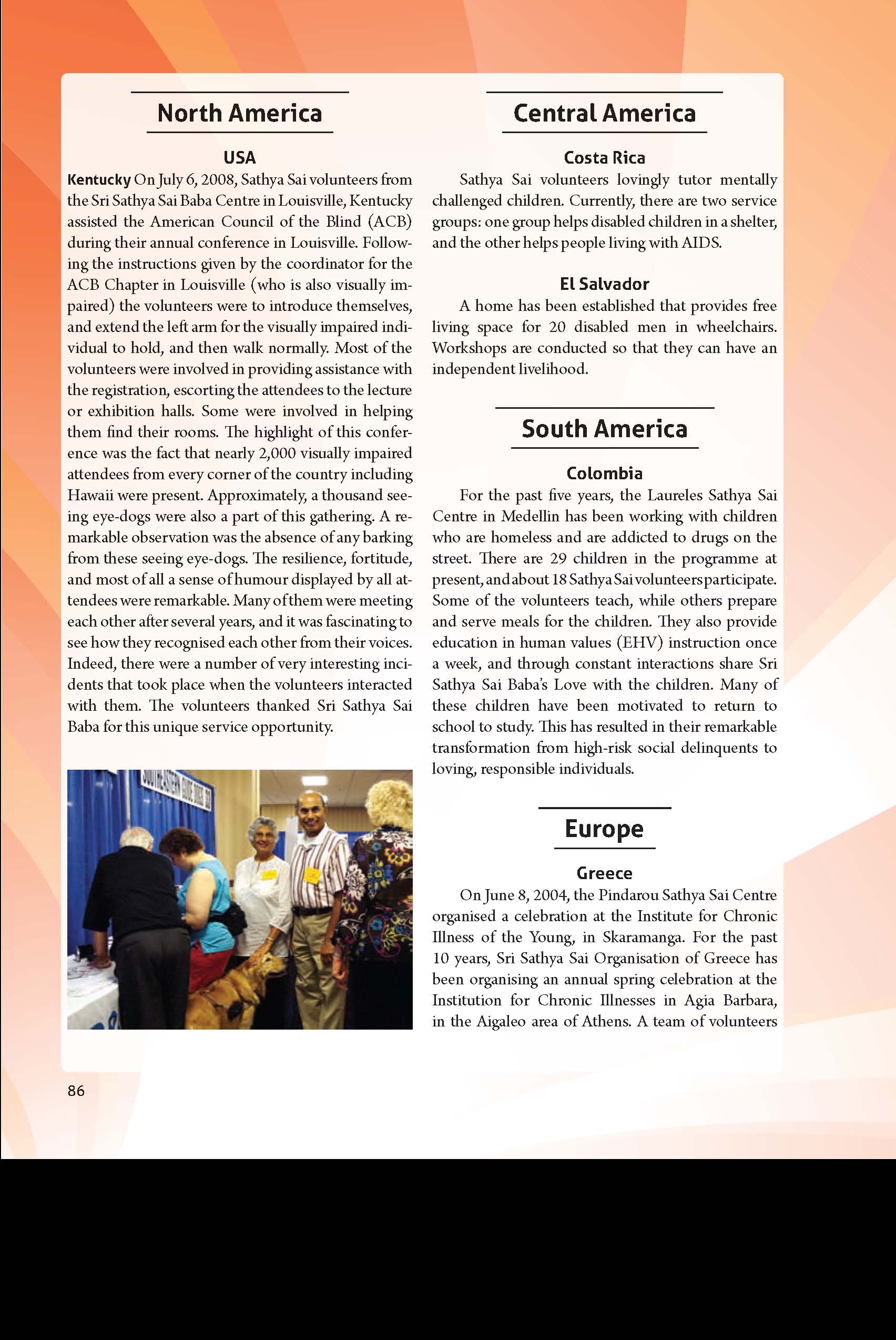

74
73
7
70
69
2
8
33
34
104
103
91
1
90
92
1
2
86
85
89
Sri Sathya Sai Medical Institutions in India:
Crest Jewel of Ideal Healthcare
1
“It is a great good fortune to be able to love and serve the suffering humanity. The Sathya Sai Hospital doctors render service to the patients with noble feelings and purity of heart. With such dedicated doctors serving here, this has become an ideal hospital.”
–Sri Sathya Sai Baba, June, 10, 2001
Sri Sathya Sai Hospitals in India are the heart and soul of the Sri Sathya Sai Global Health Mission. Sri Sathya Sai Baba inaugurated the first general hospital in Puttaparthi, Andhra Pradesh, India, in 1956. In the subsequent decades, the mission in India has grown and now offers secondary and tertiary care through two super specialty hospitals (in Puttaparthi, Andhra Pradesh and Whitefield, Karnataka established in 1991 and 2001, respectively). These modern facilities have taken healthcare to the doorstep of the poor through the mobile hospital initiative (started in 2005) and are providing medical care to millions of people free of cost, irrespective of their financial status, faith, nationality, or religion.
Sri Sathya Sai Hospitals have become role models in communities across the globe. Today there are many hospitals and clinics across the world under the tutelage of the Sri Sathya Sai Organisation with a common goal of providing free healthcare to the needy with love and compassion. “Expansion of Love” by serving the needy with unconditional love, is the key to the Sri Sathya Sai Global Health Mission.
The aim of the Sri Sathya Sai Hospitals is not to merely treat the diseases but to heal the patient. These hospitals are supported by an inspired staff of 1,500 people that includes doctors, nurses, paramedical staff, nutritionists, and several other support services. At any given time, there are about 500 volunteers, from India and all over the world, serving in various capacities in these hospitals.
Below is a brief overview of Sri Sathya Sai Hospitals in Puttaparthi and Bangalore, India.
Sri Sathya Sai General Hospitals
The Sri Sathya Sai General Hospital (SSSGH) in Puttaparthi was inaugurated by Sri Sathya Sai Baba on October 4, 1956. Initially there were only 2 beds, and over a period of time it was expanded to a hospital with 100 beds. More than 4 million patients have been treated since its inception. Under the divine guidance of Sri Sathya Sai Baba, another general hospital was opened at Whitefield, Bangalore, on August 28, 1976. The hospital has grown immensely since its inception and now treats more than 1,000 patients daily. Today both hospitals have general as well as specialty units, namely, general medicine, paediatrics, general surgery, otolaryngology, ophthalmology, dentistry, gastroenterology, obstetrics and gynaecology.
These hospitals have made steady progress as institutions offering high-quality free service to the local and surrounding population. The dedicated and selfless service of the full-time and visiting doctors has resulted in the phenomenal growth of these hospitals. The majority of patients who come for treatment to the general hospitals and super specialty hospitals are from socially and economically weaker sections of society.
Sri Sathya Sai Institute of Higher Medical Sciences (SSSIHMS)
The super specialty hospitals were built to include world-class infrastructure for diagnostic, interventional, and surgical procedures providing comprehensive treatment. The hospital makes every effort to maintain low administrative costs to maximise resources for patient care.
Sri Sathya Sai Institute of Higher Medical Sciences, Puttaparthi, Andhra Pradesh, India
Constructed in a record time of 6 months with a structural area of 153,000 square feet, it is the first super specialty hospital in India to offer world-class tertiary care through state-of-the-art medical technology, totally free of cost. The hospital is equipped with 300 beds, 8 surgical theatres, 6 intensive care units, 2 cardiac catheterisation laboratories, medical and surgical wards, and a 24-hour emergency unit. It has a staff of specialists in cardiology, cardiothoracic and vascular surgery, gastroenterology, urology, ophthalmology, plastic surgery, and orthopaedics. The specialty services provided at the hospital are as follows:
Cardiology• – Transthoracic and Transoesophageal echocardiography, Exercise testing, Holter monitoring, stress echo, adult and paediatric diagnostic and interventional catheterisation, permanent pacemaker implantation
Cardiothoracic and vascular surgery (CTVS)• – A wide range of cardiac surgeries, including congenital and acquired heart diseases (valvular and coronary artery disease), along with numerous non-bypass procedures
Urology• – Urodynamics, urosurgery, endoscopy, extracorporeal shock wave lithotripsy (ESWL)
Ophthalmology• – Corneal surgery, glaucoma, cataract, and Intraocular lens implantation, vitreoretinal surgery, paediatric ophthalmology, UVEA service, ocular oncology, orbit and oculoplasty procedures
Plastic Surgery• – reconstructive surgery, facial blemishes, lesions, congenital malformations, tumour removal, burn surgery, and ulcer removal
Orthopaedics• – trauma, paediatric, total joint replacements, spinal deformity corrections, hand surgery
Gastroenterology• – diagnostic and therapeutic upper endoscopy (EGD) and lower endoscopy (sigmoid/colonoscopy)
Laboratory sciences• – haematology, pathology, microbiology, biochemistry, in-house blood bank
Radiology• – computed tomography (CT), ultrasound (US), x-ray (static and mobile units), nuclear medicine
Sri Sathya Sai Super Specialty Hospital, Puttaparthi
Cumulative Statistics (Nov 1991 – Mar 2009)
|
Specialty |
Outpatients |
Procedures |
|
Cardiology |
818,831 |
25,469 |
|
CTVS |
18,870 |
|
|
Ophthalmology |
401,271 |
38,447 |
|
Plastic Surgery |
9,923 |
3,678 |
|
Urology |
397,575 |
37,339 |
|
Orthopaedics |
29,105 |
3,522 |
|
GI Endoscopy |
1,726 |
|
|
Total |
1,656,705 |
129,051 |
Sri Sathya Sai Institute of Higher Medical Sciences, Whitefield, Karnataka, India
The second super specialty hospital was constructed in Whitefield, Karnataka, in 2001, and it is the first hospital in India to have the image-guided neuro-navigation system for brain surgery. The hospital is equipped with 333 beds, 8 surgical theatres, 6 intensive care units, 2 cardiac catheterisation laboratories, preoperative and postoperative wards, and a 24-hour emergency unit. It is the first tertiary care institution to have a comprehensive post-discharge patient rehabilitation programme with a staff of specialists in cardiology, cardiothoracic and vascular surgery, neurology, and neurosurgery providing the following services:
Cardiology• – Tranthoracic and Transoesophageal echocardiography, Exercise testing, Holter monitoring, stress echo, adult and paediatric diagnostic and interventional catheterisation, peripheral vascular stenting, electrophysiology study, ICD implantation, permanent pacemaker implantation
Cardiothoracic and vascular surgery (CTVS)• – A wide range of cardiac surgeries, including congenital and acquired heart diseases (valvular and coronary artery disease), along with numerous non-bypass procedures
Neurology• – myasthenia gravis, cervical myopathy, muscular dystrophy, carpal tunnel syndrome, epilepsy, dementia, paralysis, delayed development, learning disability, neuropathy, headache, neuromuscular wasting, myopathy
Neurosurgery• – Arterio-Venous malformations/ fistulae Skull-base tumor surgery, posterior fossa lesion, cranio pharyngioma resection, atlanto-axial dislocation, meningioma, sellar/suprasellar lesion, intraventricular lesions, tumour removal, colloid cyst
Laboratory sciences• – haematology, pathology, microbiology, biochemistry, in-house blood bank
Radiology• – computed tomography (CT), ultrasound (US), x-ray (static and mobile units), magnetic resonance imaging (MRI), digital subtraction angiography (DSA)
Sri Sathya Sai Super Specialty Hospital, Whitefield, Bangalore
Cumulative Statistics: January 2001 to March 2009
|
Specialty |
Outpatients |
Procedures |
|
Cardiology |
531,971 |
24,910 |
|
CTVS |
22,198 |
|
|
Neurology |
104,306 |
|
|
Neurosurgery |
153,798 |
159,612 |
|
Total |
790,075 |
206,720 |
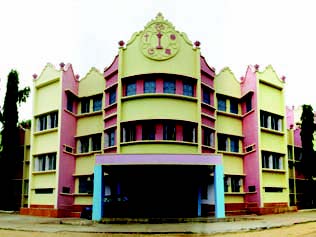
Sri Sathya Sai General Hospital, Puttaparthi
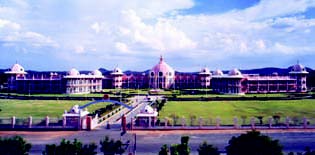
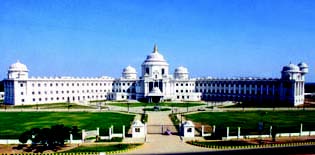
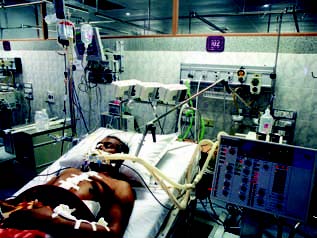
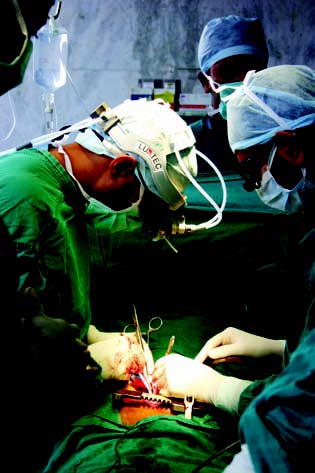
“I have never seen anything like this on Earth... it is a wonderful feeling far removed from the national healthcare in the west which does not seem to work very well...the impressive thing about the Hospital created by Bhagavan Sai Baba is the combination of the three aspects: state-of-the-art technology; free medical treatment and the healing powers of His presence instilling in the patient the firm belief that he/she will get well; this is something I believe Western healthcare would do very well to consider.”
Dr. Michael Nobel,
Chairman of the family society’s board of directors, and
Chairman of the Appeal of the Peace Prize Laureates Foundation.
Preventive Healthcare and Public Health
2
“To improve and maintain the health of the people, continuous education on the principles and practice of hygiene and environmental cleanliness is essential. Education is the most effective safeguard against physical and mental ill-health.”
–Sri Sathya Sai Baba, Aug 28, 1976
The World Health Organisation estimates that if major risk factors for chronic disease were eliminated, at least 80 percent of heart disease, stroke, and type-2 diabetes would be prevented and 40 percent of cancer would be prevented. The choices we make as individuals and as a society have consequences for the world at large. Major risk factors for communicable and non-communicable diseases include alcohol abuse, tobacco smoking, indoor smoke inhalation from solid fuels, air pollution, unsafe sex, poor sanitation, high cholesterol, iron deficiency, being malnourished, low fruit and vegetable intake, high body mass index, and high blood pressure. These risk factors may result in infectious diseases (for example, AIDS, TB, and diarrhoea and dehydration) and non-infectious diseases (for example, cardiovascular diseases, diabetes, and hypertension). Risk factors for health problems vary from place to place; so do the diseases. Although we may have succeeded in decreasing mortality by creating better diagnostics and treatment options for infectious diseases, the morbidity from the burgeoning health burden of these non-communicable diseases is fast approaching the tipping point. Sixty percent of the world’s deaths are attributable to this silent epidemic. These trends, which were initially seen among the developed nations, are now becoming a common sight in the developing world, which is already burdened by infectious diseases in the setting of poverty, illiteracy, and weak health care systems.
There is a growing need within health care systems at large to adopt a paradigm shift towards prevention and promoting healthier lifestyles. The Sri Sathya Sai Organisation has undertaken several public health initiatives such as drinking water projects, health education activities to promote a healthy lifestyle.
The SAINET Project in Kenya
A new and innovative community approach to Malaria control through enhanced insecticide-treated Bed Nets (ITN) coverage in Africa
Background and Context
The new millennium has dawned with malaria as a major global health problem; more than 3.3 billion people are at risk in 109 countries around the world. The disease is estimated to cause 350 million to 500 million episodes of acute illness and about 1.1 million deaths worldwide every year, most of them African children. In addition to its death toll, malaria places a heavy economic burden on many endemic countries, contributing to the cycle of poverty and underdevelopment.
Following the global resurgence of the disease, the Roll Back Malaria (RBM) initiative was launched in 1998 jointly by the World Health Organisation (WHO), the World Bank, the United Nations Children’s Emergency Fund (UNICEF), and the United Nations Development Programme (UNDP). However, country-level implementation of malaria control efforts has been severely limited because of a lack of resources. It is estimated that globally between $2 billion and $3 billion will be needed every year to scale up the response to malaria.
Africa carries up to 90 percent of the global malaria burden. Over one million children die from malaria every year in sub-Saharan Africa, accounting for at least 20 percent of all childhood deaths. Malaria accounts for 40 percent of the continent’s public health expenditure, 30 to 50 percent of inpatient admissions and up to 50 percent of outpatient visits. Kenya ranks high among countries where malaria is endemic, with 8.2 million cases reported each year. Annually 34,000 Kenyan children below the age of five die from malaria, which translates to 90 deaths a day. Pregnant women develop severe anemia due to malarial infection.
Malaria prevention is known to be highly cost-effective, with benefits exceeding costs by a factor of 10 or more. Mosquito bed nets provide the best preventive care (because the female mosquito that spreads the disease bites only during the night), and if nets are treated with insecticides, their effectiveness is greatly improved. The Division of Malaria Control of the Ministry of Health of the government of Kenya is promoting the use of insecticide-treated nets (ITNs) as a key strategy to reduce malaria cases and child mortality. However, malaria remains the most common reason for hospital admissions in the country. Only 25 percent of pregnant women and 24 percent of children under five were sleeping under nets in 2003.
The SAINET Project
The objective of the SAINET project is to support the RBM initiative and the efforts of the government of Kenya to increase ownership of insecticide-treated nets. The project provides ITNs (insecticide-treated mosquito nets) in a distinctive ochre shade, branded as SAINET, with the message of Sri Sathya Sai Baba: “Love All – Serve All,” inscribed on the nets directly, and free of cost, to families in malaria-endemic areas, as a key strategic intervention in malaria control. Before the start of the project in Kenya, the national medical committee of the SAINET project carried out an assessment of the ongoing initiatives for malaria control, including those by UNICEF and NGOs like Public Services International (PSI), African Medical and Research Foundation (AMREF), etc., and had detailed discussions with the director of the Malaria Control Programme of the Ministry of Health. It was observed that although much support was coming to the sector for preventive care, including for increasing ownership of insecticide-treated nets, particularly among high-risk populations, the current level of coverage of ITNs in the country was a meagre 6 percent (for ordinary nets it was about 22 percent). This was well below the target of 60 percent set by the Roll Back Malaria initiative and the Abuja summit. A key reason for this low coverage was the lack of affordability for the poor, particularly in rural areas, to acquire a bed net even at a subsidised price of Ksh. 50 ($0.60). It was also observed that the subsidised voucher schemes followed by most donor agencies were open to abuse and the poor in remote areas were often totally unaware of such schemes.
It was therefore decided that the SAINET project would focus on the following:
Establishing an active partnership with the Malaria • Control Programme of the Ministry of Health with a view to extending its outreach throughout the country.
Free distribution of nets among the poorest and • the most vulnerable.
Direct distribution of nets to end users, using a • community-based approach.
Using a net saturation exercise (100 percent cov• erage) in malaria-endemic areas. Field research by WHO indicates that when 30 to 50 percent of the population use ITNs, 27 percent of the children are protected from malaria and cases of anaemia are reduced by 50 percent.
Emphasis on raising community awareness of • the effectiveness of ITNs, their maintenance and use, and local environmental management (e.g., clearing stagnant pools of water).
Active follow-up and periodic revisits to the • served communities to ensure heightened level of awareness, including retreatment of nets (where necessary), monitoring of impact, etc.
Implementation steps
Assessment visits to selected villages and distribu• tion of SAINET vouchers by Sri Sathya Sai Organisation to every family through district administration two weeks ahead of service.
District administration • sets up distribution centres (average 10 to 15 for every service) in primary schools, churches, community centres, etc.
Travel during week• ends by project team (100 to 150 Sathya Sai volunteers) to distribution area along with truckloads of SAINETs, maize meal, and community-awareness bulletins.
Full-day distribution of SAINETs and community-• awareness skits for use and maintenance of nets held. Each family gets up to three SAINETs, depending on family size; most distribution services also provide 4 kg of maize meal to every family. District medical team and senior administration officials participate during each distribution.
Return of volunteers the following day. Each • service is conducted during a weekend over a two- to three-day period (Friday through Sunday).
Project Achievements
At the request of the Malaria Control Programme, the Namanjalala location in Trans-Nzoia district in Western Kenya was selected for the first SAINET distribution service. The chief guiding factors in selection were the remoteness of the area and widespread poverty, a high incidence of malaria (at least three children die every month in each village after the rains), and the area is not yet covered by any other donor agency.
After careful planning and preparation, the SAINET project conducted its first distribution service on June 11, 2005, covering a population of 16,800 in 2,200 households in 20 villages. Each family received, free of cost, two SAINETs and 4 kg of maize meal, the staple food in this area. Awareness-raising sessions were held in each village to inform the people about the use and maintenance of nets and the local environment. A total of 95 Sathya Sai volunteers came from different parts of Kenya to conduct the service. Five convoys, each comprising a Canter truck, a minibus, and two to three four-wheel-drive vehicles carried 12 tonnes of food supplies and 4,400 SAINETs to the remote villages. The distribution service was inaugurated by the assistant minister and M.P. of the area and was attended by the full complement of district medical and public health authorities.
The Namanjalala service was the first ever in Kenya to make available ITNs free to the poor on a significant scale to create a measurable health impact. Also, this was the first time that an almost 100 percent coverage of the 20 villages was achieved, using a community-based approach to reach the poor directly, using the principle of Grama Seva (serving the poor in villages) introduced by Sri Sathya Sai Baba in India. The medical faculty of the University of Nairobi and the government of Kenya have jointly initiated a research project to monitor the impact of this unique service among the population in 20 villages.
Following the highly successful first service, the Malaria Control Programme of Kenya requested the SAINET project to undertake service in all major malaria-endemic regions of the country.
The distribution service was gradually scaled up, and the largest single distribution service took place on October 22, 2005, when 20,500 nets were distributed to a population of 91,000 in the malaria-infested Kilifi district of coastal Kenya.
“Sai Ram, I have just discovered that you are truly a genuine brother, kind in heart and having the spirit to give and serve all with love. Let me take this opportunity to thank you and the SATHYA SAI ORGANISATION for the kind gesture extended to the people of Kilifi, and specifically to Bamba, the poorest constituency in Kenya. Surely, you have reached the poorest of the poor. By giving a net you have given a life.”
–Dr. P. Masaulo, District Medical Officer of Health of Kilifi, on January 3, 2006
By April 2006, Sri Sathya Sai Organisation in Kenya had distributed a total of 85,000 SAINETs, providing protection from malaria to 500,000 poor and vulnerable people in all malaria-endemic regions of Kenya.
Impressed by the performance of the SAINET project, the government of Kenya sought the services of Sri Sathya Sai Organisation in Kenya to distribute an additional 40,000 ITNs supplied by the Global Fund to a population of 91,000 in Lamu island off the coast of Kenya.
Lessons Learnt from the SAINET Project
An epidemiological study on the impact of SAINET • distribution on the incidence of malaria episodes was conducted in Kenya jointly by the Kenya Health Department and the University of Nairobi. The study revealed a drastic drop (by more than 50 percent) in the number of malaria episodes in the distributed areas measured through hospital admissions, outpatient registration, and primary school attendance.
The SAINET project’s approach to distribute nets • by Sathya Sai volunteers to poor villagers directly without any intermediary proved to be most effective in reaching the poor.
The SAINET project in Kenya was the first initia• tive in Africa that validated several key recommendations of the United Nations Millennium Task Force on Malaria (Coming to Grips with Malaria in the New Millennium: UN Millennium Project Task Force on HIV/AIDS, Malaria, TB, and Access to Essential Medicines, Working Group on Malaria, 2005):
Free (rather than subsidised) provision of in1. secticide-treated nets to the poor should be a policy priority for all donors in Africa.
In malaria-endemic areas 100 percent coverage 2. (rather than targeting high-risk groups only) is essential for sustained malaria control.
Social partnerships between health sector 3. authorities and faith-based organisations are important in widening healthcare outreach to the poor.
The SAINET project in Kenya presented a new model of preventive healthcare service for Sathya Sai Organisations, which would be replicated with success elsewhere in Africa and in other regions (notably in Lao PDR in southeast Asia and Gujarat in India). The model was characterised by the following:
Addressing a national health problem•
Establishing a synergic partnership with the • government at national, state, and district level early on, based on mutual strengths and advantages
Conducting service at a significant scale that could • create a measurable impact and earn national recognition
Above all, sharing of selfless love by the Sathya Sai • volunteers with the poor and vulnerable in most remote areas of Kenya and spreading the message of “Love All – Serve All.”
“Since independence, no body has come to help us in this way”
–Chief, Nyangama Division, during SAINET Service on 27 August 2005 in Bondo, Nyanza Province (Kenya)
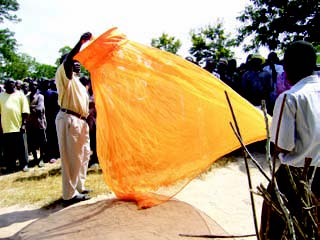
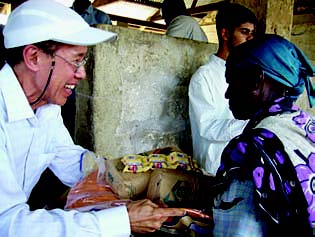
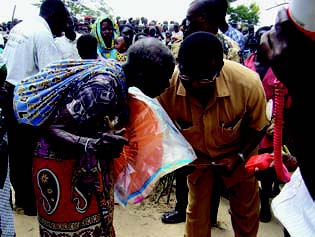
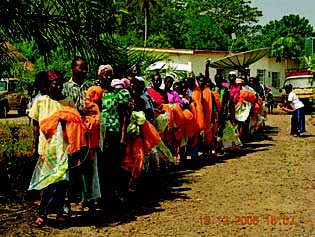
Human Values–Based Water Education Programme
He who knows the source of water
Becomes established in himself
—Mantra Pushpam in Yajur Veda
Life is Water, do not waste a drop
—An Ancient Proverb
Why Water Education?
Though 70 per cent of the earth’s surface is covered with water, only 3 per cent is fresh water. Of this 3 per cent, only 1 per cent is available for use. Meanwhile, the world’s population continues to grow from 3 billion in 1960 to 6 billion in 2000 and is expected to reach 9 billion by 2050. Over 1.2 billion people in the world today lack access to safe water supply and over 2.4 billion people lack access to adequate sanitation.
The poor pay dearly for water and cut back on consumption, often relying on as little as 10 litres per head per day to survive, while the rich may use as much as 250 litres. Diarrhoea, resulting principally from lack of water and poor sanitation causes 1.8 million deaths/year, mostly amongst children under the age of five. This is estimated to be about a third of total child deaths under the age of five in developing countries.
There is a growing understanding that only a fundamental change in behaviour and personal attitudes can reverse this situation. Water education can play a strategic role in bringing about positive attitudinal changes among both water consumers and providers, and in the longer term, can help develop a new water-use ethic in society. Children and youth could be the best ambassadors to bring about these attitudinal changes.
A Unique Human Values-based Water Education Programme
The UN Charter is replete with values such as equality, freedom, peace, and solidarity, yet the world organisation was seeking a practical way of translating values into its many-faceted developmental efforts. The opportunity came when, in a bold move, a group of international experts convened by the United Nations (UN-HABITAT) in South Africa in 2001, working together with the African Institute of Sathya Sai Education (ISSE-Africa), unanimously adopted a human values–based approach to introduce water education in Africa.
Human values–based water education is an innovative approach that not only imparts information on water, sanitation, and hygiene, but also inspires and motivates learners to change their behaviour and make wise and sustainable use of water. The values-based approach seeks to bring out desirable human qualities, which could help in making desirable choices in water resource management. Nurturing values such as honesty, integrity, tolerance, responsibility, sharing, and caring in children during their formative years helps them to become caring and responsible citizens in the future.
The following years would see African educationists—teachers, curriculum specialists, and educational administrators—in a growing number of countries, such as Cote d’Ivoire, Burkina Faso, Ethiopia, Ghana, Kenya, Senegal, Tanzania, Uganda, and Zambia, enthusiastically embracing human values through the United Nations water education programme. ISSE-Africa played a key role in training African educationists from across the continent in imparting education in human values.
Following an independent evaluation of the programme conducted in 2004, the programme has been further extended to five more African countries in the second phase, bringing it to a total of 14 countries.
The success of the programme in Africa generated interest in human values-based water education in other regions as well. In December 2003, UN-HABITAT and the Asian Development Bank jointly organised a Regional Consultation in the Asia-Pacific region on Values-based Water Education in cooperation with the Institutes of Sathya Sai Education in the Philippines and Thailand. Among the participants were senior educationists from Australia, Brunei Darussalam, People’s Republic of China, India, Indonesia, Japan, Kazakhstan, Cambodia, Lao PDR, Malaysia, Mauritius, Nepal, Pakistan, Papua New Guinea, the Philippines, Singapore, Sri Lanka, Thailand, Uzbekistan, and Vietnam. Since then the human values-based water education programme has become operational in the Asia-Pacific region.
The governments of Norway, Sweden, and a number of other countries are supporting this UN-HABITAT–implemented programme. More recently, the Asian Development Bank and the South East Asian Ministers of Education Organisation (SEAMEO) have joined their support for the programme.
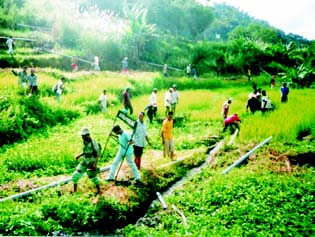
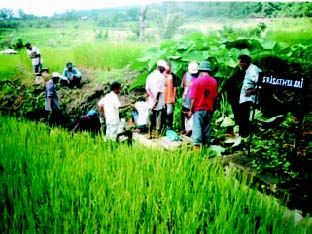
IDEAL HEALTH CARE: A Focus on Preventive Care
Sri Sathya Sai Baba has inspired millions with His teachings of unity, love and service and has provided a vision for ideal healthcare based on five specific principles: universal, free, loving and comprehensive care with a focus on prevention. Guided by these principles, He has established a comprehensive medical care delivery organisation, including some of the most advanced super specialty hospitals in the world. In doing so, He has provided an exemplary model which we can follow to structure and deliver care in our local communities. This guidance is being provided at a most opportune time, when the number of patients with access to high quality care is plummeting despite rapidly escalating costs of care, when the issue of iatrogenic injuries is increasingly recognised, and when nations, such as the United States, are deeply engaged in national policy discussions about health care reform. Collectively, healthcare professionals need to understand and learn from this model in order to become positive forces in assisting their patients, communities and countries in achieving ideal health care.
Sri Sathya Sai Baba has increasingly emphasised preventive health care. Preventive health care falls into three categories: primary, secondary and tertiary prevention. Primary prevention includes those activities to protect against disease (e.g., hand hygiene and immunisations) and to promote health (e.g., adequate prenatal care or good nutrition). Secondary prevention aims to identify and detect disease at its earliest stages, thereby optimising the chances of successful treatment. Secondary prevention is the goal of much preventive health tests, such as diabetes screening and mammograms. Finally, tertiary prevention aims to improve the quality of life for patients with disease (e.g., appropriate glycemic control for diabetic patients).
In the case of rheumatic heart disease, for example, primary prevention is appropriate antibiotic treatment of streptococcal pharyngitis to limit the development of acute rheumatic fever; secondary prevention is early detection and treatment of acute rheumatic fever including appropriate prophylactic antibiotics and treatment of subsequent streptococcal infections; and tertiary prevention is appropriate treatment of rheumatic heart disease to mitigate potential complications and disabilities.
Ideal healthcare focuses on preventive care to improve the overall health of populations, rather than solely the treatment of acute episodes of illness or disease. Sri Sathya Sai Baba has said, “Instead of treating people after the onset of disease, it is better to ensure that they do not fall ill at all.” Therefore, He emphasises the importance of various aspects of preventive care including: diet, hygiene, immunisations, cardiovascular and diabetes prevention, prenatal care, and spiritual discipline.
Sri Sathya Sai Baba has said, “By regulating your diet and avoiding certain bad habits, you can preserve health. Moderate food of the sathwic (pure) type, will promote mental poise and also physical happiness. Mitha-ahaara (moderation in food) is always to be welcomed.” Today, dietary indiscretions are the cause of a multitude of medical problems internationally. In 2005, the World Health Organisation estimated that 1.6 billion adults were overweight and 400 million were obese. Once a problem of only the wealthy, obesity has rapidly become a central health care issue for people everywhere. Of particular concern, poor dietary habits are established earlier and earlier with 20 million children under the age of 5 overweight in 2005. Obesity can lead to many chronic diseases, particularly cardiovascular disease, diabetes, musculoskeletal disorders, and increases the risk for some types of cancers.
Another important aspect of preventive care is hygiene. According to the ancient proverb, “Cleanliness is next to Godliness.” Clean food, water, hands, environment, and thoughts are critically important in facilitating good health. Sri Sathya Sai Baba has said, “Oral hygiene is not cared for. The mouth is the gateway of the physical mansion; if the gateway is foul, what can we say of the residence and inmates!” Food and waterborne diarrhoeal illnesses are rampant and often preventable across the world, particularly in developing countries. Sri Sathya Sai Baba has undertaken extensive water projects throughout India which has brought water to more than 10 million people. These projects have inspired people in countries throughout the world to embark on water projects in their own communities.
A vital component of preventive medicine is immunisation. Vaccines have been developed to protect against a variety of diseases, averting an estimated 2 million deaths globally in 2002. One of the greatest immunisation successes has been the worldwide eradication of smallpox. Routine vaccination for polio, diphtheria, tetanus, pertussis, mumps, rubella and measles is now available. Also available are immunisations against hepatitis A and B, Haemophilus influenzae type B, rotavirus, pneumococcus, influenza virus, meningococcus, human papillomavirus (HPV), and varicella. However, people are still suffering from vaccine preventable diseases. For example, despite the availability of the polio vaccine there continues to be flares in Asia and Africa as a result of a failure to vaccinate. Emphasising the importance of vaccinations continues to be a crucial role of medical providers.
Cardiovascular disease is the most common cause of death worldwide, representing 30% of all global deaths with an estimated 17.5 million deaths in 2005. Over 80% of these deaths occur in low and middle income countries. Sri Sathya Sai Baba frequently states that heart disease is caused by “Hurry, Worry, Curry.” With these three simple words, He summarizes what can take hours for talented physicians to explain to patients. Condensing advice into small, catchy phrases facilitates creating an actionable and hopefully indelible memory in the recipient. As health professionals, we too can strive to impart preventive care information in clear, simple language that the patient can understand, thereby increasing the likelihood of them incorporating and adhering to it.
Another important chronic disease is diabetes, affecting 180 million people worldwide and resulting in 1.1 million deaths in 2005. The incidence of diabetic deaths is estimated to increase 50% over the next ten years. Adult onset diabetes is another illness that can be prevented through modulation of diet and exercise. Early diagnosis of diabetes is critical to effective management, with recent studies indicating that age, gender, family history of diabetes, history of hypertension, obesity, and physical activity are all associated with undiagnosed diabetes. Sharing this information with patients can empower them to improve their health.
Sri Sathya Sai Baba particularly emphasises the treatment of expectant mothers and the need for good prenatal care. In one discourse He stated, “My opinion is that mother and child care should be given top priority.” According to United Nations Children’s Fund (UNICEF), “At least 20% of the burden of disease in children below the age of 5 is related to poor maternal health and nutrition, as well as quality of care at delivery and during the newborn period.” Insufficient care during pregnancy and delivery results in many avoidable maternal and child deaths and disabilities. In South Asia, for example, approximately 1/3 of pregnant women receive no prenatal care. Preventable diseases such as iron-deficiency anemia, malaria, HIV and tetanus cause maternal and neonatal deaths in developing nations. Therefore, improving the health of the mother and child through education and increased access to preventive care is essential.
In promoting preventive healthcare, there has been an increasing international movement to deliver patient-centred or family-centred care. In the United States, “patient-centred medical homes” are being promoted as new health care delivery models to improve the quality of care. In these models, the patient participates in medical decision-making, thus allowing them to become an integral part of the healthcare team. They are taught to take responsibility for their own health and are given the tools and support to do so with an emphasis on comprehensive primary and preventive care.
The Institute of Medicine, a non-profit organisation of the National Academy of Sciences serving as an advisor to the U.S. to improve health, defines patient-centred care as, “providing care that is respectful of and responsive to individual patient preferences, needs, and values, and ensuring that patient values guide all clinical decisions.” In other words, patient-centred care emphasises the importance of treating patients with love and respect. Sri Sathya Sai Baba has stated that the aim should be to heal the patient in body, mind and spirit, not merely to treat disease. Physicians need to treat the person with a medical condition, rather than treating only the medical condition itself.
When appropriately employed, health information technology (health IT), including electronic health records, electronic prescribing and telemedicine, can greatly facilitate our ability to provide high quality and safe care. Sri Sathya Sai Baba states that we should, “Help Ever–Hurt Never.” Yet, it is well documented that well-intentioned health care professionals across the world cause significant morbidity and mortality to patients, particularly to the very young and sickest of patients, as a result of preventable medical errors. One commonly cited statistic from the Institute of Medicine estimates that there are between 44,000 to 98,000 deaths each year in the U.S. from errors made in health care. Statistics from other countries paint a similarly dire picture.
Health IT can assist healthcare professionals in making correct and safe medical decisions. Whether it is the provision of computerised decision support that averts a drug-drug interaction or a telemedicine consult that facilitates a correct diagnosis, health IT is a powerful tool to assist us in providing ideal health care. Electronic prescribing systems have been demonstrated to markedly improve the safety and quality of health care, reducing medical errors as much as eight-fold. Of course, over-reliance on health IT and poorly designed applications can result in unintentional harm to patients. Therefore we must focus on the guiding principles of ideal health care and use health IT as a tool to support those principles rather than as an end onto itself.
Finally, and perhaps most importantly, Sri Sathya Sai Baba emphasises the importance of spiritual discipline in ensuring health. “The greatest disease (or absence of ease) is the absence of santhi (peace); when the mind gets peace, the body also will have health. So everyone who craves for good health must pay attention to the emotions, feelings and motives that animate the individual. It is proven that when one is full of positive feelings like love, compassion, forgiveness and forbearance and is bereft of negative emotions like anger, hatred and jealousy both physical and mental health improve remarkably. Swami Vivekananda said, ‘You should have nerves of steel and muscles of iron.’ That is to say, you should have hope and joy as an unshakeable resolution, not despair and dejection.”
In summary, it is paramount that healthcare professionals focus more on preventive healthcare and health education in order to improve the health of our patients, our communities and our nations.
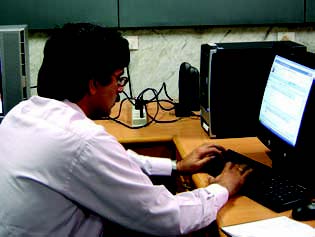
The Challenge of Global Epidemic of Obesity and Type 2 Diabetes
As we enter the year 2010 there is growing alarm from many nations and international health agencies on the increasing global rates of obesity and its associated adverse health consequences. The World Health Organization (WHO) estimates that there are more than 1 billion overweight adults in the world, mostly in developing nations, and often coexisting with undernutrition. There are 300 million obese adults (Body Mass Index (BMI)>30) with a greater proportion of these being women. In the USA, obesity rates are now staggering, with two-thirds of the population overweight or obese and the rates exceeding 20% in 49 states. A recent review of the National Health and Nutrition Examination Survey data by King, et al showed that the adoption of a healthy lifestyle has declined in the USA with reduced vegetable and fruit intake, increased alcohol consumption and less physical activity.
Of concern are the rising rates of obesity in children and adolescents which increase the need to intervene early in life. A number of studies have now shown that obese children become obese adults, placing greater responsibility on adopting a proper healthy lifestyle at home. Obesity is associated with an increased risk for coronary artery disease, type 2 diabetes, cancer, hypertension, dyslipidemia, stroke, biliary and hepatic disease, obstructive sleep apnea, pulmonary dysfunction, and osteoarthritis. Recent studies show that obese children as young as 12 years of age have signs of the metabolic syndrome that increases the risk of diabetes and heart disease. Heart disease is the leading cause of death in men and women with 47% dying before they reach the hospital. In addition there is the mental stress from societal stigma and depression from being overweight that impacts ones overall quality of life. Healthcare professionals also need to treat these patients with love, compassion, and dignity.
The causes of increasing obesity are complex and involve both genetic and environmental factors. The regulation of appetite and energy expenditure involves an intricate interaction of various neuropeptides, adipokines, cytokines, intestinal hormones, the sympathetic nervous system, insulin, access to food, and the quality of food. WHO lists economic growth, modernisation (especially new technologies), urbanisation (more than 50% of the world population now live in urban areas) and globalisation of the food markets as potential factors. There is also a clear relationship between the level of education or socioeconomic status and the prevalence of obesity. Sedentary lifestyles and consumption of energy dense foods, high in saturated fats and sugars play an important role. Obesity is now mainly blamed on overeating rather than inactivity. However exercise is an important part of maintaining a healthy lifestyle. It is now clear that our lifestyle is leading to obesity and diabetes, and these issues need to be addressed if we are to combat the problem.
The prevalence of diabetes has been correlated all over the world to the rates of obesity. This is mainly with type 2 diabetes, which is caused by the dual defects of insulin resistance and beta cell dysfunction. While genetic factors are important in causing insulin resistance, it is central or visceral obesity that is emerging as a major factor. This type of visceral fat is metabolically active, producing many adipokines, cytokines and hormones that affect insulin sensitivity and cause inflammation. In general the Asian population has a lower BMI but also more visceral fat, so that an individual BMI cannot assess risk. There are now different BMI values used to assess obesity between different races.
Diabetes is associated with major microvascular and macrovascular complications. It remains the leading cause of new onset blindness, renal disease, peripheral vascular disease and the major cause of cardiovascular disease. While new therapies are being developed to treat high blood glucose (together with proper nutrition and physical activity) the rate of diabetes is rising very rapidly and the cost of care cannot be sustained even in developed nations. Driving this epidemic are the increasing rates of obesity globally.
Therefore the prevention of diabetes is a better strategy given the results of trials such as the Diabetes Prevention Program of the NIH and The Finnish Diabetes Trial. These studies show that lifestyle changes in combination with healthy diet, weight loss of 7-10% of body weight, exercise and awareness counseling can reduce progression from pre-diabetes to diabetes by 58%. A more recent study from Finland showed that implementing these approaches also worked over a three year period to reduce diabetes progression in a community setting.
What is required is a change in lifestyle that starts with individuals and families, their communities, nations as well as governmental agencies, non-governmental organisations (NGOs) and industry. Lifestyle covers all aspects of a person, including physical, emotional, mental and spiritual well being. The challenges are enormous on a global scale but we need to start locally. Sri Sathya Sai Baba emphasises the important role of the mind in everything we do, hence the injunction to start with the right thought from the beginning. He says good thoughts lead to good physical and mental health. Our thoughts are affected by the foods we eat.
Healthcare professionals in the Sri Sathya Sai Organisation can start by increasing the awareness of devotees at weekly meetings by educating them on the importance of a healthy diet and exercise in combating the obesity and diabetes problems. Hands-on demonstrations of healthy food choices and preparation can be held. Children must be taught these lifestyle changes at home, therefore parental involvement is imperative. The Sai Educare initiatives can also address these lifestyle issues and get the children to adopt a healthy lifestyle. Reducing access to sugary drinks, saturated fat, deep fried foods and snacks and making sure that breakfast is eaten with regulated meal times also helps. Individuals who skip breakfast are more likely to gain weight. The approach has to be flexible and practical taking into account cultural preferences and available resources. Recent studies also show that overall caloric intake is more important in a weight loss programme than the current preoccupation with various macronutrient compositions in different diet plans. Decreased caloric intake combined with increased physical activity is crucial. Upon diagnosis of diabetes, it becomes important to screen other family members, especially in genetically predisposed ethnic groups such as East Indians, Asians, Hispanics, Pacific Islanders, Native Americans and African Americans. Identifying someone with pre-diabetes is an opportunity to implement the lifestyle changes needed to reduce progression to clinical diabetes. Screening can be done by referring the individual to a physician or a healthcare facility. Those who have diabetes also should be counseled to follow their treatment plan and see their health care provider regularly for follow-up and complication prevention.
The global problem of obesity and diabetes will require a new mindset on the inherent value of a human being, the creative potential of each individual, and values such as truth, right action and love. Nations and their governments, international health organisations, public health departments and the multinational food industry all need to come together if we are to make progress. Not only is access to healthy food an issue, but socioeconomic factors, political factors, and resources used by nations need to be addressed. This type of global consensus is slowly gaining momentum but in the meantime we must treat one individual at a time with love, care, and compassion.
Selected References
King DE, Mainous AG, Carnemolta M and Everett CJ. 1. Adherence to Healthy Lifestyle Habits in US Adults 1988-2006.American Journal Of Medicine 2009; 122 (6): 528-534
James PT, Leach R, Kalamara E and Shayeghi M. The 2. Worldwide Obesity Epidemic. Obesity Research 2001; 9 Suppl4: 228S-233S
Patel RB, and Burke TF. Urbanization- An Emerging 3. Humanitarian Disaster. NEJM 2009; 368 (8) 741-743
US Obesity Trends. CDC: Obesity and Overweight for 4. Professionals: Data and Statistics. Accessed online on July 30, 2009 at: www.cdc.gov/obesity/data/trends.html
McNeely MJ and Boyko EJ. Type 2 Diabetes Prevalence 5. in Asians.Results of a national health survey. Diabetes Care 2004; 27: 66-69
Kershaw EE and Flier J. Adipose tissue as an Endocrine 6. organ. JCEM 2004; 89 (6): 2548-2556
ADA. Position Statement on Diagnosis and Classifica7. tion of Diabetes. Diabetes Care 2009; Supp1: S62-S67
Diabetes Prevention Program. Accessed online on 8. September 20, 2009 at: www.diabetes.niddk.nih.gov/dm/pubs/preventionprogram
Absetz P, Oldenburg B, Hankonen N et al. Type 2 Di9. abetes Prevention in the Real World. Diabetes. Three-year results of the GOAL Lifestyle Implementation Trial.Care 2009;32 (8): 1481-1420
Katan MB. Weight-Loss Diets for the Prevention and 10. Treatment of Obesity. NEJM 2009;360(9): 923-925
Sacks FM, Bray GA, Carey VJ, Smith SR et al. 11. Comparison of Weight-Loss Diets with Different Compositions of Fat, Protein and Carbohydrates. NEJM 2009; 360(9): 859-873

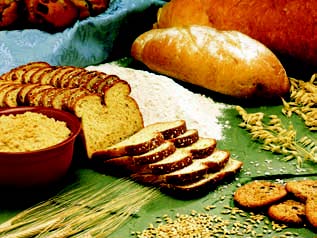
PREVENTION OF CERVICAL CANCER: Effective Screening in the Community
Cervical cancer is caused by infection with human papillomavirus (HPV). It takes 10 to 20 years from the time of initial infection for this cancer to develop. That gives us 10 to 20 years to pick up and easily treat precancerous lesions and prevent suffering. Over 290,000 women needlessly die of this disease yearly, and 80 percent of these deaths occur in the developing world. However, cervical cancer is a preventable disease with screening and treatment.
In 2005, the World Health Organisation (WHO) stated that there are approximately 125,000 cases of cervical cancer per year in India, with over 70,000 deaths. An article in the Journal of the American Medical Association indicated a 2 percent to 4 percent lifetime risk in Indian women.
The International Agency for Research on Cancer demonstrated that a low-cost, low-technology, and easy-to-teach procedure called VIA (visual inspection of the cervix with acetic acid) had sensitivity and specificity comparable to Pap smear screening. Additional studies demonstrated that healthcare workers (physicians, midwives, nurses, medical officers, etc.) could be trained in this technique and that treatment of premalignant lesions with cryosurgery or LEEP (loop electrical excision procedure) could be accomplished in a single visit.
PINCC (Prevention International: No Cervical Cancer) is a programme that trains local providers in these screening and treatment techniques that had been investigated and supported by WHO. The Sri Sathya Sai Mobile Hospital (SSSMH) provides the ideal infrastructure for the PINCC training that teaches the gynaecologists of the mobile hospital team to screen and treat the village women. Over time, and with regular use of VIA, the hope is that the incidence and burden of cervical cancer, the most common cancer among women in India, would decrease in the areas served by the SSSMH. Dr. Narasimhan, director of the Mobile Hospital recognised that such a service would be consistent with Sai ideal healthcare. In August 2009, the first visit by the PINCC team to the SSSMH was initiated.
Fifteen gynaecologists received the training, and all the equipment needed to continue screening and treatment was donated to the Mobile Hospital for continued use and screening.
The PINCC team will return every six months to continue training in this life-saving screening procedure for the doctors of the mobile hospital.
The PINCC team is also working in Africa (Kenya, Uganda, and Tanzania) and Central America (Nicaragua, Guatemala, and El Salvador), as well as in India. The goal is to stop cervical cancer by training and equipping local healthcare systems in areas of the world most plagued by this preventable disease.
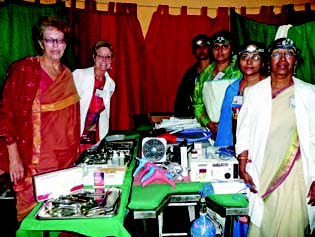
Sri Sathya Sai Drinking Water Projects, India
“Water–The Elixir of Life”
The availability of drinking water is an important issue of concern for human health in developing and developed countries worldwide. Drinking water projects are one of several projects undertaken by the Sri Sathya Sai Organisation to serve society. The water projects started by Sri Sathya Sai Baba are an excellent testament to the tremendous service undertaken by the Sathya Sai Organisation. The water projects first started on a smaller scale in the village of Anantapur, Andhra Pradesh, India. Subsequently several such projects were initiated and have provided drinking water to about 10 million people! Here are the details of the Sri Sathya Sai drinking water projects in India.
Anantapur Water Project
In March 1995 Sri Sathya Sai Baba declared that fresh water should be made available in the village to relieve more than one million people who were walking miles every day just for fresh water. In just nine months, at a cost of US $ 70 million, the project was completed, and more than 700 villages in the area rejoiced. The project, truly an engineering masterpiece, utilised more than 2,000 km of pipelines to direct water from 314 reservoirs and numerous storage tanks. Then upon the request of another 300 villages in the Medak and Mahabubnagar districts, Sri Sathya Sai Baba extended the water project to cover these areas as well.
Sathya Sai Ganga Water Project
In 2002, Sri Sathya Sai Baba created an entirely new and much-larger-scale project when he declared that a similar water project should be completed to alleviate the entire city of Chennai, Tamil Nadu in South India plagued by water shortages. At US $60 million, the Sri Sathya Sai Organisation had the Kondaleru-Poondi canal (now renamed the Sathya Sai Ganga Canal) reconstructed, which brought water to Chennai again after 50 years.
East and West Godavari Water Project
More recently, Sri Sathya Sai Baba has initiated two more water projects. In 2006, he undertook a project to supply water from the Godavari River to half a million people living in 500 villages in the East and West Godavari Districts, Andhra Pradesh, India. This project follows essentially the same scheme as the Anantapur project. The East Godavari District was fitted with two intake wells at Purushottapatnam and Pamaleru, and together they supply over 300 villages. The West Godavari District draws from an intake well at Polavaram. From here the water is sent to the treatment facility at Hukumpet. The water is then purified and sent via pipelines to all the villages, supplying fresh and safe drinking water every day.
Latur Water Project
In 2007, the Sri Sathya Sai Organisation also undertook another project in Maharashtra, India providing fresh drinking water to the residents of Latur.
Important Highlights of Sathya Sai Drinking Water Projects
Anantapur
|
No. of villages covered |
750 |
|
Population covered |
900,000 |
|
Design population |
1,250,000 |
|
Project cost |
US$ 63 million |
Medak and Mahabubnagar
|
Population covered |
1,000,000 |
|
No. of districts covered |
2 |
|
Total area covered |
640 sq. km |
|
Project cost |
US $ 11 million |
East Godavari District
|
No. of habitations covered |
212 |
|
Population covered |
220,000 |
|
Total length of pipelines |
535 km |
West Godavari District
|
No. of habitations covered |
240 |
|
Population covered |
470,000 |
|
Total length of pipelines |
640 km |
Sathya Sai Ganga (Chennai)
|
Population covered |
6.7 million |
|
Project cost |
US $ 63 million |
Although the objective of the drinking water projects was simply to provide fresh drinking water, it also inspired several people around the world to help others. For example, one person hailing from the Chittoor District, Andhra Pradesh, India, started mobilising people in various villages to tackle the water problem there. Another person spearheaded a similar drive in the Kolar District in the State of Karnataka, India. There are many other such local efforts in India. It is hoped that in the years to come, such schemes would multiply both in number and in magnitude all over the world.
This is indeed the case. In 2006, the details of the Anantapur water project were presented in front of the assembly of the World Water Forum. The gathering was astounded by the breadth and efficiency of the Anantapur project. They were also deeply impressed that private funding was drawn and that the care of the project was completely and unconditionally handed over to the state without any reservation. UN-HABITAT, the parent organisation, subsequently named this project one of the ten best in the world.

India
Andhra Pradesh
Over half of all groundwater sourced in India has fluoride levels above the recommended levels. As a result, many suffer from skeletal fluorosis, a condition where excess fluoride consumption causes damage to bone and joints, leaving many crippled and disabled. The Hyderabad Godavari district installed and commissioned a defluoridation plant in the village of Nalgonda district in August 2007. The plant supplies clean and safe drinking water to 4,500 people everyday.
Rajasthan
A water purification plant was installed in the village of Kaliyabheda by Bhilwara Centre on January 20, 2008. This plant will cater to the needs of 800 village people who have been prone to fluoride-generated diseases.
Sikkim
Under the Sri Sathya Sai Village Integrated Programme, Sathya Sai Youth and volunteers of Lingchom Centre under the West District of Sri Sathya Sai Seva Organisation, Sikkim, completed the construction of the pure drinking water project at Resham Gaon in March 2008, benefitting the inhabitants of Khujum Gaon, Toyang Gaon, and Gairi Gaon. A filter tank has been constructed at the source that releases pure drinking water continuously.
Tamil Nadu
As per Sri Sathya Sai Baba’s directive to bring drinking water to the doors of economically weaker sections, a water tanker was sponsored by Sri Sathya Sai Organisation of Tamil Nadu to supply drinking water to city slums. This Sri Sathya Sai drinking water tanker of 6,000 litre capacity was flagged off by the Chief Minister of Tamil Nadu, Sri M. Karunanidhi, at the Secretariat of Chennai on October 29, 2007. The tanker is equipped with 17 taps and a platform on each side to enable people to draw water with ease.
Water Purification Project: An initial survey of villages of the Kancheepuram district in Tamil Nadu area showed a lack of clean drinking water in the villages, and as a result, diarrhoea and vomiting were very common in the local population. The villagers had their own method of purifying the water, which was generally to allow the visibly dirty water to “rest” for 3 to 4 hours before they used it—because only then the mud settled down at the base of their vessels. Because of the importance of providing clean drinking water to the local village population, the water purification project became a priority, and one of the first projects that the Sathya Sai Youth took up in June 2007. Initially it covered eight villages of the Kancheepuram district in Tamil Nadu. Since then the effort has grown to encompass 22 villages and is still growing.
It is indeed no simple task to survey the villagers, get approval from village heads and the local Panchayat board, install water purifiers, and maintain them across 22 villages. Needless to say, it was made possible only by Sri Sathya Sai Baba’s Divine Will, Blessings, and Guidance. The village elders and government authorities not only readily agreed to the proposal, but also offered all necessary support. The spontaneity with which everyone involved wanted to embrace the projects bearing the name of Sri Sathya Sai Baba moved the young participants deeply. For the Sathya Sai Youth volunteers, it was indeed a humbling experience to observe the reaction of relief and welcome that Sri Sathya Sai Baba’s holy name evoked instantly even in such a remote region.
The youth volunteers collected water samples and sent them for evaluation to government-authorised laboratories to test water quality. After testing the water at a government testing facility, there was no doubt that the villagers had to be provided with water purifiers. A company making such products supplied the needed Water Purion water filters. After careful analysis, water purifiers were installed in strategic locations in the villages, and in addition, three purifiers were also installed in schools.
Transformation through Information After installing the systems, the Sathya Sai volunteers went door to door and explained to the members of each family about the new facility that was set up for them and briefed them on how to use it effectively. Pamphlets in Tamil, the local language, were also distributed to every household.
Self-Sustaining Empowerment To ensure the long-term viability of the project, two village youth were selected in each village and trained to maintain the purifiers. Sathya Sai Youth still visit these villages to monitor the working of the purifiers. The highlight of the entire project was not just the water purifiers, but also the purification that it brought about in all those who participated—from the volunteers to the villagers.
Sri Sathya Sai Baba’s Plan Includes Ecology, Environment, and Nutrition
In a bid to provide a long-term solution to widely prevalent malnutrition and environmental neglect, the Sathya Sai volunteers from Kancheepuram district in Tamil Nadu area planned another project involving the planting of tree saplings beside village homes. Sri Sathya Sai Baba graciously approved the plan and even suggested the species to be planted—drumsticks (Moringa oleifera), papaya, and curry leaf (Murraya koenigii). Volunteers procured the seeds of the three species from Krishnagiri, stored them in a central location, and allowed them to germinate in specially prepared containers. From the storage location, the saplings were transported by trucks and distributed to about 700 families in villages.
Sathya Sai Youth volunteers visited the villages every weekend to ascertain that the plants were cared for and growing well. These saplings have grown into healthy tall trees. The experience of seeing the team’s efforts come to fruition so efficiently, effectively, and quickly has been a gratifying, inner eye-opener for everyone concerned.
Sathya Sai Service in Salem
Accessories and aids were distributed on June 4, 2005, to physically challenged persons at Sri Sathya Sai Community Centre, Salem by the Sri Sathya Sai Seva Organisation of Salem District of Tamil Nadu. Much preliminary work was undertaken by the members of the organisation to identify people who are hearing impaired, visually challenged, and physically challenged requiring artificial limbs, braces, and crutches. Patients requiring artificial limbs were taken to Trichy Multipurpose Social Service Society for necessary measurements and production of appropriate equipment to fit their limbs.
The entire function was heartwarming and emotional when the physically challenged persons received the accessories and aids.
Among the items distributed were: hearing aids for 9 people with hearing impairment, canes for 30 people with visual difficulties, crutches for 7 people, braces for 25 people, artificial limbs for 9 people with hand problems, artificial limbs for 20 people with leg problems, tricycles for 2 people, and a wheelchair for 1 person.
Uttar Pradesh and Uttarakhand
Two deep-bore (36 to 45 metres), good-quality hand pumps were installed at convenient points by Sathya Sai Youth. The villagers are very happy and grateful to Sri Sathya Sai Baba for this facility provided to them. Sathya Sai Youth have also been advising the villagers not to waste water, the precious gift of God, and to keep the area neat and clean.
North America
USA
Connecticut
Norwalk The Sathya Sai Centres of Manhattan and Scarsdale, New York, joined the Sathya Sai Centres of Shelton and Norwalk, Connecticut, to organise a health fair on April 2, 2005 at Hart Magnet Elementary School in Stamford, Connecticut. With unity and love, 17 doctors, 5 laboratory/clinical assistants, 1 diabetic educator, 2 nutritionists, 10 Spanish translators, and 58 Sathya Sai volunteers participated in this health fair. A total of 155 patients received medical care and health information. Screening booths were arranged for height/weight/BMI, blood pressure, asthma, vision, cholesterol/HDL/glucose, haemoglobin, and mammograms. In addition, preventive healthcare booths provided information and awareness about topics such as obesity/dietetics/nutrition, cancer, stress management, diabetes, HIV, coronary diseases, and hypertension. Family practitioners and specialists in paediatrics, cardiology, internal medicine, oncology, obstetrics and gynaecology, and psychology served the patients with loving care.
Impressed with the services provided by Sathya Sai volunteers, many patients requested the Sathya Sai Centres to hold another health fair before winter. The Principal of Hart Magnet Elementary School was pleased with the services because the patients were able to spend time with doctors from various disciplines and discuss their health problems. She felt that the health fair was unique because even those who buy expensive health insurance often do not get access to all medical services on the same day.
Florida
Tampa Bay The Sathya Sai Baba Organisation of America conducted a free medical camp in Tampa Bay, Florida on April 28, 2007 at the Homeless Emergency Project Community Center. During the day, 40 healthcare personnel and 75 Sathya Sai volunteers served 335 patients by providing personal consultations and health screening. After serving them breakfast, the patients were shown films on anger management, depression, healthy heart and diabetes.
The Department of Health provided free children’s vaccinations on site. All visitors were given a canvas-cloth bag inscribed with the message, “Love All–Serve All” containing a T-shirt with the printed message “Help Ever–Hurt Never,” personal hygiene items, boxed lunch, fruit and water.
Missouri
St. Louis A free mammography camp was conducted by the Sathya Sai Organisation in St. Louis, Missouri, on June 11, 2006, at Our Lady of Guadalupe Catholic Church. Mammography equipment was donated by the Barnes Jewish Hospital, under the guidance and support of the Siteman Cancer Center, Mallinckrodt Institute of Radiology, and Susan G. Komen Breast Cancer Foundation. The day began with a silent prayer. Thirty-four women underwent a mammogram. Health education was provided, and breast self-examination was taught to the attendees. An interactive educational presentation with posters and flip charts on osteoporosis, heart disease, nutrition, breast cancer, and cervical cancer was given. Handouts were provided both in English and Spanish on women’s health issues. The camp was visited by the director of the health unit of St. Louis County, who applauded the efforts of the Sathya Sai Organisation.
A free digital mammography camp was conducted at Our Lady of Guadalupe Catholic Church in St. Louis, Missouri, on June 10, 2007. Full-field digital mammography is the current state-of-the-art screening technology for breast cancer. A free mobile unit was used to screen 49 women. A team of 35 volunteers participated. Women’s health education was provided under the supervision of 2 physicians. An interactive educational presentation with posters and a flip chart on osteoporosis, heart disease, nutrition, breast cancer, and cervical cancer was given. Blood pressure was also checked, and follow-up for the patients was arranged.
Central America
Dominican Republic
There is a nutritional programme for children with inadequate calorie intake in the Dominican Republic. Free mosquito nets, insect repellants, and other items are distributed to control mosquito-transmitted diseases like the deadly dengue fever. Help is offered to mothers, children, and the elderly with health problems. During festival celebrations food is served to all families, and Christmas every year is marked with the donation of toys and other gifts. There are free dental care programmes conducted specially for children. Small housing projects are undertaken, such as constructing a house for a needy family living in a cardboard shack. In addition, there are also regular free cataract surgeries.
This ongoing service activity extends to many communities such as Luisa La Prieta, Palamara, La Delgada, and Limon.
El Salvador
Inspired by Sri Sathya Sai Baba’s mammoth drinking water projects in India, Sathya Sai volunteers provided drinking water to many communities to whom the government could not provide for many years. New wells are dug and storage tanks are constructed for providing the drinking water by pumps, via pipes and through taps. Each water project provides drinking water to approximately 90 to 400 families in a community. There are 12 such projects in the region which provide drinking water to approximately 2,000 families and 3 schools.
South America
Argentina
Sri Sathya Sai Baba says the best medicine is preventive medicine, and the best way to implement prevention in the community is through education in human values. Education in human values is the foundation for the development of a dignified life and the best way to inculcate healthy habits in the community. Once this foundation had been laid down, specialised workshops were developed for different challenges faced by modern society, such as alcoholism, drug addiction, domestic violence, AIDS prevention, hygiene and oral health.
Brazil
To address the lack of clean water supply in Montenegro, Sathya Sai volunteers initially provided two containers of water to every household. Later, the Sathya Sai Organisation, along with local community members, installed an extensive water supply network.
Paraguay
The Native Indian Community in the region of Chaco is located approximately 60 kilometres from the Concepción and approximately 380 km from Asunción. The community consists of about 80 families comprising about 350 people. This community does not receive any aid from the government or other agencies. Electricity and running potable water are not available in this community from the City of Asunción. People use the natural water sources which may be polluted. As a result, people suffer from several diseases. Infant mortality is relatively high. Sri Sathya Sai Organisation in coordination with doctors and medical students of the National University of Asunción, has provided medical aid to the community once a year since 2001. Furthermore, additional medical aid and medicines are also provided. Food items including rice, sugar, oil, flour as well as clothes, shoes, and blankets have also been distributed.
Since 2003, Sri Sathya Sai Organisation has been preparing and providing meals for approximately 400 patients at a mental hospital. Volunteers work late at night in selecting good quality vegetables and fruits from the donated stock every Monday. The vegetables and fruits thus selected last approximately for 2 to 3 days of meals twice a day for the patients at the mental hospital.
Since 2002, Sri Sathya Sai Organisation has been distributing lunch for approximately 500 to 700 patients per week at different hospitals in Asuncion city. On Saturday afternoons, food preparation including cutting of the vegetables and other activities are completed. On Sunday morning food is cooked and packaged in plastic trays. At around noon, the lunch is distributed to several hospitals. More than the food, it is the personal communication between the volunteers and the patients through the exchange of love which serves as a cure to the ailments people suffer from.
Peru
For many years now, there have been regular services such as visiting the homes of the elderly and of the blind, as well as homes run by the Sisters of Mother Teresa. Volunteers also visit psychiatric hospitals, maternity hospitals, and communities of Balneario de Ventanilla and Virgin de Cocharcas. They educate them on personal hygiene such as bathing, haircuts, trimming nails, and dental service.
Europe
Greece
On December 8, 2007, Sathya Sai volunteers visited the Perama area in the port city of Piraeus and distributed 33 bags of food, clothes, and toys to 27 children. The paediatrician of the team, who had a list of needy people, visited the families with children to give them health advice and vaccinate their children that day.
On December 15, 2007, Sathya Sai volunteers gathered in the foothills of Mount Hymettus in Attica and planted 188 trees and 100 acorns to regenerate the forest destroyed by a fire in 2007.
For the past 10 years, the Sri Sathya Sai Organisation in Greece has been organising special events on various occasions. Thus the annual spring celebration took place at the Institution of Chronic Illnesses in Agia Barbara, in the Aigaleo, South Attica.
On April 11, 2009, volunteers visited the needy people in Perama, Piraeus, and distributed food and clothing. That day our paediatrician visited 11 families in their residences and examined a total of 14 children and adults. Used laptop computers in perfect condition were donated to two children who excelled academically, as well as to an unemployed person. In addition, Sathya Sai volunteers continued their weekly private math tutoring for children, and continued paying regularly scheduled twice-monthly visits to the Chronic Illnesses Institution in Skaramanga Piraeus, to the Centre of Recuperation and Rehabilitation of Children (orphans and disabled) in Glyfada, to the home for disabled persons in Kallithea, and the Exarchia Cultural Centre for disabled youth in Athens. They are taught how to draw, and given lessons in paper cutting and pasting, as well as acting.
UK
Blood pressure and diabetes check programmes are opened to the public on a regular basis at Sri Sathya Sai Centres to raise health awareness in the respective regions. Several walk-in health awareness programmes have also been organised in the country.
As part of the nation-building initiative, the organisation continues to focus on the following national projects:
Drug Awareness Programme • – In conjunction with a university, a drug and alcohol awareness programme has been launched. The university has donated a number of videos in different languages to the Sri Sathya Sai Organisation. This programme is designed to prevent drug and alcohol abuse.
Medical Awareness Programmes • – include diagnostic camps and counselling services for blood pressure, healthy heart promotion, and a prevention of blindness programme. The doctors and optometrists carry out detailed examinations with very sophisticated instruments for early diagnosis and advice for prevention. It is a very popular and well-attended programme in all the regions and is very well supported by local primary care health trusts. During 2009, four clinics have taken place in the London area and Southampton. More than 1,000 members of the general public have benefitted.
Blood Donation Programme• – For many years the Sathya Sai Organisation has been in the forefront of blood donation programmes. Recently, many Centres arranged for volunteers to donate blood as most people were away on holidays. The National Blood Transfusion Service has recognised the Sathya Sai Organisation as an important force in providing donors during the crisis, with many volunteers of a rare blood group who are ready to donate on short notice.
Bone Marrow and Leukemia Awareness Pro• gramme – A national initiative working in partnership with the Anthony Nolan Trust to encourage more bone marrow donors to register. This has increased awareness in the Asian population that it is important to come forward and register their names.
Cancer Awareness Programme• – Working in conjunction with Cancer Black Care. The organisation is working along with doctors from the Royal Marsden Hospital, known for its reputable cancer research.
Working with Communities• – The organisation also helps to provide volunteers to other organisations, for example, the Association of Blind Asians, Age Link, and Mencap. The Sathya Sai Organisation sends volunteers and food for the monthly meeting that is held at the Royal National Institute for the Blind (RNIB) by the Association of Blind Asians.
First Aid and Food Hygiene Training Courses• – These are being organised at the Centre level for members to train within their area. All members are encouraged to attend sessions. Many volunteers have been trained in this wonderful programme because it is important to have someone in the Centre who can deal with an emergency during functions and also to serve and prepare food that satisfies the local laws. The programmes are getting increasing traction, and most regions have conducted at least one training course in 2009.
“Health in Your Hands” Workshop• – Centres are encouraged to invite a local GP/consultant on a regular basis to address the congregation on various health topics. This has brought a new health consciousness. Many people now exercise regularly, eat healthy food, and have eliminated or substantially reduced smoking and alcohol consumption.
Africa
Nigeria
With the goal of providing loving and quality service to the remote slums of Nigeria, the Sathya Sai volunteers of Nigeria kicked off a pilot service project with a tour of a slum in Ajagunle, Lagos. Upon analysing the data acquired from the tour, a detailed implementation of the service project in four phases was planned. The four phases are (1) feeding of 300 families, (2) distribution of soaps/detergent powders/germicides to 500 families, (3) a medical camp, and (4) distribution of clothing/shoes.
Three of these above four phases are already in place, regularly serving and bringing joy to the less privileged. Very soon the fourth phase will also be started. Plans have also been made to extend this pilot service project to several other slums in different parts of Nigeria.
Sierra Leone
The Sathya Sai Organisation donated 550 wheelchairs to Alhaji Dr. Mohammed Tejan Kaba, president of the Republic of Sierra Leone, for the benefit of the many people that had lost their legs and arms during the conflict. The formal presentation of the wheelchairs to the president was made on September 19, 2006 in the Sate Lodge in the presence of the attorney general, ambassadors, the ministers of health, social welfare, gender and child development, and high officials of these ministries.
The president thanked the organisation for the much-needed service and donation and welcomed it to Sierra Leone. The presentation was widely reported on national television and radio.
Zambia and Kenya
The Sathya Sai School of Ndola, Zambia, with 720 pupils, has been mentioned in the Parliament as one of the top three schools in the country. School personnel participate in medical camps, feeding the poor, environmental cleaning, and volunteer work in churches and provide drinking water to the needy.
The 160 students of the Sathya Sai School of Kisaju, Kenya, participate in Education in Human Values workshops and environmental cleaning projects. They also take part in other activities such as distribution of blankets and providing drinking water to the local community. The Sathya Sai School of Uthiru, Kenya, with 176 pupils, participates in village cleaning, feeding orphans, and building small roads and take part in workshops on human values.
Water Education: ������������������������������������Africa has been plagued with a serious water shortage, and with its population estimated to reach 1.5 billion in about 20 years, this looming crisis is threatening to become a major issue for peace and stability in the region. The African Institute of Sathya Sai Education in Zambia has launched, with support from the United Nations Centre for Human Settlement (UN-HABITAT), a very successful programme to impart water, sanitation, and hygiene education through human values. To sensitise pre-school, primary and secondary school children to the importance of water for the survival of humanity, the programme is integrating human values in water education in the curriculum of the schools of Africa, starting with 6 countries – Ethiopia, Kenya, Zambia, Ghana, Senegal and Ivory Coast. The Times of Zambia wrote on January 20, 2003, “The human values approach to water education in Africa lays great emphasis on the values rooted in African culture, and trainees are encouraged to bring out their cultural values. The human values approach emphasises five universal core values as their basis. These are: Truth, Love, Right Conduct, Peace and Non-violence, which have numerous practical modes of expression.” Impressed with the success of this pilot programme, efforts are now underway to expand the scope of this programme to the entire world (especially Third World countries), through the UN Millennium Task Force on Water and Sanitation. This second phase of the project ends on December 31, 2009.
Middle East
Dubai
On December 12, 2006, 25 volunteers from the Sathya Sai Group of Dubai participated in the Environmental Hygiene Programme organised by the Emirates Environmental Group (a non-governmental organisation, accredited by the United Nations Environment Programmes), Dubai. About 17,000 volunteers from all over the UAE, including individual families, educational institutions, and government and private organisations, took part in this huge campaign. Sathya Sai volunteers managed one of the four zones during the activity, supervising the work and providing for the needs of about 780 workers covering an area of about seven square kilometers. More than 40 Sathya Sai volunteers, many of whom had taken the day off from their jobs, participated in collecting trash, bagging it, and moving the trash bags to the roadside for pickup.
The following year, the Sathya Sai Group of Dubai participated in another large-scale environmental clean-up campaign on December 12, 2007. The Emirate Environmental Group organised the “Clean-up UAE 2007” campaign with the aim of mobilising over 20,000 participants from all walks of life at different natural and man-made sites across the seven emirates of the UAE.
Asia
Indonesia
Vaccination Outreach Indonesia has a high prevalence of hepatitis B, a serious disease caused by a virus that attacks the liver. The hepatitis B virus can cause lifelong infection, cirrhosis (scarring) of the liver, liver cancer, liver failure, and death. The risk of death from hepatitis B–related diseases is greatly increased for those who become chronically infected during childhood. To assist the government in combating the spread of this disease and to ensure a brighter future for the children of Indonesia, the Sathya Sai Youth have embarked upon a mammoth project of vaccinating children nationwide against the virus. A pilot project was launched in Jakarta in 1997, wherein a modest number of 72 children were targeted. The vaccine is administered in three phases: the first inoculation followed by a second inoculation after a month, and the third four months later. Spurred by the success of this initial attempt, the Sathya Sai youth, at a national Sadhana camp, pledged to expand this programme into a national service project. The project has since advanced to its final phase, and to date, over 7,000 children have been successfully vaccinated. The parents of these children are happy that their children have been protected against Hepatitis B virus infection.
Fresh Water Project Sri Sathya Sai Organisation of Indonesia has completed a water project in village Mbuliloo, located in the Wolowaru district of the Nusa Tenggara Timur Province of Indonesia. For years, the people of this impoverished region had struggled to cope with the lack of fresh drinking water. The scarcity of potable water forced the villagers to survive on a well in a distant location, which only had toe-deep water to be shared among more than 234 families. The Sathya Sai Study Group acquired a privately owned well and built a tank to collect water from the well. From the tank, 900 pipes were laid over a distance of approximately 7 km to channel the water to individual houses, thus providing clean water to more than 234 families. The local authorities, on behalf of the villagers, submitted a formal letter of appreciation which reads, in part: “We could never have imagined that in this world full of politics, turmoil and social crisis, there are still people out there who care to help small, helpless people like us. We take this opportunity to express how delighted and thankful we are to Sri Sathya Sai Organisation that has given the greatest gift of kindness that we will never be able to repay. Many thanks from all of us, the people of village Mbuliloo.”
Lao People’s Democratic Republic
Dr. Yeoh of the Singapore Sathya Sai Organisation, met with the Lao People’s Democratic Republic (PDR) Sathya Sai Organisation, Lao PDR government officials, and the governor of Xieng Khuang Province and received their support for distributing mosquito nets. It was decided that the target area for this mission would be in Phoukhout district of Xieng Khuang Province. Final detailed plans were arranged, and 5,000 treated, long-lasting nets were purchased. Although more expensive than the normal treated nets, these are ideal for the Lao PDR project, because the villages are so inaccessible. Also, plans were completed to purchase and transport 20 tonnes of rice for distribution in the villages. The team structures were developed. A medical doctor, Dr. Ho Soon Lye, volunteered to accompany the team and conduct a medical camp in the forward areas. The main party, consisting of 22 volunteers from Singapore, left Singapore on March 9, 2006. They were joined by 60 volunteers and others from Lao PDR and Thailand, besides a number of Lao PDR government officials and Buddhist monks. The distribution was done successfully over two days, March 11 and 12. The volunteers were divided into 12 teams, and these teams went in different directions with their route maps and briefs.
Dr. Ho Soon Lye set up a medical camp at the forward base. He saw about 200 patients in two days, mostly from 40 to 80 years of age. He found the people reasonably healthy. There were no signs of diarrhoea or heart diseases. There were, however, many people with skin diseases caused by overexposure to the elements. Most had ulcers and pains on account of fatigue. There also appeared to be cases of iodine deficiency. Antifungal cream, antibiotics, nutritional supplements, and dressings were provided.
Philippines
On August 10, 2003, 750 children and adults received treatment at the Fifth Sathya Sai Preventive Healthcare Medical Camp from a team of 100 doctors, dentists, ophthalmologists, nurses, pharmacists, and volunteers, coordinated by the Sathya Sai Organisation. Teacher-students and alumni of the Institute of Sathya Sai Education (ISSE), San Pedro, gave talks on health and hygiene and the practice of human values. Youth volunteers painted brilliant posters on human values and healthcare, which were displayed on the walls, and compiled tips for good health in a pamphlet that was distributed to all families. All patients received the prescribed medicines and multivitamins from the pharmacy, and food packets while leaving the camp venue. That day, the starting of the monthly Sathya Sai Health Centre (Sai Klinika Ng Kalusagan) at the ISSE San Pedro was also announced. The Klinika began operation on September 28, 2003 and served 68 patients on the first day.
Tuberculosis Project: On May 22, 2005, Sri Sathya Sai Organisation of Philippines launched the “Take Better CARE” (TB CARE) project. Under the auspices of this project, 80 children of Prayer Mountain, Antipolo City received treatment for pulmonary tuberculosis. Each group is personally administered the daily dosage by a health worker, who also monitors the progress (x-ray and sputum tests) and other health concerns of the child. The medications are provided by the volunteers of the Sathya Sai Organisation. This project culminated in November 2005, coinciding with Sri Sathya Sai Baba’s eightieth birthday.
Australia
Water Project in Toomelah: The Toomelah Aboriginal Community is located approximately 40 km from Goondiwindi near the Queensland and New South Wales border in Australia. Seventy families are living there, including approximately 100 children, and their facilities are very basic. Their water supply is from a borehole piped to ground storage tanks. This water is then pumped to an overhead tank and then distributed to the community through a network of pipes. It was scientifically and independently demonstrated that the Toomelah water was not up to the standards of the Australia Health Regulations for Drinking Water and it therefore required treatment before drinking. The bore water was contaminated with chemicals (e.g., insecticides and many other chemicals).
The hearts of the Sathya Sai Organisation had gone out to this native community, which was suffering from contaminated water. After liaising with the community, the Sathya Sai Organisation decided to install a water purification system and 1,000-litre storage tank. After extensive organisation and procurement of materials, the 12-hour installation work was carried out on November 4, 2005.
The Sathya Sai Organisation’s work also came to the attention of the local press, which carried this story on Sri Sathya Sai Baba’s Birthday.
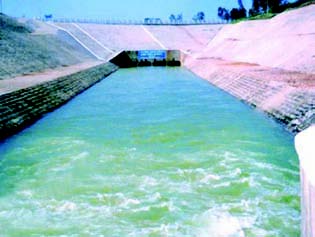
Chennai Water Project

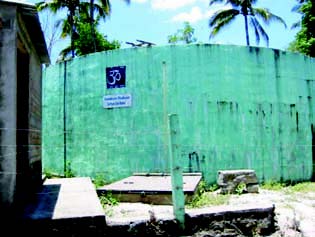
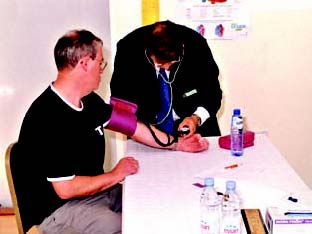
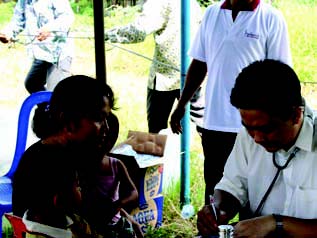
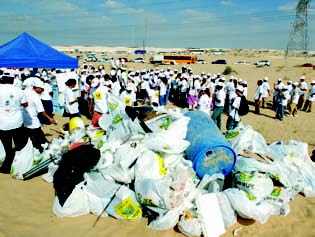
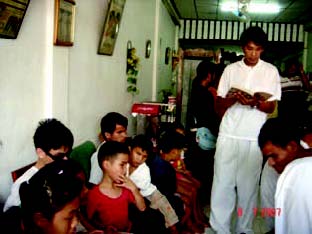
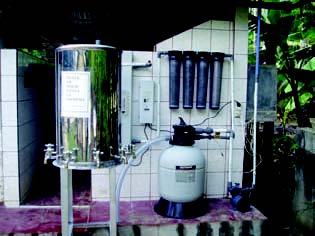
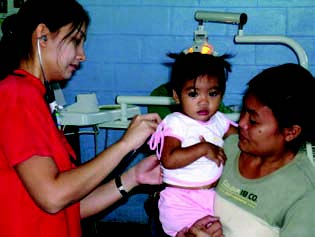
Medical Camps
3
“Doctors should win the hearts of the patients by talking to them with compassion and concern. Diseases are half cured when the doctors talk to the patients with love and consideration.”
Sri Sathya Sai Baba, January 21, 1994
In spite of government and private expenditures on healthcare, social and economic inequalities exist that result in large populations that are uncared for, with poor sanitation and poor access to appropriate healthcare. In the United States, for example, recent reports indicate that nearly 46 million Americans, or 18 percent of the population under the age of 65, were without health insurance in 2007. In addition, nearly 90 million people below the age of 65, accounting for about one-third of the population, spent a portion of either 2006 or 2007 without health coverage because of the recent economic crisis and this problem continues through 2009. Lack of health insurance compromises the health of the uninsured because they receive less preventive care, are diagnosed at more advanced stages of disease, and once diagnosed, tend to receive less therapeutic care and have higher mortality and morbidity rates than insured individuals. There is a great deal of pain and suffering for the affected families as a result of not having appropriate and timely medical care.
To help alleviate some of the suffering, the Sathya Sai Organisation has actively provided free, good quality healthcare by organising free medical camps throughout the world. They benefit those people without health insurance or any other form of social assistance. The following are some of the services provided in these free medical camps:
Disease Prevention• Health education regarding diet, exercise, weight control, meditation, dental hygiene, smoking cessation, anger management, and cleanliness.
Preventive Screening and Management• that may include measurements of body weight, body mass index, blood pressure, blood glucose, lipid profile, hearing and vision screening, bone densitometry, mammograms, Pap smears and importantly immunisations.
Training in Basic Lifesaving Skills• such as first aid, basic life support, CPR, and disaster preparedness, as well as bone marrow and blood donation drives.
Disease Treatment• In several countries, medical and surgical treatments for chronic conditions are also provided to patients in addition to preventive care. The type of care provided was based on the local need, healthcare policies, and available resources.
Below are descriptions of medical camps organised all over the world.
India
Andhra Pradesh
Forty-six medical and veterinarian camps were conducted in the state of Andhra Pradesh in 2007-2008. During these camps, 5,085 animals and 18,132 people were seen and treated. Minor surgical procedures as well as cataract surgeries were carried out. Preventive healthcare was the theme in several camps, which included prenatal health education for expectant mothers. Cancer screening, as well as screening for hypertension, diabetes, and heart disease was frequently carried out.
Assam
Several free medical health checkup camps were organised in 2008-2009 in villages near Gauhati where there are no basic medical facilities. In all, 3,050 patients were seen and 210 animals were seen in veterinary camps. Specialists in internal medicine, paediatrics, orthopaedics, surgery, dentistry, gynaecology, dermatology, ENT and ophthalmology provided medical care. Free medications were dispensed to the patients. In addition, in order to preserve health, villagers were given safe drinking water, low-cost latrines, smokeless ovens and education in sanitation.
Gujarat
The Sathya Sai Organisation routinely conducts medical camps, education on cleanliness and childcare in several villages. In 2008-2009, 1,478 patients were seen and treated in 4 medical camps and 465 cattle were seen in a veterinary camp where they were treated for routine illnesses and vaccinated.
Haryana and Chandigarh
Eighteen medical camps were held in Haryana and Chandigarh during 2008-2009. In these camps, a total of 14,296 patients were seen by specialists in internal medicine, paediatrics, orthopaedics, dentistry, dermatology, gynaecology, ophthalmology, ENT, and drug rehabilitation. In addition two blood donation camps were conducted in which about 900 units of blood were donated.
Jammu and Kashmir
The Sathya Sai Organisation of Jammu and Kashmir continue to organise veterinary camps in the villages of the State for the benefit of villagers. In 2008-2009, seven veterinary camps were organised in which 750 cattle were vaccinated against common communicable diseases.
Karnataka
From January 28-31, 2007, a medical camp was held in a coastal village in Karnataka where specialty care was provided in general medicine, surgery, gynaecology, paediatrics, ophthalmology, ENT, dentistry, and radiology. In this camp alone over 11,000 patients were seen. Special camps were conducted on the subsequent four Sundays for eye care and prescription of eyeglasses. About 2,000 pairs of eyeglasses were distributed in the camp. About 1,000 patients were referred for further consultation, investigations, and surgery. Because many specialists could speak the local language, the villagers were very happy with the care they received. During the medical camp, about 12,000 people were fed.
A medical camp was held near Mangalore from January 28-30, 2008. More than 3,500 patients were seen, and several specialities were covered. Blood, ECG, and x-ray tests were carried out for the needy. More than 1,000 pairs of eyeglasses were also provided. Three hundred and fifty-four patients were offered free surgery if needed, at hospitals in Mangalore. About 80 doctors, including several paramedical staff, participated daily in this camp. A few doctors and optometrists came from the UK, and two physiotherapists came from Russia and Ukraine. Food was served to 6,500 people in the camp.
Punjab
The Sathya Sai Organisation held 18 medical camps in 2007-2008 in several villages in Punjab. In these camps, a total of 14,613 patients were seen and treated.
A blood donation camp was also organised at the same venue on September 30, 2007, at which 82 units of blood were donated by Sathya Sai Youth. In addition to these, 173 cataract operations were conducted successfully in medical camps. An annual medical camp was organised at Gurdaspur, in which artificial limbs were provided to about 200 patients on November 16, 2008.
In addition to the medical camps, 3 veterinary camps were conducted and a total of 183 animals were treated. The villagers from far-flung villages who could not bring their animals to the camp site were provided this facility at their doorstep.
Rajasthan
The Sathya Sai Organisation conducted two cattle-care camps in villages near Udaipur on March 25, 2007 and May 4, 2008 in which about 600 cattle were provided veterinary treatment.
Sikkim
A free medical camp was organised where free medicines were distributed to the patients. About 103 patients were treated and food was served to all the patients. About 200 villagers benefitted from this service. A healthcare programme for the children was also conducted. Sathya Sai Youth also organised a free medical camp at Upper Suman on May 20, 2007. More than 300 patients were treated, and free medicines were distributed to them.
A veterinary camp was organised by the Sathya Sai Youth in Kabrey village with the help of the Animal Husbandry and Veterinary Service Department, Namchi. Resource persons delivered lectures on livestock management and control of animal diseases. Cattle were also treated. About 73 villagers derived benefit from the programme.
Tamil Nadu
Several medical camps were conducted in the state of Tamil Nadu by the Sathya Sai Organisation. A specialised screening camp for gynaecology and general medicine was organised for a cluster of villages in the Tiruvallur district on February 3, 2008. A total of 220 patients were examined. All of the patients were provided with a health record book. As a follow-up to this screening, 2 patients requiring surgery were identified, and they were taken to Chennai, where they were operated on.
A free diabetes awareness and screening camp was organised in Kodaikanal, on June 13-14, 2009. A 32-member team of diabetologists, ophthalmologists, dietitians, diabetes educators, technicians, nursing staff, and pharmacists rendered this service with the active support of volunteers. Of the 715 persons screened, 13 were found to be new cases of diabetes. Medicines were provided free of cost.
Eye camps Three medical camps including an eye camp was organised in Kodaikanal in June, 2008. Three hundered and one patients were seen and 32 of them received cataract surgery. Seventy-five patients were provided with eyeglasses free of cost. In a follow-up camp held on July 20, 2008, 32 patients who underwent cataract surgery were reviewed, and post-operative checkups were carried out. A paediatric camp exclusively for village children under the age of 12 years was organised on July 27, 2008.
Another eye camp was conducted in Chennai in June, 2008 in which a total of 203 patients were screened for various eye ailments, including cataracts. Fifty-three patients received cataract surgeries.
Uttar Pradesh and Uttarakhand
Three blood donation camps were conducted near Noida with the help of doctors from AIIMS, New Delhi. For the camp held on May 13, 2007, advance door-to-door campaigning for 15 days was done by the Sathya Sai Youth of the area. As a result, 150 persons turned out to offer blood. A total of 111 units were accepted by the doctors for their blood bank.
Sri Sathya Sai Organisation of Delhi performed service in 9 villages in the East District of Delhi under the Sri Sathya Sai Village Integrated Programme. Door-to-door surveys were conducted in these nine villages, covering over 1,200 families. Data reflected health problems, mainly eye disorders. Therefore eye checkup camps were held in seven villages, where as many as 1,150 patients were examined, free medicines were given to 475 patients, eyeglasses were made and given to 455 needy people, and 76 patients suffering from serious problems were referred to nearby hospitals.
A bus fitted with complete dental equipment visits the Matiyala village as often as required. All procedures such as fillings, extractions, medication, etc., are provided to the patients. Most of the senior citizens of the village have been checked and operated on for cataract/glaucoma. Patients are taken to an eye hospital, and treatment is given when needed.
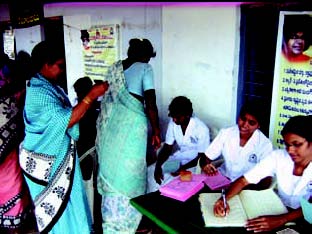

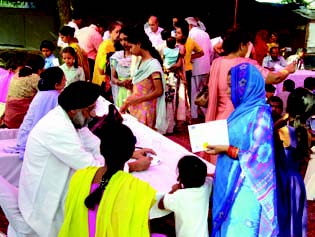
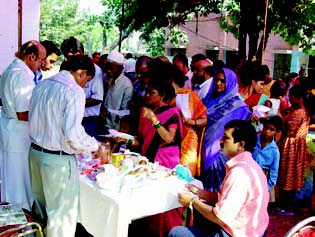
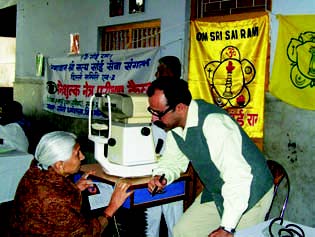
Delhi Eye Camp
North America
USA Bone Marrow Registry
Currently a critical need exists, in the National Bone Marrow Registry, for South Asian registered donors. The National Bone Marrow Donor Program has 5 million registered donors, but less than one percent of the donors are South Asians. Other ethnic groups in the USA are also highly under-represented, such as Native Americans, Pacific Islanders, and others with various forms of cancer, whose lives could otherwise be saved. Consequently, a viable treatment remains out of reach for many Asian Americans, Africans, and others.
Various regions began immediate plans to implement the bone marrow registration drive in their areas. The St. Louis Medical Camp, in November 2008, collected tissue samples from members of several ethnic groups. Members of the Sathya Sai Centre of Memphis, Tennessee, held three drives in which over 20 volunteers, including young adults and Sai Spiritual Education (SSE) students, registered 65 members of the Indian community.
Bone marrow registration drives have been conducted by Sathya Sai Centres in over 20 major cities in the USA. Many centres have conducted multiple drives on multiple dates. Due to the selfless service of Sathya Sai volunteers, over 1,200 people have been added to the National Bone Marrow Registry, which means that 1,200 more possible bone marrow matches are available to those who may need to receive treatment for life-threatening illnesses.
USA Medical Camps
Arizona
Phoenix, 2005 A daylong medical and dental camp was conducted on Saturday, June 25, 2005, at the Central Arizona Shelter Services facility in Phoenix, Arizona. Eighty volunteers from all across the state participated in this camp, which served homeless people. Twelve physicians and 6 medical assistants composed the medical team that rendered services to 150 patients at the camp. Prevention and health education were emphasised in the following areas: smoking, hepatitis and HIV, alcoholism, diet and exercise, and mammogram and Pap smear tests for early cancer detection in women. Patients were provided with hygiene kits and appropriate referral services for follow-up care. Sai Spiritual Education children made posters on healthy living. At the dental clinic, a team consisting of 4 dentists and 2 dental assistants rendered services to 57 patients. The procedure consisted of thorough examination, evaluation, and treatment pertaining to extraction, filling, and cleaning of teeth. A free lunch was served around noon to approximately 375 people.
California
Carlsbad, 2006 A free veterinary clinic was held in Carlsbad, California near San Diego on December 9, 2006. At the camp, 88 dogs and 35 cats were seen by veterinarians. Veterinary examinations were conducted along with vaccinations, flea and parasite control, blood analysis and grooming. In addition, pet owner education was provided in pet nutrition, disease prevention, early intervention with flea and parasite infestation, proper grooming and dealing with pet’s behavioural problems from a base of love and compassion. All these services were offered to the public completely free of charge by the Sathya Sai Organisation. For follow-up care, the pets were referred to local low-cost clinics and charities. The event, which took place at a local Christian Church, began with a brief talk by Dr. Samuel Sandweiss. Dr. Sandweiss focused on Sri Sathya Sai Baba’s teachings of “Love All – Serve All” and exhorted all to treat the patients, pets and each other with love and compassion. All pets received food and pet toys and the owners received fruit juice and snacks free of charge.
During the same time as the veterinary camp on December 9, 2006, a medical camp was held at the Pilgrim United Church of Christ in Carlsbad. A team of 32 doctors, 8 dentists, 27 nurses, psychologists, dietitians and physical therapists provided free consultations in paediatrics, family practice, internal medicine, cardiology, endocrinology, dermatology, ophthalmology, orthopaedics, and dentistry. One hundred fifty-seven patients were seen by primary care doctors, 193 patients received dental screening and 316 laboratory tests were performed, all free of charge. In addition to this, 282 persons were screened for diabetes, hyperlipidemia, hypertension, breast cancer, and cervical cancer. Dr. Poniachik, an internist on the staff at North County Health Services, kindly volunteered at our camp and made this observation: “After having been involved in numerous charitable medical activities, the (Sathya Sai) Carlsbad Free Medical Health Screening was the most well-organised community clinic I have ever participated in. Most importantly, all the patients were extremely happy with the care they received.”
Chula Vista, 2008 On Sunday January 27, 2008, Sathya Sai volunteers organised the Second Free Pet Health Screening Day at Memorial Park, Chula Vista, California, a poor community south of San Diego, close to the border with Mexico. With 8 veterinarians, 22 veterinary technicians, 23 local high school students and 108 volunteers, 240 dogs and 58 cats were examined. All the dogs received de-worming medication, flea control treatment and a full examination. Groomers were on sight to trim nails, clean ears and give grooming tips. Vaccines were administered depending on the need, age and circumstances. After 100 dogs received the rabies vaccine for free, the city of Chula Vista provided licences for them. The benefits of having fewer stray dogs and cats were addressed. Ten dogs and two cats had blood tests, and the results were referred to three local veterinarian hospitals that chose to participate in these efforts.
The pet owners were given a gift bag filled with pet food, gift coupons and a medical record booklet. All the pets were given water and pet biscuits while they were waiting for the examination. Pet owners were full of gratitude and some even wanted to volunteer their time for the next veterinary camp. Respect, compassion, kindness, and patience were felt throughout the camp.
Corona, 2004, 2007-2008 The City of Corona is located in the outskirts of Los Angeles, California, and the Sri Sathya Sai Organisation of America has conducted free medical camps there in 2004, 2007, and 2008. Over 2,900 people were served lovingly during these camps. Up to 100 medical professionals and 200 other volunteers including school children provided loving service during these camps.
Services provided in these medical camps included audiology, cardiology, chiropractic care, dentistry, dermatology, endocrinology, ENT, family practice, internal medicine, gastroenterology, gynaecology, ophthalmology, orthopedics, paediatrics, pharmacology, pulmonology, rheumatology and urology. Other essential services were provided, such as psychiatric and nutritional counseling, immunisations, blood tests, hypertension screening, EKGs, and bone density tests.
Special tests for women were also performed. Cancer screenings were conducted with mammograms, Pap smear, prostate screenings and blood tests. Screening was also offered for diabetes, hypercholesterolemia, cardiac disease, pulmonary disease, osteoporosis and visual acuity. Routine immunisations were provided. Patients were provided with snacks and drinks.
In recognition of the exemplary service rendered to his community by the Sathya Sai Organisation, the Mayor declared October 9, 2004 as “Medical Camp Day” and presented an official proclamation to the Sri Sathya Sai Organisation of America on behalf of the Corona City Council, recognising and commending the efforts to serve the needy through the medical camp.
During the March 17, 2007 medical camp, Mayor Pro-Tem Jeff Miller, stated that, “the Sathya Sai Baba Organisation of America has a strong commitment to provide much needed health programmes and services that address the unmet needs of children, youth, seniors, and families in the Corona-Norco community.” He formally presented the Sathya Sai Baba Organisation of America with the Proclamation passed by the Corona City Council and signed by Mayor Eugene Montanez that proclaimed Saturday March 17, 2007 as “Corona-Norco Community Free Health Screening Day.”
Los Angeles, 2005 On April 16, 2005, a free health screening camp was held in the working-class Hispanic community of Sun Valley near the city of Los Angeles. More than 200 individuals were served at this camp. Besides primary care, dental care, ophthalmology, paediatrics, blood tests, Pap smears, and mammograms, other specialised services offered at this camp included dermatology, endocrinology, cardiology, pulmonology, orthopaedics, and gastroenterology. The love and care of the Sathya Sai volunteers was evident throughout the organisation of the event. “We didn’t expect much,” said a patient who came with his wife and four children ranging in age from 8 to 13, “but we received a lot. Everybody helped us very well.” His wife added, “All the people in the different departments were very kind – in paediatrics, in dentistry, in the blood department…. We are very satisfied.” It was indeed an uplifting experience for all present. The mood at the camp is most aptly described in the words of one of the patients, “I feel as if I am on sacred ground.”
Oxnard, 2006-2008 The city of Oxnard located by the Pacific Ocean in California has many low-income people who do not have access to adequate healthcare. Free medical screening camps were conducted in 2006, 2007, and 2008 by the Sri Sathya Sai Organisation of America. Over 1,450 people were served by several medical professionals and other volunteers. During the October 21, 2007 medical camp, with remarkable determination and love, many volunteers braved 80 kmph gusts and raging forest fires in the region and provided loving services to patients.
Medical professionals included primary care physicians and specialists in heart, lung, bone, skin and paediatrics. Medical services included screening for blood glucose, cholesterol, high blood pressure, vision, anaemia, cancer, and nutrition. Health education and disease prevention counseling was provided. Psychological counseling was also provided. Patients with positive findings were followed up by local clinics and hospitals. Volunteers distributed food and clothing to those in need. During these camps, many VIPs visited the medical camp grounds. All of them were impressed with the number of services being provided and the number of volunteers who participated. On seeing that the camp was organised by Sri Sathya Sai Baba Organisation, the Consul General of Mexico, commented, “Oh, I know Sathya Sai Baba. He is well known in Mexico!”
San Jose, 2005 The Sathya Sai Baba Centre of Central San Jose conducted a health and wellness screening service on April 9, 2005 in Sunnyvale, California. The location of the project, Fair Oaks Park, is a predominantly Spanish neighbourhood that was selected with considerable help from the City Mayor’s office. During this half-day camp, 49 people were served. The services included blood glucose level, blood cholesterol level, blood pressure, height, weight, body mass index, risk factor profile, nutritional counselling, exercise recommendations, smoking cessation counselling, and alcohol and drug rehabilitation information.
The medical team consisted of 5 doctors, 3 registered nurses, and 2 medical assistants. More than 50 non-medical volunteers, including SSE students, participated in the areas of registration, documentation, ushering, sandwich preparation, distribution of flyers, poster displays, and transportation. Approximately 7 volunteers rendered help translating for Spanish patients in the areas of registration, ushering, and doctors’ recommendations. A list of local health resources (public hospitals, community hospitals, free clinics, and Planned Parenthood centres) within a 10-mile radius of the project location was prepared and shared with the patients for follow-up. Patients were served food.
The Mayor of Sunnyvale, Mr. Dean Chu visited the project and commended the loving and disciplined service rendered by the Sathya Sai workers. The Mayor and the City of Sunnyvale have invited the Sathya Sai Organisation to conduct similar projects in other areas of the city in the future.
Florida
Jacksonville, 2006 In Jacksonville a medical camp was conducted on January 28, 2006; 74 patients were seen and screened for cholesterol, glucose, hypertension, HIV, and sickle cell disease. In addition, dental and visual examinations were performed, and the influenza vaccine was administered. Primary prevention presentations were given on heart disease, obesity, cancer, stress management, diabetes, and anger management. The event was covered by a local television station.
Tampa Bay, 2005-2007 In Tampa Bay, free medical screening camps were conducted in 2005, 2006, and 2007. Over 750 people were lovingly served by numerous medical professionals and volunteers. Medical services provided in these camps included screenings for diabetes, hypertension, obesity, asthma, HIV, hyperlipidemia, dental health, vision, hearing, head and neck cancers, hepatitis B and C, and syphilis. In addition, individual consultations were provided in internal medicine and family practice as well as various specialties including paediatrics, pulmonology, gastroenterology, endocrinology, dermatology, cardiology, oncology, gynaecology, psychiatry, dentistry, and ophthalmology. Paediatric vaccinations were provided as needed. Health education classes were presented on various topics including anger management, depression, smoking cessation, digestive disorders, heart disease, diabetes, weight management, breast cancer awareness and women’s health issues. In 2007, the Department of Health provided free children’s vaccinations on site.
People went out of their way to express how much love, genuine care and attention they felt. One commented, “We thank you for such a wonderful experience and to see firsthand how love and dedication can be given without conditions. I am honoured to have been a part of that special day and to witness the real truth of brotherhood. You all truly demonstrated the message of Sathya Sai Baba.”
During the June 11, 2005 medical camp, the Mayor’s representative, Beth Eschenfelder paid an official visit and was very impressed with the camp operations. She talked about the city getting actively involved in the camp in future. This inspired her to seek more information on Sri Sathya Sai Baba and His magnificent humanitarian works. During the June 11, 2006 medical camp, the Clearwater City Commissioner, Carlen Petersen visited and was very impressed by the camp, noting that it was a good example for others in the community. At a formal monthly Homeless Coalition meeting presided over by community shelter directors, social service agency heads and the mayor’s representative, the Sathya Sai Baba Organisation and its volunteers were formally recognised and thanked for organising the medical camp and serving the community.
Georgia
Fulton, 2007 On May 19, 2007, a free medical camp was conducted in Fulton, Georgia. Thirty physicians/nurse practitioners, 15 nurses/allied healthcare workers, and 75 volunteers served with love and compassion. The 128 patients seen on that day were screened for blood glucose, cholesterol, obesity, dental caries, vision, pulmonary function, and infectious diseases. Consultations were also provided for internal medicine, paediatrics, psychiatry, ophthalmology, cardiology, podiatry, and nutrition. Vaccination records were reviewed, and free immunisations were provided. Several adults received vaccinations for hepatitis A and B and meningitis.
Illinois
Chicago, 2003 A free child clinic and health fair was organised by Sathya Sai volunteers on March 14-15, 2003. Over 200 children were examined during the fair. After registering and receiving name tags, children and parents enjoyed educational booths while waiting for their doctor’s appointment. The games, toys, and gift items at each station put endearing smiles on all the little faces. Volunteer nurses and medical students took vital signs and plotted growth charts.
The medical services included a general physical examination, minor procedures, medications, and follow-up care in a local free clinic as needed. To increase awareness in the community about lead hazards and the risks of lead exposure to children, pamphlets in English and Spanish, stickers, and colouring books were handed out. The Department of Health offered free lead testing, follow-up education, and financial support to have home hazards rectified. General vision screening and follow-up referrals were also provided to the children as needed. An interactive booth was in place to teach children about proper brushing technique and the importance of dental care. Free toothbrushes, toothpaste, dental floss, posters, and brochures were given out. All children and parents received a healthy snack, and each child received a book appropriate to his or her reading level. Finally, the members of the community were encouraged to become involved in upcoming service projects, including cleanup, painting, and beautification of their neighborhoods.
Ingleside, 2007 From September 1-3, 2007, a regional retreat was held at Camp Henry Horner in Ingleside, Illinois. The theme of the retreat was “Feeling the Presence of God – Living in Loving Service.” As part of the retreat, a free medical camp was conducted. During the camp, 89 patients were screened for hypertension, diabetes, and cholesterol abnormalities. Health education was provided on nutrition, exercise, heart disease, stroke, and cancer. Several of the participants diagnosed for the first time at the health screening had abnormal findings with their blood pressure and/or blood tests. These patients were referred to appropriate facilities for further treatment. The camp also provided continuity of care for those screened in the past.
Indiana
Ft. Wayne, 2004 The Sathya Sai Centre of Fort Wayne, Indiana undertook a Health Screening Medical Camp for the Burmese refugee community at St. Patrick’s church in the city of Fort Wayne on June 5, 2004. Aided by Burmese translators, this daylong event served about 120 Burmese patients. The services included cardiac checkup, blood cholesterol and glucose check, osteoporosis screening, hypertension and diabetes screening along with dental, vision, asthma, and hearing screening. Adult and paediatric consultations were provided. Follow-up referrals were made to the local free clinics, especially ASK Medical Clinic, where some Sathya Sai physicians serve as volunteers. Besides screening, preventive health education was provided to cover all these areas, along with counselling for diet and nutrition.
Ft. Wayne, 2006 A free medical camp for sheltered women was conducted on April 8, 2006 at Fort Wayne, a charming town located in the State of Indiana. During the camp, physicians saw 33 female patients for preventive healthcare and health education. Health education was provided on an individual basis. This made the advice valuable as it addressed individual concerns. Health education was regarding hepatitis, AIDS, diabetes, breast cancer, osteoporosis, menopause, nutrition, smoking and alcohol. Screening was provided for asthma, dental health, osteoporosis, hypertension, mental health and vision. A total of 31 abnormalities were identified during the screening and these patients were appropriately referred for follow-up. The camp was much appreciated by the Health Commissioner who expressed a desire to visit India to see Sri Sathya Sai Baba.
Maryland
Baltimore, 2006 A medical camp was organised by Sathya Sai volunteers in Baltimore, Maryland, on June 17, 2006. Sixteen medical personnel and 44 volunteers saw 90 patients and screened them for hypertension, diabetes mellitus, mental health, visual impairment and glaucoma, dental abnormalities, lead exposure, paediatric health, and malnutrition. In addition, free CPR training was provided with certification for 6 registrants.
Michigan
Ann Arbor and Southfield, 2004 The Sathya Sai Centres of Southfield and Ann Arbor organised a health screening medical camp for an inner-city community in the city of Detroit, Michigan, on September 11, 2004. Held at the Motor City Resource Center, the camp offered the following services to nearly 100 patients: routine physical check, blood pressure check, heart and lung examination, blood testing for full lipid profile (cholesterol, triglyceride) and blood glucose levels, vision check and lead screening for young children. In addition, they also provided health education for asthma patients and nutrition counselling by certified dietitians. To encourage reading among children, free books were provided to all children who attended the health camp. Many of the resident physicians from the University of Michigan along with other volunteers from local hospitals and other health organisations were inspired by the love and dedication of the Sathya Sai workers and expressed gratitude to the Sathya Sai Organisation for the opportunity to serve.
Missouri
St. Louis, 2005-2008 The Sathya Sai Organisation of America conducted free medical camps in St. Louis on June 11, 2005, August 12, 2006, June 10, 2007, and November 1, 2008, serving over 990 people. Over 150 volunteers, including physicians, nurses, interpreters, and non-medical volunteers, participated. Services provided included body mass index check, blood pressure check, blood cholesterol and blood glucose check, lead screen, asthma screen, paediatric assessment, vision test, hearing test, dental check, skin care assessment, flu vaccinations, behavioural health, mammograms, Pap smears, osteoporosis screening, and diet/nutrition counseling. Other services provided during these camps included free eyeglasses, donation of bicycle helmets, and infant car seat checks. During the 2006 medical camp, a “Sai Human Values and Health” booth offered information in English and Spanish about Sri Sathya Sai Baba’s teaching on human values and health. Several county and city officials visited the medical camps and highly commended the services provided.
The director of health of St. Louis County attended the camp and was very pleased with the Sathya Sai Organisation’s efforts, as evident from the following proclamation by the Mayor of St. Louis:
Proclamation
WHEREAS, The City of St. Louis has been apprised that Sri Sathya Sai Baba is celebrating His 80th Birthday; and
WHEREAS, Sri Sathya Sai Baba is one of the most revered spiritual teachers in the world today whose life and message are inspiring millions of people throughout the world to turn Godward and to lead a more purposeful and moral life; and
WHEREAS, Sri Sathya Sai Baba was born as Sathyanarayana Raju in Puttaparthi, a remote village in the State of Andhra Pradesh in southern India. At the age of fourteen, He proclaimed His mission to bring about the spiritual regeneration of humanity by demonstrating and teaching the highest principles of Truth, Right Conduct, Peace, Love and Non-violence; and
WHEREAS, Throughout His life work, Sri Sathya Sai Baba has established an educational system which includes primary and secondary schools and an accredited university, offering undergraduate, graduate and doctoral degrees with no fees to the students. He has also established four hospitals, two of which provide advanced tertiary care and The Sri Sathya Sai Organisation; and
WHEREAS, The City of St. Louis is pleased and honoured to recognise Sri Sathya Sai Baba for all of His humanitarian work and extends best wishes to Him for good health, peace and happiness as He continues His journey along life’s path.
Now, therefore, I, Francis G. Slay, Mayor of the City of St. Louis, do hereby proclaim 11th September, 2005 as:
“SRI SATHYA SAI BABA DAY”
IN THE CITY OF ST. LOUIS
In witness whereof, I have hereunto set my hand and caused to be affixed the seal of the City of St. Louis, this 11th day of September, A.D. 2005.
– Mayor of the City of St. Louis
Ohio
Columbus, 2009 On April 4, 2009, a free medical screening camp was held in Columbus, Ohio at the Wesley Church of Hope, United Methodist Church. About 110 people ranging in age from 5 to 85 were served. Some patients were seeing a doctor for the first time in their lives. Twelve medical doctors, including specialists and a physical therapist, provided loving service to the patients in the fields of general medicine, paediatrics, geriatrics, ophthalmology, gynaecology, psychiatry and physical therapy. Blood screening (lipid profile) tests were conducted. About 60 volunteers, including Sai Spiritual Education (SSE) children and Sathya Sai Young Adults, rendered service. Non-perishable food items and personal hygiene supplies were distributed. Tears of gratitude shimmered in the eyes of many patients.
Pastor Richard Duncan communicated the success of the camp to the Regional Methodist Church, and as a result, a few other churches have since expressed strong interest in taking part in similar events in future. The medical camp was a concrete step towards “community building,” as people felt comfortable and welcomed during this event. As a fitting finale to the whole medical camp, the church asked that the banner with Sri Sathya Sai Baba’s teaching, “Love All – Serve All” and “Help Ever – Hurt Never,” be left at the premises.
Oregon
Eugene, 2008 A dental camp was organised in Eugene, Oregon, by Sri Sathya Sai Organisation of America in partnership with a local dental clinic on May 2, 2008. The camp served 73 children and adults. Many saw a dentist for the first time. Following the x-ray and initial screening, 4 dentists treated patients. Treatment included teeth cleaning, tooth extractions, and cavity fillings. Patients were then escorted from the treatment room to receive dental kits and oral care education from Sathya Sai volunteers with a nursing background. The children were offered free balloons. The smiles on the children’s faces with their balloons brought pure joy and happiness to all! Refreshments were also provided to all patients. There was a true spirit of loving kindness and compassion among the volunteers. Patients expressed deep gratitude for receiving dental treatment. Many of them came with immense pain and left with great relief.
Tennessee
Memphis, 2007 The Sathya Sai Centre of Memphis, Tennessee, celebrated Sri Sathya Sai Baba’s 82nd Birthday with a medical camp and a nursing home service activity. The medical camp was held on November 3, 2007 in one of the poorest areas of Memphis. Patients were screened for high blood pressure and cholesterol abnormalities. In addition, patients were given counselling for disease prevention and health maintenance. On November 24, 2007, Sathya Sai volunteers distributed quilts to 125 residents of a nursing home and entertained them with Christmas carols and instrumental music. All the residents enjoyed the programme and were thankful to the Sathya Sai volunteers for their generosity and love.
Texas
Kenedy, 2003 ����������������������������������On November 1, 2003, over 135 volunteers of the Sathya Sai Organisation conducted a Health Fair in Kenedy, a small town of about 4,000 inhabitants, located near San Antonio, Texas. Several days before the event, the City Council made extensive efforts to spread awareness about the Health Fair among the populace in and around Kenedy. The morning of the Fair saw the entire venue bearing a festive look. In his brief welcome, the mayor of the city of Kenedy profusely thanked the Sathya Sai Organisation for coming forward to conduct this much-needed service. The Health Fair offered a full range of screening and tests including blood and urine tests, height and weight measurements, hypertension screen, vision screen, dermatology screen, scoliosis, dental screen, immunisations (in partnership with the Texas Department of Heath), and audiometric screen. Volunteers also helped to set up appointments for women with the Family Planning Center of Kenedy for Pap smear, mammograms and health education. Such was the enthusiastic response from the locals that over 250 patients were seen during the Fair.
Kenedy, 2004 volunteers from Sri Sathya Sai Centres worked together once again to respond to some of the medical needs in the rural Texas county of Kenedy, Texas. The Kenedy Health Fair on April 3, 2004, was organised to allow the residents of Kenedy to receive free medical screening, lab tests, consultations with physicians, immunisations and information on preventing common medical ailments. Various booths for “scoliosis screenings, eye examinations, blood tests, dental examinations, height/weight checkups” were set up, staffed by volunteers and operated throughout the day. Behind the scenes, volunteers from the San Antonio Centre lovingly prepared huge quantities of food and snacks for the volunteers and patients. Along with discussing laboratory test results and disease-prevention tips, doctors and volunteers exchanged kind, caring words with the Kenedy residents. Consulting with doctors and volunteers, patients learned not only of their cholesterol and blood pressure levels, but also the meaning behind the numbers, and most importantly, how to change and implement daily habits to lead a healthier lifestyle.
Sri Sathya Sai Baba’s loving presence manifested itself in the cooperation and love connecting the many volunteers. An abundance of enthusiastic volunteers–doctors, parents, medical students, young adults and children from the region’s Sathya Sai Centres united with the singular goal to serve.
Pineland, 2006 A free medical camp was conducted in Pineland, Texas, on July 15, 2006. The camp was conducted in the Harvest Way Church by 120 Sathya Sai volunteers including 9 physicians. During the day 263 patients were seen. The small town was ravaged by Hurricane Rita, and to surmount logistical difficulties, several Sathya Sai volunteers traveled to Pineland the day before the camp to set up the facility. The service began with a universal prayer chanted by the pastor of the church. In addition to receiving routine health examinations, patients were directed to separate booths where health screening for diabetes, hypertension, obesity, vision acuity, dental health, and scoliosis were provided. Mammograms were used for breast cancer screening. Health education was provided on diet, physical activity, meditation, and emotional and developmental disorders. Some other volunteers visited local nursing homes, where they talked and provided company to the elderly. Both the volunteers and the patients felt a sense of peace that they were in the hands of the Lord.
San Augustine, 2005 A medical camp was conducted on March 12, 2005 in the First Baptist Church in San Augustine, Texas. A total of 120 volunteers travelled from all over Texas and from the neighbouring state of Arkansas to serve in the camp. Several of the volunteers reached the campsite one day before the camp, set up the booths and organised the area.
The camp commenced after prayer by Rev. David Burcham, the Pastor of the Church. The brief inaugural ceremony consisted of remarks by the Hon. Mayor of San Augustine, and the camp directors, Drs. Prasad and Chintapalli. Hon. Mayor Pat Fussell welcomed the volunteers and expressed appreciation for their efforts. He underlined the fact that several people in the country did not have medical insurance and had not seen a doctor for many years.
The team included 19 doctors, 5 registered nurses, 4 laboratory technicians, 3 social workers, 3 nutritionists, 5 translators, and 79 volunteers. The doctors, who specialised in internal medicine, paediatrics, family practice, nephrology, orthopaedics, anaesthesia, pathology, radiology, and dentistry, offered their services with great devotion and love. Blood-screening services for diabetes, high cholesterol, high blood pressure, and obesity were provided. Specially trained paediatricians discussed emotional and developmental problems with the families. Screening for vision, hearing, foot, and dental problems was provided. Women volunteers did breast examinations, and patients who needed further evaluation by mammograms were referred to the local area health network personnel who were on site. Osteoporosis (bone density) screening services and free blood glucose test kits were provided to patients who had diabetes or were over 50 years of age. To prevent adult onset of diabetes mellitus, health education about diet, meal plans, and physical exercise was presented. The doctors also explained to the patients the benefits of preventive health care, meditation, and prayer. The State Health Department provided immunisations for those who had not completed their immunisation schedules.
At the camp, 30 children, 78 men, and 136 women were seen in consultation. The residents of the city with tears in their eyes thanked all the volunteers and requested the team to come again. Volunteers and patients experienced the pure love of Sri Sathya Sai Baba.
Washington, D.C.
The Sri Sathya Sai Baba Organisation conducted a medical camp on October 8, 2005, in Washington, D.C. A total of 41 patients were seen in one day. Patients were assessed and screened for glaucoma, hypertension, diabetes, asthma, vision, and dental diseases. In addition, counselling was provided for nutrition, diabetes, heart disease, smoking, stress management, mental illnesses, and common cancers. Many patients commented that they had never felt such love and graceful compassion pouring forth from healthcare professionals.
Dominican Republic
A medical camp was organised by Sri Sathya Sai Organisation in the Las Guamas community of the city of Santiago de los Caballeros on October 17, 2004. Held in a Catholic church, the camp saw a total of 577 patients, who were provided loving care by a team consisting of 8 doctors, 8 nurses, 2 pharmacists, 12 social workers, 2 nutritionists, and 6 volunteers.
Regular medical camps were conducted in the outskirts of the metropolitan capital of Santo Domingo by the Sathya Sai Organisation of the Dominican Republic. As of 2006 there is also a free eye clinic, where cataract operations and other eye surgeries are carried out at no cost to the patients.
The organisation also adopted the community of Lecheria, which is a slum neighborhood of the city of Santo Domingo, about 20 km from downtown. More than 2,000 medical consultations in general medicine, cardiology, gynaecology, paediatrics, dentistry, and other areas have been conducted.
El Salvador
A monthly medical camp offers free consultations and medicine. Approximately 23,000 patients have been treated in medical camps in the last 16 years.
Mexico
The Sathya Sai Organisation supports the poorest and needy communities in Mexico through medical camps. Along with medical consultations, needy people are given medicines along with clothes, shoes, toys and basic provisions. In addition, lectures are given on dental care, diabetes, arthritis and general cleanliness.
The first medical camp was held in three communities on December 9, 2006. Since October 2008 a medical camp has been conducted once a month in a very poor neighbourhood of Guadalajara City. Consultations and medicine are provided to 90 patients each month.
Panama
In the last several years, several hundred cataract surgeries and hernia operations have been performed free of cost across Panama. The President and Vice President of the country have noticed the cataract operations done by the Sathya Sai Organisation. Together with the Minister of Public Health, they have offered the Sathya Sai Organisation space in the Santo Tomas hospital in Panama City to set up a Sathya Sai Eye Clinic for cataract operations. At present, many patients are sent to Cuba for surgery since the number of patients exceeds the current capacity to handle these cases. The Minister of Public Health offered to sign a long-term contract with the Sathya Sai Organisation to provide ophthalmologic services.
Medical camps in South America began more than fifteen years ago in Venezuela and later in Argentina, Brazil, and Colombia. In the last three years Bolivia, Ecuador and Peru have begun medical service activities. During the last two years, medical camps and other health activities in the region have increased by 50%. In this period the recipients have reached an average of 10,000 per year showing an increase of 63%.
As an example, the following two tables show a summary of the activities for the period July 1, 2007 to June 30, 2008:
|
Country |
Number of Persons Assisted |
|
Argentina |
2,159 |
|
Brazil |
917 |
|
Bolivia |
207 |
|
Colombia |
4,859 |
|
Ecuador |
200 |
|
Peru |
787 |
|
Venezuela |
1,171 |
|
TOTAL |
10,300 |
|
Activity |
Number of Persons Assisted |
|
Medical camp |
3,225 |
|
Conference |
3,003 |
|
Clinic |
1,923 |
|
Visual health camps |
802 |
|
Medical camp after earthquake |
787 |
|
Conference on human values |
207 |
|
Course / workshop |
185 |
|
Meditation in hospital |
80 |
|
Cataracts surgical camp |
46 |
|
Paediatric surgical camp |
42 |
|
TOTAL |
10,300 |
Argentina
The medical wing of the Sathya Sai Organisation of Argentina provides both health education and medical treatment. They began by organising a medical camp in 2002 and presently camps are held about 3 to 4 times a year in various towns in Argentina. On average about 300 patients are seen in each camp.
In a medical camp held in 2003, 27 medical professionals participated, serving more than 500 patients and providing free medicine. In Grand Bourg, Buenos Aires, two camps were held in March 2006. One was focused on eye care, and the other included several medical specialties.
From June 2007 through August 2008, four medical camps were conducted in Barrio Toba, Rosario, Posadas, Misiones, González Catán, and Posadas, Misiones. Healthcare professionals specialising in the fields of paediatrics, internal medicine, ear, nose and throat (ENT), radiology, ophthalmology, and dentistry participated in the medical camps. Workshops on AIDS prevention and oral health were conducted. Oral hygiene kits were distributed, and medications were provided to patients free of cost. During the camp, health education topics were also addressed, such as well-baby care, breast-feeding, child development, alcoholism, and family violence. Sathya Sai Youth helped take care of children by involving them in various activities while their parents received medical consultations. In one of the camps, an individual who was not familiar with Sri Sathya Sai Baba was so impressed with the charitable and loving service that he donated 60 pairs of eyeglasses and free vision testing for all patients.
Cordoba On March 27, 2004, the Sathya Sai Baba Organisation of Argentina organised a medical camp at Villa La Tela in the province of Cordoba. After a tornado, this shanty town in one of the poorest communities of Cordoba faced large-scale destruction, prompting the national government to declare a state of emergency. The army erected six big tents for the different specialities in the Sathya Sai medical camp, which served over 1,500 patients.
The day began with singing the national anthem and reading passages from the Holy Bible. Along with many volunteers, 42 medical professionals and 45 nursing students provided a host of specialised services, including paediatrics, dental care, gynaecology, dermatology, audiology, psychological counselling, ultrasound, and screening for cervical cancer, high blood pressure, and diabetes. Free medications were dispensed to all patients through the pharmacy.
Buenos Aires A large medical camp was conducted in the city of Grand Bourg, in the province of Buenos Aires, Argentina, on October 15, 2005. In the camp, 297 patients were seen for varying medical conditions by physicians in various specialities. Ten consulting rooms were fashioned with adequate separators, and all patients were offered not only free medications but also a hot meal. In addition, the team made several home visits for medical consultations when the patient was unable to travel to the medical camp site.
This labour of love was so much appreciated by the local people that one physician and one builder made a commitment to build a consulting room and run a free medical clinic at the same site on a regular basis.
Brazil
São Paulo, 2005 The Sathya Sai Organisation of Brazil organised a medical camp on February 4, 2005 in São Paulo. Five doctors, 3 dentists, 5 nurses, 1 pharmacist, 5 psychologists, and 88 Sathya Sai volunteers served 256 patients. Paediatric services, nutrition services, dental services, ophthalmological prevention, blood pressure checkups, cardiology services, and quality life and healthcare education were provided with love and dedication. Sathya Sai volunteers prepared refreshments for the patients and arranged separate rooms for meditation and devotional singing. Seeing the whole environment charged with divine fervour, one patient remarked, “Everything that is made with love works.”
São Paulo, 2007 Dental and ophthalmological treatments were carried out, the latter supported by the donation of 50 pairs of eyeglasses. The group effort of doctors, nurses, dentists, and pharmacists served approximately 700 people. Young adults took care of the food items, while other volunteers helped with the reception and registration of the patients. In this inaugural project, procedures were outlined, establishing models that can be applied in the rest of the country.
Since then, these activities have expanded throughout Brazil. In about a year, three large community assistance projects were held—two of them in areas of dire poverty—in addition to numerous medical camps held in various Brazilian cities.
On March 31, 2007, young adults from São Paulo helped in the planning and administration of a medical camp and community adoption project, serving nearly 1,000 needy people.
Paraguay
During November and December 2003, for the people with low incomes living in the rural areas and suffering from cataract, Sri Sathya Sai Organisation provided cataract surgeries. Many of these people could not see prior to the surgeries and thus were not able to find work. Approximately 78 surgeries were conducted. People who had no expectation of regaining their eye sight because of their cataract and precarious financial conditions were able to gain eye sight. Medical professionals and the volunteers experienced the immense joy in serving them. Each patient was provided with food, Santa Lucia’s photo (the Patron Saint of Paraguay who gives good sight), and a candle. Tears of joy welled up from the patients and they were thankful to the Almighty for his benevolence.
Uruguay
Sathya Sai volunteers created the Sathya Sai Baba Blood Donors Club in February 2004. The Sathya Sai Centre in collaboration with the National Blood Service in Montevideo, has played a great role in saving many lives by providing volunteers to donate blood for the blood bank.
Venezuela
Caracas, 2003 In November 2003 the Sathya Sai Organisation in Caracas, Venezuela, conducted the third in a series of eye camps that had started in 2001. These camps involved the removal of cataracts and insertion of multifocal lens implants for patients with little or no economic resources. Two hospitals offered their operating theatres with the latest equipment free of charge, and several pharmacies donated medicines. A total of 66 operations were performed, some of which restored full vision to those who were previously completely blind. While eye doctors from the Sri Sathya Sai Organisation brought medical relief, volunteers from Sathya Sai Centres provided food, transportation, and other supplies, as well as cleaning, nursing, and loving attention for the patients.
Caracas, 2005 On February 27, 2005, the Sathya Sai Organisation of Venezuela conducted its fifth cataract eye camp at the Instituto de Micro Cirugia Ocular hospital in Caracas. Ten cataract eye operations were performed in two operating theatres. Eight doctors were assisted by a team of 40 volunteers who provided food, transportation, and most importantly, loving care. All such operations performed since 2003 have been successful, and this medical camp brought the total operations performed to 100. In addition to eye surgeries, members of the Sathya Sai Organisation of Venezuela provided laboratory services and postoperative care free of cost with love. The patients, who were selected from economically poor neighbourhoods, were happy to receive the treatment with loving care.
Caracas, 2006 An ophthalmological medical camp was held on May 21, 2006 in which 19 senior citizens had cataract surgery and ocular lens implants were inserted. The operations were carried out in a private eye hospital that had cooperated with the Sathya Sai Organisation previously. Sathya Sai doctors did all the operations, while volunteers served delicious vegetarian meals to the patients and drove them to their homes. Many families were moved to tears because of the loving treatment they received completely free of charge.
Medical camps are being conducted twice annually in the West Indies. At these camps, the following services are provided: consultation with the physician, testing of blood pressure and blood glucose, hot meals, new clothes, and a grocery pack (feeds a family of four for one week). Meditation sessions are also provided. Children are screened for eyesight disorders and where necessary, spectacles are given to them free of charge. Older persons are given reading glasses. Usually at these camps between 100 and 300 patients are seen and 60 volunteers participate.
Guyana
Two medical camps were conducted in Guyana. The first was from September 1-4, 2004, in which over 3,000 patients were seen. The medical team saw patients of all ages with a wide variety of ailments, including cough, cold, hypertension, diabetes mellitus, skin diseases, arthritic problems, congenital and adult heart diseases, eye complaints, dental conditions, gynaecological and gastrointestinal disorders and infestations, and orthopaedic conditions ranging from aches and pains to non-union of fractures. A comprehensive range of treatments was administered, including maxillofacial surgery, dental extractions and fillings, and free medications were dispensed. On September 5, a series of lectures on healthcare issues including HIV, alcohol abuse, hypertension, diabetes, heart disease, and women’s health, was given at Prema Nilayam for the Guyanese people.
His Excellency Bharrat Jagdeo, President of the Republic of Guyana conveyed a written message of greetings to Sri Sathya Sai Baba on His eightieth Birthday on behalf of the people of Guyana. In the message, he stated: “You inspire millions of people around the world to transform their lives, and at the same time lift their spiritual consciousness. Your presence gives us all hope for a more compassionate and humane global society where all are guided by the principle of the Brotherhood of Man and Fatherhood of God. The success of Your Avataric mission is evident all around us, as more people are responding positively to the plight of the poor, suffering and downtrodden in the world.” This event was announced by the First Lady of Guyana, Mrs. Uma Varshnie Jagdeo, in the local newspapers.
In the second medical camp, a group of volunteer physicians gathered together a multinational and multidisciplinary medical team to render free medical service to the needy in Guyana. A total of 55 members from the USA, Canada, and the UK departed for Georgetown, Guyana, to set up their medical camp from February 17 to February 24, 2006. There were 13 camp sites in the various cities of Georgetown, Demerara, Essequibo, Linden, the village of Enmore, and Wakenaam City. The group carried with them medical equipment, medications, and supplies to provide primary medical care with the help of the Sathya Sai Organisation of Guyana.
A total of 3,622 patients were seen for general medical care, and 1,600 patients were seen for ophthalmological care. Sixty-five eye surgeries were performed for diseases, including cataracts and glaucoma, 60 laser treatments were provided for diabetic retinopathy, and 1,018 pairs of corrective eyeglasses were distributed for patients with visual impairment. Preventive health screening and education was provided for cardiac disease, diabetes, dental hygiene, hypertension, osteoporosis, HIV, nutrition, smoking and alcoholism, and women’s health. Treatments were provided for respiratory, cardiac, gastrointestinal, gynaecological, and infectious diseases. First aid was taught to young adults.
The President of Guyana was very pleased with the service provided and met with the group. He thanked Sri Sathya Sai Baba and pledged his full support for future medical camps. On the last day of the camp the health minister of Guyana commented that “Guyana is better today than it was one week ago — thanks to all of you.”
Jamaica
Yearly free medical camps are conducted at Ocho Rios, where the doctors from the Sathya Sai Organisation provide free medical assistance to hundreds of patients. Medicines are also supplied free of cost. In addition, about 100 inmates at the St. Ann’s Bay Infirmary are given treatment every month.
Trinidad
Medical camps are conducted twice each year in the areas of need by the Sri Sathya Sai Organisation. Between 2006 and 2009, loving medical services were provided by medical professionals, pharmacists, and other volunteers free of cost to over 1,800 people. Services provided during these camps included blood pressure measurement, blood glucose analysis, medical consultations, dental and vision services, cancer screening for women through Pap smears and breast examinations, free eye glasses and reading glasses distribution, counseling sessions and health education.
For more than 8 years, the Valsayn Medical Clinic has been providing free monthly medical services for 15 to 20 patients. Blood glucose testing and medical consultations are provided. Free medicines are dispensed to the patients.
Between January and June 2008, a medical clinic was organised on a weekly basis to provide free medical services. Approximately 10 patients were served each week.
Blood donation camps are being conducted for the past 10 years. Four to six camps are held annually. Approximately 80 to 100 pints of blood are donated annually.
Over the past 5 years, 20 to 30 people were provided with wheelchairs each year.
Bosnia and Herzegovina
The Sathya Sai Organisation of Bosnia and Herzegovina, in cooperation with the citizens’ association UG Roma, organised a medical camp on February 19, 2005 to provide free medical care to the residents of Ciljuge, Bare, and other housing regions in the Zivinice Municipality and Kiseljak. Thirty-five medical volunteers from the Bosnian International Medical Association and the public health centre JU “Dom zdravlja,” including doctors, laboratory technicians, pharmacists, nurses, and medical students offered their services at this camp held at the Second Primary School. Nearly 650 consultations were provided at the camp in various specialities such as pulmonology, gynaecology, epidemiology, paediatrics, dental extractions, cardiology, ultrasound, stomatology, and neurology. Blood tests were also provided. Nearly 800 kg of food items such as sugar, cooking oil, pasta, juices, coffee, sandwich, jam, sour cream, and bread were distributed during the course of the medical camp.
A medical camp was held in Kozarac on February 18, 2006, where over 200 patients were seen and 451 boxes of free medicines were distributed.
Another medical camp was held in Bosanski Samac on April 16, 2006, in which 271 patients were seen. Screening, treatment, and preventive healthcare were provided by specialists in internal medicine, psychiatry, neurology, gynaecology, ophthalmology, paediatrics, dentistry, and physical therapy at these camps.
In the town of Samac, in Bosnia and Herzegovina, Sathya Sai volunteers conducted a medical camp, supported by 67 doctors, social workers, the Women’s Association, the Red Cross, and local volunteers. Medicines were donated by Sathya Sai members from all over Europe, and the Bosnian firms Euroliljek and Brcko helped with other supplies. The local school director, aware of the work carried out by the Sathya Sai Organisation, offered his school premises to hold the camp in. During the camp, 295 patients were served from the town and the surrounding villages. An ophthalmologist conducted over 100 examinations. Volunteers from Germany looked after 24 children engaging them in a “painting” workshop, and enabling their parents to be free to see the doctors.
A medical camp and a veterinary camp were organised on May 21, 2005 in the city of Modrièki Lug in the Republika Srpska region of Bosnia and Herzegovina. Ninety-nine consultations were provided including several ophthalmological examinations and free medications were disbursed. They were supported by a dedicated team of 29 Sathya Sai volunteers from Bosnia, Herzegovina, Croatia, and Serbia. A veterinarian examined dogs and distributed medicines for poultry. Local doctors were given training in modern surgical procedures by the camp physicians.
Later, a medical camp was conducted in the same town of Modrički Lug on March 18, 2006, in which 97 patients were seen.
The medical association BIMA in Bosnia and Herzegovina cooperated with the Sathya Sai Organisation of Bosnia and Herzegovina to provide assistance. Medical examinations were performed in two elementary schools, the Saint Sava school in Modrića town and the Aleksa Šantić school in Modrića Lug. BIMA came to the medical camp with a team of 35, including 18 doctors, 2 laboratory technicians, 1 pharmacologist, 2 medical nurses, and 12 students of general medicine, dental medicine, and veterinary medicine. The Sathya Sai Organisation sent 2 doctors and other persons who helped in the medical camps. These 2 doctors conducted 99 internist’s examinations and 14 ophthalmology examinations.
At the camp 616 examinations were performed, 21 home visits were made, and more than 279 packages of medicine were given to people. In addition, there were 5 veterinary examinations.
Poland
The Dubeninki and Zytkiejmy regions of Poland bordering Russia are two of the most economically disadvantaged regions in the country. The efforts of the Sathya Sai volunteers to help these people through a free medical camp in 2005 was rewarded many fold in 2006 when volunteers sought to conduct a similar medical camp again. In 2005, 30 volunteers, including 3 doctors, saw 210 patients and at the same time renovated a house, ran a spiritual education programme, conducted a workshop for women, and organised a beautiful Christmas programme for approximately 200 people. In response, the local authorities in 2006 provided the Sathya Sai volunteers with a school bus to transport patients from nearby villages and gave them an entire school building to conduct the camp. On July 5-9, 2006, 90 Sathya Sai volunteers from Poland, Germany, and Ukraine combined their efforts to see 400 patients in five days. Many villagers said that “we thought that God had forgotten us, but He sent us Angels.”
Switzerland
Sathya Sai Youth of Switzerland organised blood donation camps in Zurich, Lugano, and Basel on January 17, January 24, and March 13, 2008 respectively.
UK
Several medical camps have been conducted within the UK by Sathya Sai Organisation of UK over the last several years. Various diagnostic specialties are offered, including ophthalmology, optometry, dental care, physiotherapy, and orthopaedics. Significant emphasis is placed on preventative care (health education). These camps are held with an aim to relieve the burden on the UK National Health Service. The camps also offer a “one-stop” service for the elderly in ethnic minorities because it enables them to consult various specialists for their common ailments, under one roof, on one day. The following are examples of services offered:
Diabetes• – blood glucose tests, information
General health• – weight check, blood pressure check, answering any medical queries/concerns
Dental examination• – health and oral hygiene leaflets
Eye-related ailments• – consultations on general eye care and glaucoma, and diabetes
Chiropractic• – information on correct posture and how to avoid back problems
Blood donation• – information desks set up by the National Blood Service to give out information leaflets and register potential donors
Bone marrow donation• – donors’ clinic set up in conjunction with the Anthony Nolan Trust
Yoga and meditation workshop• – by trained instructors
Fitness and Diet Presentations• – on heart disease (cardiologist), diabetes (doctor), healthy eating (nutritionist), asthma (consultant), physiotherapy (doctor, physiotherapist), and blood donation.
Russia
Lodeynoye Pole In the ancient Russian city of Lodeynoye Pole in the Leningrad Region of Russia, a medical camp was held from August 15-22, 2004 with specialist medical professionals coming from different countries such as the United Kingdom, Russia, Belarus, and Ukraine. This was the thirteenth such medical camp conducted in Russia. A total of 230 volunteers worked tirelessly for this camp, which treated nearly 8,000 patients suffering from a variety of disease conditions.
This was followed by several medical camps in the same town. Approximately 56 patients attended the free medical camp on April 14-15, 2007. Patients were screened for hypertension and diabetes, and had their vision checked. Acute illnesses were treated and psychiatric counseling was also provided. From July 1-8, 2007, 184 Sathya Sai volunteers from 14 countries, including the United Kingdom and Germany held another medical camp. They rendered selfless service with love to 2,970 patients. The medical team also visited 5 neighbouring towns to serve the needy. Patients with different ailments were given the best medication and advice with utmost care and love. The dental team performed several major procedures.
Another medical camp was conducted from May 29, 2009 to June 6, 2009. During this period, 88 volunteers from Russia, Holland, Moldova, and Germany, including a medical team of 33, provided 1,700 consultations. A pharmacy was set up at the medical camp to dispense free medications to those who needed them.
Nyazepetrovsk City In the southern foot of the Ural Mountains is the rustic Chelyabinsk region of Russia. A Sathya Sai medical camp was held on August 5-12, 2006, in Nyazepetrovsk city in the Chelyabinsk region. About 200 Sathya Sai volunteers from Ukraine, Kazakhstan, Belarus, the UK, and the USA participated in the camp. Of these, 96 were medical personnel. A total of 7,000 patients were seen during the eight days of the camp. Medications and 1,000 pairs of eyeglasses were given to patients, and 7,500 syringes were given to a nearby hospital for its use. Education and screening for diabetes, hypertension, obesity, asthma, and heart disease were conducted.
Novoselye On October 18-19, 2003, a medical camp was held in the village of Novoselye, not far from St. Petersburg. More than 40 volunteers of the Sathya Sai Organisation took part in it. The medical team treated over 250 patients.
Kazakhstan
From April 11-13, 2008, a medical and service camp was held in Bersuat village located 100 km from the capital city of Astana in Kazakhstan. This was the seventh camp in the country focusing on medical service, Educare, and feeding the poor. In the medical camp, 450 patients were seen by a medical team which included specialists in internal medicine, paediatrics, ENT, gerontology, dentistry, and physical therapy. Fifty-three volunteers, including 19 youth, provided loving service. In addition, a team of eight teachers taught human values–based lessons to local school children. A film was shown depicting Sri Sathya Sai Baba’s lovingly conversing with His students. In this film, the First Lady of Kazakhstan, Sara Nazarbayeva, quoted Sri Sathya Sai Baba and stated that it is important to love everyone and to live in love.
On April 11-12, 2009, a medical camp took place in the Akylbai village. The medical team included a paediatrician, ear, nose and throat (ENT) specialist, dentist, geriatrician, and physical therapist, and provided more than 350 consultations. Free medicines were distributed. Patients expressed heartfelt gratitude. The local people were surprised to hear that doctors used their free time and came at their own expense. One letter of gratitude thanked them, saying the “doctors who visited us left a warm sign in the heart of each person” they served. Another letter of gratitude read: “I am grateful to all doctors of the visiting team for their unselfish work and caring treatment of patients.”
A medical camp was conducted in Ulenty village in rural Kazakhstan in mid April 2007. At the medical camp, there were 31 Sathya Sai volunteers, including 5 health professionals, serving 631 patients lovingly. The team consisted of a general internist, a gynaecologist, a paediatrician, a dentist, and a physiotherapist. This was the largest number of patients seen in a medical camp in that country. Medications were provided free of charge to all patients who required medical treatment. Additionally, lectures and presentations were given on disease prevention and leading a healthy lifestyle.
Ukraine
A medical camp was held in the town of Bogodukhov, Ukraine, from June 28 to July 5, 2008. About 90 physicians and several volunteers from Ukraine, Russia, the UK, and the USA worked in harmony in caring for over 6,000 patients. Patient services were provided in the fields of cardiology, ear, nose, and throat, paediatrics, ophthalmology, physiotherapy, radiology, pain management, occupational health, psychiatry, general surgery, neurology, endocrinology, dermatology, optometry, and osteopathy. Physicians not only conducted medical clinics but also held talks and distributed pamphlets for prevention of heart disease, diabetes, and women’s health problems. Wheelchairs were donated to a local orphanage for physically challenged children. In one of the villages, there was only one resident physician who regularly cared for many people. He had to travel long distances on his bicycle in order to take care of all of his patients. One of the visiting doctors lovingly arranged a new scooter, which would help the doctor to cover such a large area with less strain.
Approximately 784 new pairs of eyeglasses were dispensed, and 750 pairs were donated to the local ophthalmologist for free dispensing to needy people. Free medicines were also dispensed to patients. Advanced investigations, such as electrocardiogram, ultrasound, and echocardiogram, were carried out.
A medical camp was conducted from June 2-3, 2007 in Korolyovka village in the Kiev region of Ukraine. A total of 42 patients were seen for acute illnesses such as fever, pain, and infections. The medical team, consisting of four healthcare professionals, was joined by 44 Sathya Sai volunteers from various parts of Ukraine. During the medical camp, 31 grocery packets, clothes and footwear were distributed to needy elderly people and families in the village. Furniture, medicines, and other equipment were donated to a local school. The camp was attended by 121 active members of the Sathya Sai Organisation together with their families from 14 towns.
Africa
Sathya Sai Vision for Africa
As of September 2005, 3,244 cataract surgeries were performed in Nigeria, Mombasa, Ghana, Malawi, South Africa, and Zimbabwe.
Ghana• Since 1978 the Sathya Sai Baba Organisation has been organising a medical camp every Friday in Ghana and has treated about 5,000 patients since its inception.
Kenya• Sathya Sai volunteers of Mombasa Sathya Sai Centre in Kenya conducted more than nine eye camps between February and August 2005, restoring the gift of sight to over 500 people.
Malawi• Five cataract camps were conducted in Malawi from July to November 2005, in which a total of 5,295 patients were examined and 516 cataract operations were performed.
Kenya
The Sathya Sai Service Organisation of United Kingdom, in conjunction with the Mombasa Sathya Sai Centre, held a weeklong medical camp in the Mariakani area of Mombasa from April 10-16, 2004. A total of 4,757 people received free medical services at the camp, including general medical diagnosis, treatment, and minor surgeries; testing and treatment for blood pressure, diabetes, and glaucoma; and ophthalmic, dental, gynaecological, paediatric, and neurological care. In addition, 2,500 eyeglasses were dispensed, 7,000 pharmacy prescriptions were filled, 57 surgeries were performed, and 5,000 people were served free food. Eighty-five medical and non-medical volunteers participated in this camp, including many of the local physicians who were inspired by the love and dedication of the Sathya Sai doctors.
Malawi
In 2004, the first medical camp was conducted in Malawi during the holy weekend of Easter. A team of 28 doctors and volunteers from the United Kingdom conducted the very first eye-care camp at Chikwawa, south of the city of Blantyre. More than 5,000 patients were treated for visual impairment.
From September 9-15, 2007, a medical camp was held in Chiradzulu village in Malawi in southeastern Africa. The country has more than a million children orphaned by AIDS. Using the facilities of the Amitofo Care Centre and the Chiradzulu Hospital, Sathya Sai volunteers from the UK and Malawi conducted the camp, in which 6,000 patients were seen. Patients were assessed and treated by specialists in general surgery, ENT, ophthalmology, optometry, paediatrics, dental surgery, and haematology. In addition, the team had an anaesthetist, pharmacist, and nurses. During the camp, 2,500 new prescription glasses were handed out, 10,000 prescriptions were filled, and 11 hearing aids and 5 prosthetic eyes were provided. The volunteers from Malawi lovingly served meals to the patients every day. New clothes for babies, children, youth, and adults were given out. Children, including the orphaned children at the Amitofo Care Centre, were given toys as well as stationery for school. The children had the opportunity to participate in face painting and festive activities during these camps. The local hospital’s x-ray machine and operating theatre equipment were repaired by an engineer in the group. Patient follow-up was conducted by one of the doctors who remained for three months.
Honorable Henry Mussa, member of Parliament of Chiradzulu East thanked the Sri Sathya Sai Organisation for arranging such a generous and caring medical camp. He said, “People of this district are very poor. I thank the Sri Sathya Sai Organisation for organising a camp in this area. All the people here need a lot of medical attention.” While addressing the crowd, he urged the people to make the best use of the doctors.
Blood Donation Programmes With the help of the Malawi Blood Transfusion Service (MBTS), the Sathya Sai Group started organising regular blood donation camps, which were held every three months. Various hospitals rely on them for a consistent and dependable supply of blood. Group members are also listed in an emergency database. It provides blood testing and other blood-related services.
Sierra Leone
The coastal country of Sierra Leone, located in northwest Africa, has been experiencing peace after several years of civil war. The Yoni chiefdom is a neglected cluster of 64 villages without adequate water, food, and sanitation. From December 17, 2006, to January 2, 2007, the Sathya Sai Organisation provided much-needed medical service and food to the people, especially the children affected by war. The medical camp was inaugurated on December 26, 2006 by Alhaji Dr. Ahmad Tejan Kabbah, President of the Republic of Sierra Leone. The president was to fly to Mecca for the Haj on the day of the camp inauguration. Despite his busy schedule and his focus on the journey, he asked to be driven to Yonibana, where he officially inaugurated the medical camp in the midst of a gathering of ministers, senior civil servants, paramount chiefs, subchiefs, elders, the sick, and onlookers from many chiefdoms. The President, in his address thanked the Sathya Sai Organisation for its continued assistance in the task of reconstructing the country after a 10-year civil war. He later toured the clinics and received eye treatment for himself.
In December 2006, 4,000 mosquito nets were distributed to the Yoni Chiefdom organised by the UK Sathya Sai medical doctors and the Nairobi Sai Net Directorate. A medical camp held by UK doctors treated 10,000 patients.
In 2007, a hernia medical camp was organised by doctors from UK and 60 successful hernia operations were performed. In a medical camp organised by doctors from Greece 8,000 patients were treated. Another camp organised by Greek doctors in 2008 treated 7,500 patients. During 2008 and 2009, 13 water wells were provided for Yonibana town.
This selfless work received a letter of gratitude and appreciation from Jacob Kanu, the Executive Chairman of the Alphasorie Trust of Sierra Leone. The most heartfelt prayer of gratitude for Sathya Sai Baba’s work came from many recipients of medical service who said, “Now we have seen God.”
South Africa
On July 3, 2005, a dental camp was organised at the Catherine Booth Hospital where 165 patients were treated; 145 dental extractions were performed, and medical services were provided to 20 more patients. On July 16-17, 2005, an eye camp was held at the Catherine Booth Hospital where 21 cataract operations were performed. The Sathya Sai Organisation of South Africa is making great inroads and progress in strengthening outreach programmes to the disadvantaged members of its communities.
A regional wellness programme was implemented. Patients are screened for high blood pressure, cholesterol, blood glucose, vitamin B12, and body mass index. The ladies’ forum forms an integral component of this programme because it encourages volunteers to lead healthier lifestyles by giving them special health talks and recipes. In the hospital service programme volunteers assist the hospital staff in nursing duties (bathing, feeding); by helping patients in their personal hygiene (shaving, cutting of nails, combing of hair); by performing administrative duties (filing of patient cards); by transporting patients; and lastly by just giving of their time and love to patients by listening to them, encouraging them, and showing empathy.
Blood Donation Services The Sathya Sai Organisation of South Africa and the South African National Blood Services (SANBS) have a standing relationship dating back to the early 1980’s.
Blood donation is acclaimed as one of the leading service activities in South Africa and this was acknowledged at the International Seva Conference at Prasanthi Nilayam in 2002. The blood donation programme was initiated in South Africa after the first International Seva Conference that was held in Prasanthi Nilayam in 1984. The success of this launch led to the holding of the first blood donation clinic organised under the aegis of the Sathya Sai Organisation in 1986 with the assistance of the SANBS.
Because of the highly successful clinics organised by the Sathya Sai Organisation during the late 1980’s and in view of the uniqueness of the Sathya Sai clinics, a very harmonious association developed between the Sathya Sai Organisation and the SANBS.
To date, the Sathya Sai Organisation has achieved the following:
There are approximately 60 Sathya Sai Blood • Donor Centres throughout South Africa.
An average of approximately 10,000 pints of blood, • are now donated annually.
The Sathya Sai Organisation takes responsibility for promoting the clinics by means of posters, banners, handbills and word-of-mouth. The significant contribution of the Sathya Sai Organisation in alleviating the blood shortage/needs in South Africa has led to the Sathya Sai Organisation dedicating the month of September every year to World Blood Donation (Sathya Sai World Donor Month). During this period the Sathya Sai Organisation accelerates its efforts with the total support of all Centres and its members. On an average over 1,600 pints of blood are collected in September every year.
In addition to holding its own clinics throughout the year, the Sathya Sai Centres also assist the SANBS in holding and promoting SANBS fixed sites and Community Clinics in other areas.
Distinguishing features of the Sathya Sai Blood Donation Clinics which makes it a force in Nation Building in South Africa are:
The Sathya Sai Organisation is one of the single • largest blood donors in South Africa.
Blood donations are voluntary, selfless and free of • any compensation by the SANBS.
There is a strong brotherly bond between the • Sathya Sai Organisation and the SANBS. There are regular meetings and communications with the Blood Transfusion Centre which assist in regularly assessing all blood clinics and to achieve excellence in this service programme.
Donors with iron deficiency are provided with • remedial health awareness programmes.
The SANBS showers accolades on the Sathya Sai • Organisation annually for its selfless contribution in alleviating the blood shortage especially during crisis periods. The SANBS also acknowledges the dedication of the Sathya Sai Organisation and the commitment of its devotees who so willingly service the community with this vital need of providing safe blood. They especially rely on the Sathya Sai Clinics to bring in type “B” and type “O” blood.
From January 1, 1992 to July 31, 2009, the Sathya Sai Organisation donated a staggering 178,643 pints of blood; a remarkable achievement.
Excerpts from a letter from the South African Red Cross Air Mercy Service (AMS) to the Sathya Sai Organisation of South Africa:
“KwaZulu-Natal has a population base of 9.3 million of which, majority live in outlying areas with poor infrastructure and limited access to health care. We rely on the Volunteer Health Specialists, Government Medical Institutions, other NGO’s and the Religious Medical Groups to make the programme work. To this end, Dr. Selvan Gounden and his medical team (Sathya Sai Organisation) have been major contributors to the success of the KZN Health Outreach Programme, where more than 27,000 indigent patients a year receive Specialist Health Care in their home towns. Dr Gounden’s team has conducted several outreach clinics which included Cataract Surgery as well as a vast array of medical specialities to health facilities in KZN.
The SA Red Cross Air Mercy Service (AMS) and the KZN Department of Health (DOH) appreciates the Health Resources and Skills that Dr. Gounden and his Team affords to the programme and the community of the province.”
Thank you.
Yours faithfully
Afzal Khan
Regional Manager - KwaZulu-Natal and Mpumalanga
Abu Dhabi
The United Arab Emirates is a federation of seven states in the Persian Gulf, and Abu Dhabi is the capital city, with a population of over a million.
A medical camp was organised by Sri Sathya Sai Organisation of Abu Dhabi in the industrial town of Mussafah on October 1, 2004. The clinic was set up in a car workshop belonging to a devotee. Three doctors and several Sathya Sai volunteers provided medical care to 77 patients. Blood pressure measurement, glucose monitoring, and treatment of minor illnesses were provided in the camp. The loving care provided by the doctors brought joy to the recipients.
A medical camp was held in Mussafah, an industrial centre within Abu Dhabi, on October 14, 2005. A total of 25 volunteers and 4 doctors saw 117 patients. In addition to medical treatments that were administered free of charge, patients were counselled on the importance of good diet, hygiene, stress management, and avoidance of vices like smoking and the consumption of alcohol. They were also given medications and transportation free of charge.
Another medical camp was held on the premises of the Indian Embassy in Abu Dhabi, where 90 patients were seen and the film “His Work” was screened. The Indian ambassador came from his residence on a holiday to greet the doctors and volunteers. These camps were landmark events where free medical care was given with love and compassion to patients under the Sarva Dharma rubric of the Sathya Sai Organisation.
Ongoing Medical Camps The Abu Dhabi Sathya Sai Centre regularly conducts free medical and health awareness camps for the benefit of those patients who have no access to quality healthcare. The camps are organised at the Indian embassy, beginning with the holy month of Ramadan. His Excellency, the Indian ambassador, has permitted the Sathya Sai Organisation to host the camps at the Embassy premises. In the camp on February 24, 2006, the Indian ambassador to the UAE enthusiastically took part in the camp and gave a talk on healthy living to the patients, arranged for the embassy to provide furniture and video display units.
|
Medical Camp Date |
Number of Patients |
|
October 28, 2005 |
90 |
|
November 25, 2005 |
122 |
|
December 23, 2005 |
105 |
|
January 20, 2006 |
120 |
|
February 24, 2006 |
129 |
|
April 7, 2006 |
160 |
|
April 28, 2006 |
176 |
|
May 26, 2006 |
225 |
|
June 23, 2006 |
105 |
|
July 24, 2006 |
143 |
|
August 25, 2006 |
124 |
|
September 29, 2006 |
195 |
|
Total |
1,694 |
In these medical camps, preventive healthcare and free health screenings are conducted along with medical treatments for common ailments. Presentations are made in four different languages on stress management, balanced diet, hygiene, smoking, and alcoholism. ������������������������������������������Patients are often provided free transportation in an air-conditioned bus to facilitate travel to the clinic. Two films “His Work” and “Pure Love” are shown continuously during the clinic.
Blood Donation Drives In addition to the monthly medical service, the Sathya Sai Organisation also conducts blood donation drives throughout the year. On the occasion of the eightieth birthday of Sri Sathya Sai Baba, 63 blood donations were received.
Dubai
Medical camps are conducted periodically in different labour camps. During medical camps, free medicines are given to all the patients as well as food is provided to all the labourers. On the average 4 medical camps per year are conducted and approximately 150 patients are seen at each camp. Blood donation camps are also conducted 4 times a year. More than 100 volunteers donate blood on each occasion.
Kuwait
A medical camp was held in December 2005 with the primary goal of reaching out to those who cannot afford private healthcare. The beneficiaries were industrial and hygiene workers of various nationalities. The industrial workers were drawn from companies engaged in the oil fields and refineries of Kuwait. The hygiene workers belonged to companies engaged in maintaining the hygiene of big industrial establishments and buildings. Doctors provided health and safety counseling as well as rendered medical care.
Blood Donation Service: A mass blood donation campaign was conducted by the Kuwait Sathya Sai Centre on October 2, 2005. The required mobile blood donation vehicle with adequate beds was supplied by the Central Blood Bank at Mubarak Al-Kabeer Hospital, and the venue was kindly arranged at the Indian Community School for Girls. The smiling and hardworking staff worked ceaselessly till about 10:30 pm, when the last donor could donate blood. At the end of the donation process, 109 donors had participated.
Oman
On January 13, 2006 a health camp was held for industrial workers residing in the Ghala area of Muscat, Oman. The camp was conducted in the recreation centre of a large industrial firm. A team of 6 doctors of various disciplines, 3 paramedical staff and 10 volunteers were present. A few volunteers arrived early and setup temporary partitions in the recreation hall to accommodate the doctors and a common examination table.
Volunteers with multiple linguistic skills registered the patients as they arrived and sent them to the paramedical staff along with a card containing their historical records. The paramedical staff checked their weight and collected blood samples for sugar test. They were then directed to the doctors who checked their blood pressure and recommended suitable medicines and diet for those having high levels of sugar and blood pressure. Consultation and advice was provided by the doctors on other ailments and suitable medicines prescribed to those who needed them. A trained pharmacist dispensed the medicines prescribed. A total of 140 patients were seen during the day. Breakfast was served to them, as many came with empty stomach to check their sugar level.
A talk was given by one of the doctors on the ill effects of smoking, tobacco chewing and drinking and the need to give up such destructive habits in order to lead a healthy life. The importance of proper diet and regular exercise were emphasised.
Sai Baba Camp: This health camp is conducted on the second Friday of every month. Officials from the Ministry of Health visited the camp and appreciated the healing touch offered to the sick and needy with love and compassion, free of cost. The camp is lovingly referred to by the patients as “Sai Baba Camp.”
Blood Donation: In Oman, a blood donation drive that planned to collect 80 units of blood collected 136 units. The Director of the Department of Blood Services, Ministry of Health, commended the Sathya Sai Group for their humanitarian work.
Qatar
A medical camp was conducted on December 30, 2005 in Qatar, and 80 patients were screened.
Indonesia
The Sathya Sai Study Group, Medan, organised a series of service programmes during the months of February to June 2005. Medical camps and food distribution were provided in the following areas: Pulo Sicanang, Rantau Panjang, Citaman Jernih, Bagan Kuala, Ujung Kubu, and Sei Bulu. During the five-month period, a medical team consisting of 5 doctors and 50 Sathya Sai volunteers served a total of 3,433 patients. The ailments treated included asthma, skin problems, rheumatism, and influenza. Free medications were also distributed to the patients. Sathya Sai workers conducted several food distribution drives to the needy people in the above locations. Each family received a package consisting of, on average, 5 kg of rice, two tins of milk, and a variety of other items needed daily. To date, a total of 19,300 kg of rice and 890 tins of milk have been distributed, benefitting over 5,000 families.
On May 29, 2005, Sathya Sai Study Group—Makassar organised a medical camp at Kelurahan Tamagapa. The camp focused on polio awareness to educate the villagers about the dangers of the disease and the importance of immunisation. Dental health services were also provided at this camp, which saw the loving participation of 22 doctors and dentists along with 30 volunteers. Tooth extractions and treatment were provided to 55 patients. In addition, 105 children were counselled about dental hygiene and were taught how to properly brush their teeth.
About 20 km from Medan, the capital of North Sumatra, is a village called Tanjung Rejo. Due to the economic constraints faced by the people of this village, together with the large distance separating the village from the nearest city, medical care has been neglected. The volunteers of the Sathya Sai Organisation of Indonesia conducted a medical camp in this village on March 19, 2006. Four physicians, 8 pharmacists, and about 30 Sathya Sai volunteers saw 164 patients. Consultations were provided for arthritis, dermatology, diabetes, and personal hygiene. Free medications were dispensed by the pharmacists. In addition, packages, each consisting of 5 kg of rice, five packets of noodles, one bar of soap, and one set of clothing, were distributed to 477 families in the village. The entire village was grateful for this loving concern and service by the Sathya Sai Organisation.
On July 23, 2006, and September 10, 2006, two medical camps were conducted. The first was in Medan, North Sumatra, in which 39 Sathya Sai volunteers served 332 patients in one day. The second was in Kuala Langkat, also in North Sumatra, in which 295 patients were seen. In both medical camps, patients were given a general health checkup and screening for diabetes, hypertension, and dental health.
Health education consultations were given for GERD, personal hygiene, diabetes, hypertension, heart disease, and infectious gastroenteritis. In conjunction with the medical camp on September 10, 1 tonne of food items was distributed to over 400 families in Kuala Langkat. As a reminder of the importance of preventive health, a vitamin bottle was given to every child in the village.
As part of Guru Poornima celebrations on July 20, 2008, the Sathya Sai Study Group of Jakarta organised a medical camp and served 869 people in the Dadap area in Tangerang, Jakarta, where personal hygiene is difficult to maintain because of the paucity of clean water. Diarrhoea and many skin diseases inflict the young and the old. Sathya Sai volunteers, doctors, and nurses, along with local people, formed a team of 75 to provide medical service to the residents. Medications were prescribed and provided free to all patients.
In March 2009, the Sathya Sai Centre of Jakarta conducted three medical camps. Two of these were carried out in Dadap (Tangerang Regency), where clean water is a scarcity. The residents suffer from many skin ailments and other diseases, including diarrhoea, vomiting and tuberculosis. In the first camp, held on March 1, over 600 patients were served by 67 volunteers. During the second camp, held on March 29, 75 volunteers served about 800 patients. A third medical camp, held in Cilincing, North Jakarta, on March 15, had 58 volunteers serving 117 patients. Patients were treated for ailments ranging from minor upper respiratory tract infections to elephantiasis and eye disorders. Cilincing is a slum area where several hepatitis vaccination programmes were previously carried out. During all three camps, patients received food packets.
Lao People’s Democratic Republic
A medical camp was conducted as part of the SAINET project in the remote villages of Phoukhout district of Xieng Khuang Province in March 2006.
Sri Sathya Sai Organisation of Lao People’s Democratic Republic (PDR), together with Dr. Naren Chellapah from Australia, organised a dental camp for blind and needy children from July 7-8, 2007. Preventive dental checkups, along with scaling, filling, and extraction services, were provided. About 50 blind and 30 needy children were seen at the camp. The camp was visited by the ambassador of India to Lao PDR.
Sri Sathya Sai Organisation of Lao PDR organised a medical camp for the flood victims of Lao PDR in the province of Khammouane on October 18-19, 2008. Four medical professionals and 20 volunteers provided loving service to 120 patients. Services included general health checkups and medicines for common ailments like diarrhoea and dysentery.
Malaysia
A specialist medical camp was organised by the Sathya Sai Central Council of Malaysia at Parit, Perak on August 15, 2004. General medical screening was conducted by 10 doctors and nearly 80 volunteers, including paramedics and nurses. More than 500 Parit residents attended this medical camp. A number of specialists, including general surgeons, gynaecologists, ophthalmologists, orthopaedic surgeons, ENT surgeons, skin specialists, cardiologists, and urologists, also provided their services. A unique feature of this medical camp was the simultaneous implementation of sociocare and envirocare projects at Sekolah Agama Rakyat dan Tadika and the adjacent Taman Parit Jaya Playground, Sekolah Menengah Chung Hwa and Sekolah SJK (T) Ladang Glenealy. These consisted of painting seesaws, benches, and swings; planting trees and flowering plants; creating a playing field for children; painting the school compound, and building a badminton court.
Blood Donation Services The holy festival of Thaipusam is widely regarded as an important festival in Malaysia, and it draws large crowds. On February 10-11, 2006 large groups of worshippers climbed the 272 steps to reach the temple of Batu Caves in the outskirts of Kuala Lumpur. In this setting, the Sathya Sai Organisation organised the voluntary donation of blood. Volunteers worked continuously for 33 hours. About 80 beds were laid out for donors, and a target of 2,006 units of blood was set. Similar blood donation camps were held in Perak, Penang, and Johore during the same period. Several volunteers from different faiths joined the blood donation effort. The event was covered live by satellite radio. Remarkably, the total amount of blood collected was in excess of 2,500 units.
Penang State Blood and Organ Donation campaign was held on August 8-9, 2009 at the Penang International Sports Arena. There was also a free blood pressure checkup for members of the public by several doctors and nurses of Penang General Hospital. A total of 198 pints of blood were collected and 30 organ donations pledged.
Mauritius
Since January 2008, the Sathya Sai Organisation of Mauritius has conducted 20 medical camps in remote villages where health facilities were scarce. The following services were provided: screening for diabetes, hypertension, cardiac ailments, and body mass index; vision checks, dental checkups, etc. Treatment was provided as needed. A nutritionist gave advice on proper nutrition. Newly diagnosed cases of diabetes, hypertension, and cardiac diseases were referred to the nearest health centre for investigation, treatment, and follow-up. Patients presenting with visual problems were referred to an eye specialist.
Nepal
Sri Sathya Sai Organisation of Nepal had declared 2005 as the “Grama Seva Year” to mark the eightieth year of the Advent of Sri Sathya Sai Baba. The yearlong celebrations were initiated with a medical camp in Kathmandu in early 2005. Held during the Sivarathri festival on the premises of the world-renowned Pashupatinath Temple in Kathmandu, the camp aimed to serve pilgrims from various parts of Nepal, as well as neighbouring India, who visit the temple during this auspicious festival. Altogether 158 patients availed themselves of the medical services. About 60 Sathya Sai volunteers worked assiduously during the camp, serving refreshments and assisting the elderly and disabled pilgrims.
In 2005, a medical camp was conducted along with an exhibition. A lecture was organised in Trishuli, a remote hilly town, on August 27, 2005. Altogether 12 doctors and 10 paramedics rendered services to 500 patients. Two of those patients who were seriously ill were transported to a better-equipped hospital in Kathmandu, and their treatment was arranged by the Sathya Sai Organisation volunteers. Such a combination of avenues for spreading Sri Sathya Sai Baba’s message of love through medical camp, exhibition, and lecture was a first in Nepal.
Sri Lanka
A one day medical camp for general, eye and dental care is conducted once in four months in remote areas. About 750 to 1,000 patients are served at each camp by 7 to 12 doctors. Screening for cataract surgery and tooth extraction is also done. Medicines are provided free of charge. Spectacles are also issued for the needy.
Those screened to undergo cataract surgery are brought to Colombo and Kandy hospitals for cataract surgery in batches of 20. The surgery is performed by a team of Sathya Sai volunteer doctors. The lenses and all required medicines are provided free of cost. Transport for the persons to undergo surgery from their villages to Kandy or Colombo is provided along with accommodation. To date, over 250 cataract surgeries have been performed.
Eye Donation Programme A unique project that has been initiated is the Bhopal eye donation service project. The organisation has been providing eye corneas to the hospital in Bhopal for the restoration of sight of those affected by the chemical disaster that took place in Bhopal, India, a few decades ago. Up to now 83 corneas have been sent to Bhopal to date.
Blood and Organ Donation Buddha Poornima was celebrated on May 2, 2007, at the Sri Sathya Sai Baba Centre in Colombo with devotional singing and service activities. About 500 lunch packs were distributed to the homeless in Colombo. A blood donation camp was held in which 35 donors gave blood. In addition, 50 Sathya Sai volunteers registered to donate their corneas and other body parts after death.
Welfare Camps The end of the civil war in Sri Lanka resulted in several people becoming homeless in the north and east of the island. For 21 days medical camps were conducted by the Sri Sathya Sai Baba Organisation for these homeless people. Approximately 3,000 patients were screened at each camp. Free medicine and nutritional supplements were also distributed to those who were screened. About 20 volunteers, including doctors, nurses, pharmacists, first aid practitioners, and youth, took part in each service camp. The Sri Lankan Sathya Sai Organisation plans to continue this service activity in the future. Medical officers, on assessing their needs, divided the patients into three groups:
Those who needed immediate attention were 1. provided with 3 to 7 days of basic treatments.
Those who needed immediate sophisticated 2. medical attention were referred to District Hospital, Chettikulam, and General Hospital, Vavuniya.
Those who needed follow-up and medical 3. supervision were provided with medicines and educated about their conditions and follow-up measures.
Immediate referrals to hospitals were made for the following cases:
Diabetic ketoacidosis•
Badly dehydrated patients following gastro• enteritis
Unstable angina•
Ischemic heart diseases•
Infective hepatitis•
Varicella zoster•
The free distribution of fruits, infant milk powder, biscuits, and glucose sweets for children, kits for pregnant mothers, mosquito nets for children, clothing, sanitary pads for women, and disposable diapers for children took place during the medical camps. Thousands of people received these packs.
Many people who had to procure special medicine (for example, for heart disease or seizures) did not have access to these medicines for eight or nine months. These prescriptions were collected, medicines purchased, and handed them over the following day. The following activities were carried out in the Trincomalee Hospital by the Sathya Sai Organisation in Sri Lanka:
Donation of urgently required drugs and medical • supplies to the hospital.
Operation theatre gowns were made overnight for • patients who required emergency surgery.
Supply of drinking water to the medical teams of • doctors, nurses, and paramedics sent by the Health Ministry to the Trincomalee Hospital from other districts.
Distribution of nutritious food to patients and • bystanders, including milk foods, nutritional supplement, tea, sugar, etc.
Distribution of biscuits, fruits, milk food, toys, dis• posable diapers, and clothes to children admitted as patients and to children of patients.
Donation of bedsheets, sarongs, towels, shirts, and • slippers to the hospital for use of the patients and bystanders and their family members.
Provision of lunch and dinner to all antenatal and • postnatal mothers in Trincomalee Hospital for four days. The meals were cooked at the Sri Sathya Sai Centre and served in the hospital.
Donation of table fans, water boilers, and flasks • to Trincomalee Hospital and to Thampalakamam Hospital, where an excess of patients from Trincomalee were admitted for convalescence.
From February 2009 to present, the Vavuniya • General Hospital has been receiving several patients. After initial treatment, they are sent to other hospitals for further management. These include the General Hospital Mannar, Base Hospital Chettikulam, District Hospital Poovarasamkulam (isolation hospital for communicable diseases, such as chickenpox and hepatitis), Pampamadu Ayurvedic Hospital, Samanakulam elders care centre, and a school in Vavuniya converted into a temporary hospital for convalescent patients. Among the services performed are:
Distribution of clothes and nutritious food 1. items, including milk powder to these patients at Vavuniya General Hospital and Chettikulam Base Hospital.
Elders who were brought to the hospital for 2. minor ailments and who have no family members to care for them are housed in an elders care centre, specially opened in Samanakulam for this purpose. The Sathya Sai Organisation provides mats, pillows, bedsheets, clothes, iron and vitamin tablets, nutritious food supplements, fruits, etc.
At the Pampamadu Hospital the Sathya 3. Sai Organisation provides assistance to the postnatal mothers by providing mats, pillows, maternity dresses, sanitary towels, baby wares, mosquito net covers to babies, and milk food to mothers.
A series of projects were organised in the northern • zone to meet the urgent physiological and psychological needs of the people who escaped the recent tragedies.
At the request of the government agent of Jaffna, • relief packages consisting of clothes, milk food, and ready-to-eat nutritional supplements were distributed among the homeless families in Mirusuvil; 1,307 members of 415 families benefitted.
Exercise books and ready-to-eat nutritional sup• plements were distributed among the homeless in Kopay Teachers’ Training College camp by the Kopay Sathya Sai Centre.
A relief package consisting of clothes, milk food, • and ready-to-eat nutritional supplements was distributed to the homeless located at the J. Nelliady Central College; 1,250 members from 473 families benefitted.
A similar relief package was distributed to the • homeless located in Chavakachcheri Hindu College.
Taiwan
On February 3, 2008, volunteers of Taiwan donated 94 units of blood in support of the Blood Bank of Taiwan. Blood drives are held four to six times a year, through which more than 5,000 units of blood were collected. This has helped save several lives in Taiwan. This project was started in 1994 and is still being carried on a regular basis. The blood bank sends nurses and a mobile van to a popular department store to collect blood. The Sathya Sai volunteers encourage the passersby to donate blood, assist them in filling forms and guide them to the van.
Thailand
A medical camp was held on October 16, 2005 in the Tung Khao Puang district in Ching Dao. Thirty Sathya Sai volunteers participated in the camp, where 186 patients were seen for health screening and preventive healthcare. Lunch was served to all patients during the camp, and the young adults played value games with children for two hours during the camp.
Australia
Many services including camps were organised along with other services to the aboriginal community in Toomalah in 2003, 2004 and 2005. Members have provided medical services at some of the National conferences held in various areas of Australia. This consisted of providing first aid stations during the national conferences.
Regular blood donation drives were carried out often coinciding with special events throughout the year.
Fiji
The Fiji Sathya Sai Organisation has conducted several medical camps, many in remote areas of Fiji, with the help of medical teams from Fiji, Australia, the USA, and New Zealand over the past several years.
2009 A series of medical camps were undertaken in the rural areas of Vanua Levu and Viti Levu Islands of Fiji from August 8-15, 2009. Five camps were held in Vanua Levu and two camps in Viti Levu. The health professionals and volunteers were mainly from New Zealand along with help from volunteers from Australia, the USA, and Fiji. The team included 10 doctors from different specialties, 2 dentists, 1 dental assistant provided by the Labasa dental office, 2 pharmacists, 1 pharmacy assistant, 1 physiotherapist with 2 assistants, 2 nurses including 1 diabetes nurse specialist, and 15 volunteers. Four Fijian doctors and 2 Australian doctors joined in the last camp in Gurukul, Lautoka. Students from local schools, including nursing and medical students, assisted in some camps.
Medical services offered full consultation and physical examination. Diagnostic tests, including blood and urine tests, blood pressure, and ECG, were performed as appropriate. Time was spent on patient health education and advice regarding primary and secondary prevention. Free medications were dispensed through the pharmacy, which had a comprehensive range of drugs. Dental services included extractions, fillings, and education on preventive measures. A physiotherapy team provided health promotion, injury prevention, treatment, and rehabilitation advice. Crutches and walking sticks were given free. The women’s health clinic provided a basic gynaecological assessment and Pap smear screening for eligible females. Appropriate women’s health education was provided as necessary. A total of 2,554 patients were seen.
A medical seminar was also conducted for the nurses at Sangam Nursing School on various medical topics.
During all these camps, Sathya Sai volunteers worked with the local health authorities because the work is complementary to the existing health structure in the remote areas of Fiji. The ministry of health of Fiji has been very helpful in welcoming all the Sathya Sai medical services. The ministry has supported the Sri Sathya Sai Organisation in several ways and has also provided some of its hospitals as venues for the camps. The Sathya Sai medical camps have also received support from the director of northern health services with dental equipment and health professionals who assisted with the medical services. Overall, the work performed at these camps has complemented the work done by the Fiji Ministry of Health in these remote areas of the country.
In addition, the following medical camps were conducted in recent years:
2005 Barotu Indian School, near Rakiraki, Fiji, is a remote area with no hospital or medical facilities nearby. A total of 13 poor villages in the vicinity composed of indigenous Fijians and Indo-Fijians were served. The medical camp provided services to 619 patients. Approximately 70 percent of these were indigenous Fijians, who at the end of the camp held a surprise special ceremony to thank the Sathya Sai Organisation and volunteers because they were so moved by the total service with loving care. One remarked in his closing address that this camp was a true reconciliation to bring unity in the country.
2006 Five medical camps were held from March 19-23, 2006, under the auspices of the Sathya Sai Organisation of New Zealand and Fiji. The Sathya Sai medical team brought 29 cartons of medical supplies, including medications and 3 cartons of used prescription eyeglasses. Scores of patients remarked that the best service provided in the camp was the generous loving care rendered by all. In one of the schools, the headmaster made a speech about the magnanimity of the medical team and the deep gratitude of the local people. He said, “Surely, God has sent you and you bring with you His Love.”
A team of neurosurgeons, physicians, nurses, and paramedical personnel from Australia, led by Dr. K. Nadana Chandran of the Australian Sathya Sai Organisation, Dr. Cliff Peady, and Paul Chichio, visited the Colonial War Memorial (CWM) Hospital in Suva, Fiji, from October 23 to November 3, 2006. This project was supported by the Australian government project for neurosurgeons to see and treat neurosurgical diseases in Fiji. The team saw 70 patients, performed 22 neurosurgical operations, and taught local doctors and nurses.
2007 Fifty health professionals and volunteers from Australia, New Zealand, and the USA took part in a seven-day medical camp in Fiji from June 16 to June 23, 2007, as part of a joint service project of the Sri Sathya Sai Service Organisation. The team included 15 overseas doctors from various disciplines. This team of doctors was complemented by 2 pharmacists, 3 dentists including 1 orthodontist, 1 optometrist, 1 physiotherapist, 2 assistants, and 3 nurses. These teams were also joined by 1 pharmacist from Fiji and 1 family physician in Vanua Levu. Approximately 4,450 patients were seen during the seven days of volunteer work: 1,675 in the Western Division and 2,775 in the Northern Division camps. Many patients had multiple consultations that included medical, dental, eye, and gynaecological assessments.
From October 15-26, 2007, Dr. Nadana Chandran, the national medical coordinator, Sathya Sai Medical Unit, Australia, along with his medical team went to Suva, Fiji, to conduct the fourth annual neurosurgical camp (also supported by the Australian government project). About 70 patients were seen in the free clinic, and 14 surgeries were performed to treat various disorders, including brain tumours and spina bifida (congenital abnormality of the spinal column). Dr. Chandran met the officials of the department of health to discuss proper nutrition during pregnancy to help prevent the development of spina bifida. Three team members held educational activities to facilitate the training of registrars and nurses in Fiji. Dr. Chandran addressed the Fiji Medical Association and stressed the importance of training a permanent neurosurgeon in Fiji given the need in the area.
2008 The third series of large medical camps in Fiji were conducted by the New Zealand and Australian Sathya Sai medical teams and focused on serving some of the most isolated areas in Vanua Levu. A total of 12 doctors, 1 dentist, 1 physiotherapist, 2 pharmacists, and about 16 volunteers participated in different venues from April 19-24, 2008. Over six consecutive days, six camps were conducted and a total of approximately 2,500 patients were seen. Facilities available to everyone who attended in addition to a comprehensive medical evaluation and minor operative procedures included blood tests, spirometry, and ECG. A full pharmacy service was available for dispensing medications. Screening and testing in these camps have shown that whereas the pattern of disease is predominantly infectious diseases in the Fijian population, in the Indian population it is predominantly diabetes and cardiovascular diseases.
In collaboration with the Sathya Sai Medical Unit of Australia, the Sathya Sai Service Organisation of Fiji conducted a medical camp in the rural areas of Viti Levu from July 13-18, 2008. Free medical services were provided by volunteers from Australia, Fiji, and New Zealand as a service project of the Sri Sathya Sai Service Organisation. The team members consisted of the following: 8 general physicians, 4 dentists, 2 dental prosthetists, 3 obstetrics and gynaecology specialists, 1 geriatrician, 1 paediatrician, 2 ophthalmologists, 1 neurosurgeon, 1 optometrist, 5 pharmacists, 1 physiotherapist, 2 nurses, and 6 volunteers. Some members of the local heath authority team also extended their help. A total of 3,264 patients were seen in these medical camps, and the total number of prescriptions dispensed was 3,434. Medical services offered during the camps included a full patient consultation, basic physical examination, and diagnostic facilities, including blood tests, blood pressure, and ECG in the appropriate setting. Dental department services included extractions, fillings, palliative care, preventive advice, repairs, additions to existing dentures, and provision of partial dentures. Eye services provided a comprehensive checkup and free prescription eyeglasses and eyedrops. The women’s health clinic provided a full gynaecological assessment and Pap smear checkups for patients eligible for screening. Patients requiring further follow-up and management were referred via referral letters to the relevant departments in the base hospitals. Physiotherapy was also provided. Informal education was provided to patients, which was well received by them and their family members.
New Zealand
Free medical camps were conducted 2 to 3 times per year from May 2002 to 2004.Thereafter medical camps were held about 3 times per year until 2005 when the greater New Zealand government funding made it cheaper for patients to visit their family physicians. After 2005 doctors provided their services in countries like Fiji.
Blood Donation Services Every year for a number of years, the Sathya Sai Service Organisation in the Auckland region has organised blood donations from its members as part of the service week to celebrate special events throughout the year.
Until the year 2000, the number of people participating in the blood donation drive was small. Then a concerted effort was made by the Service Wing to promote the programme with informative brochures and Sri Sathya Sai Baba’s discourses on blood donations.
In 2001 during Guru Poornima, approximately 145 members of the Sathya Sai Organisation from the Auckland area gave blood on that day. This made the New Zealand Blood Service Unit extremely happy.
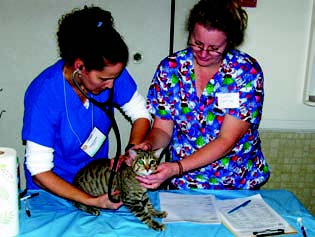
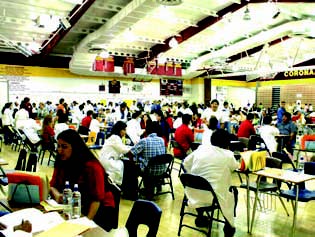

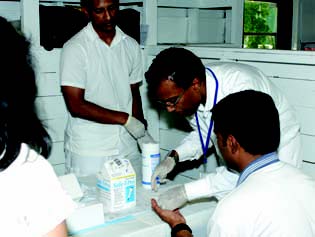
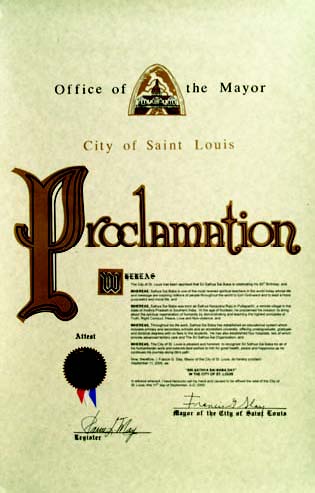
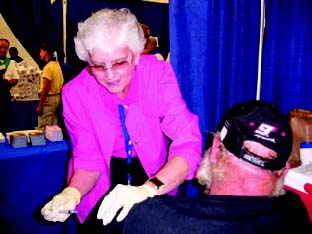
Central America
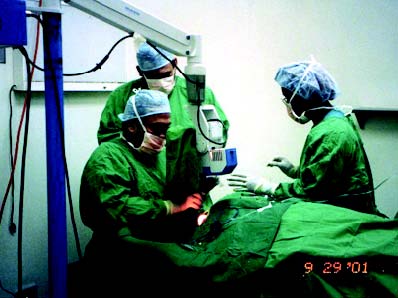
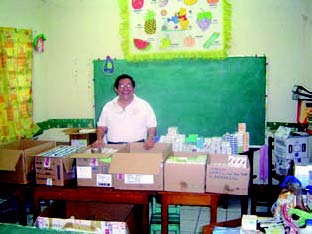
South America

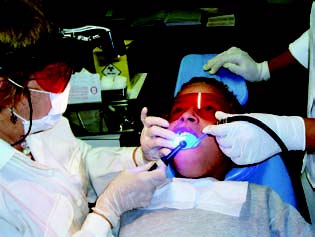
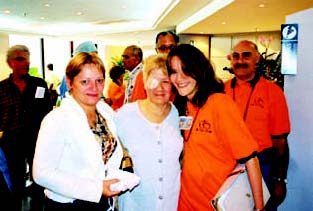
West Indies
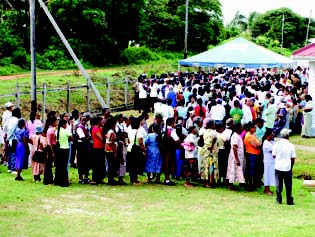
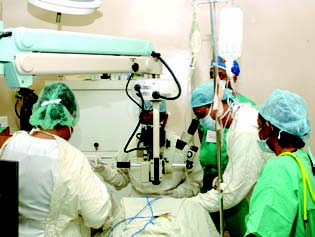
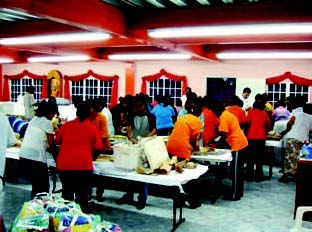
Europe
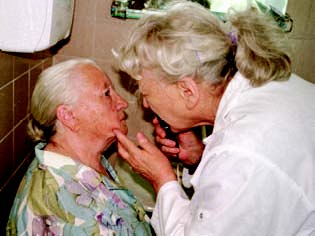
Russia and Russian-Speaking Countries
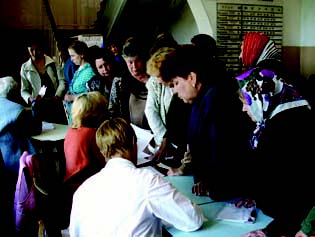

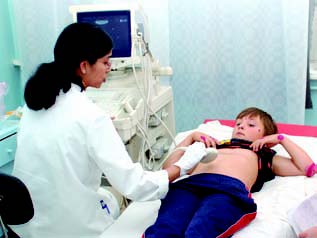
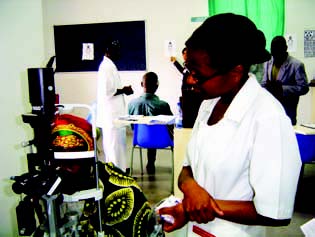
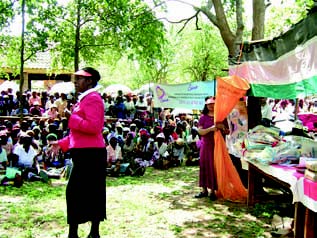
Middle East
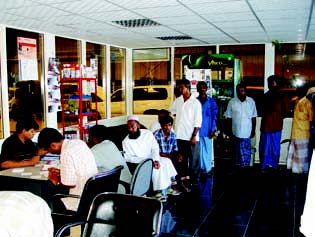
Asia
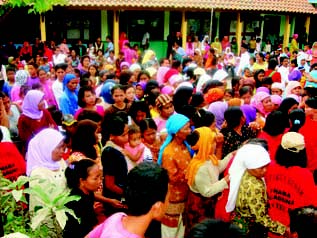

Australia, Fiji, and New Zealand
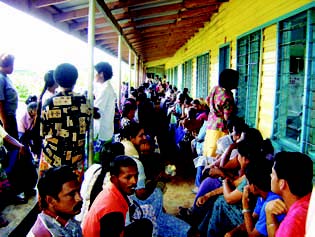

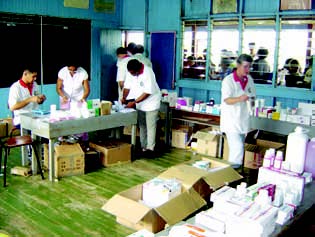
Medical Clinics
4
“The patients’ welfare must be your topmost priority. Serve them with dedication. Service to patients is service to God. There is no service higher than this.”
–Sri Sathya Sai Baba, 2003
The provision of free medical care for the uninsured and underinsured is something that is much needed throughout the world irrespective of the perceived financial status of a given country. In the developed countries such as the United States and the United Kingdom, the number of people who need help for their medical care, not only from a financial perspective but for several logistical and psychosocial reasons, is enormous. As in underdeveloped countries, in certain areas of developed countries, there is a shortage of healthcare professionals and medical services.
Sri Sathya Sai Baba’s teachings on the importance of love while caring for patients, is the hallmark of Sri Sathya Sai Organisation. A number of medical clinics have been established in several countries that reflect His message of unconditional love and the Sai ideal of providing medical care free to all irrespective of race, ethnicity, gender, or nationality. The health-related services that are being provided in the medical clinics include health screening, health education, immunisations, and medical treatment (both acute care and ongoing medical care). In additional, dental clinics have also been set up in certain countries.
The Sai ideal of having a universal, loving, comprehensive, preventive, and most importantly free health care system is needed everywhere. The hope is that many such clinics will be established wherever there is a need and that all patients will receive unconditional service.
North America
USA
Since January 8, 2005 in the heart of Oakland, California, the Ashland Free Medical Clinic (AFMC) has been providing free medical care for patients who do not have health insurance and cannot afford medical care. On May 3, 2007, the AFMC was recognised for its selfless community service. On behalf of all the volunteers at the AFMC, Dr. Joseph Phaneuf, Medical Director, received the Sidney R. Garfied, MD 2007 Exceptional Contribution Award from Kaiser Permanente, a large health maintenance organisation in California. A presentation followed which explained how this clinic was inspired by Sri Sathya Sai Baba’s model of free health care in India. On May 5, 2007, a video of the Ashland Free Medical Clinic was shown to approximately 500 Kaiser Permanente physicians, along with their spouses and children. The AFMC provides adult primary care services, dermatology specialty care, health education, free laboratory testing, and free medication every Saturday. At present, 18-29 patients are seen each time; there were 914 patient visits in 2006, 1,232 patient visits in 2007 and 1,162 patient visits in 2008. Over 100 volunteers from the Sathya Sai Baba Organisation have served at this clinic as physicians, nurse practitioners, receptionists, clinic coordinators, Spanish interpreters, and are responsible for administrative duties and the day-to-day operation of this clinic.
Central America
El Salvador
Ever since 1993, a rural medical service on a monthly basis was initiated with the participation of six medical doctors and several volunteers of the Sathya Sai Organisation. General medical services are provided and free medication disbursed as needed to about 120 patients per clinic.
San Salvador Since 1997, a free nursing home for physically challenged individuals has been run by the Sathya Sai Baba Organisation in San Salvador. On April 1, 2006, a permanent Sathya Sai Medical Clinic was inaugurated at this site and it provides free medical care to patients on an ongoing basis while continuing to care for physically challenged individuals. The home has both sleeping quarters and workshops for the invalids where they learn different occupational trades such as watch repair, wheel chair repair, shoe repair and shoe manufacture, appliance repairs, and baking. There are 20 men living in the home at all times. A fully equipped pharmacy housed in the clinic also provides free medications as needed.
Santa Tecla A medical clinic for general medicine in Santa Tecla offers free medical care once every month with the participation of two medical doctors. They see about 60 patients every month. This service has been running since 1998. Food is provided to families that come for medical treatment.
Mexico
Since January 2001, in one of the poorest and most populated neighborhoods of Iztapalapa district in Mexico City, the Sathya Sai Baba Organisation of Mexico has run a medical dispensary, free of charge. This dispensary was established by the Mexican Sri Sathya Sai Foundation to serve the residents suffering from severe lack of medical services and hospitals. At present, the doctor’s office has basic and essential medical equipment; the services are provided by a general doctor, a nurse, and a dentist. In addition, the health secretary and the municipality office offers the temporary services of a second general doctor.
The dispensary operates Monday to Friday, from 10 am to 5 pm and offers medical services completely free of cost. Patients with different conditions such as respiratory and gastrointestinal diseases and a high percentage of pregnant women are treated. On average, about 500 consultations are provided each month. Other services rendered by the dispensary are dental care for children; health education for families on nutrition, purification of drinking water, and dental hygiene; promotion of hygiene through cleanliness campaigns; and supply of medications, clothes, and basic provisions. Care has been given to about 20,000 patients in the last several years.
A dispensary was opened on April 9, 2009 in Saucito, San Luis Potosí and is open five days a week. Medical services are provided by physicians and nurses. Currently more than 200 patients are seen per month and medications are provided free of charge.
Panama
In the last six years, more than 200 cataract surgeries and 80 hernia operations have been performed free of cost. In 2005, 80 cataract surgeries were performed for patients in the city of Colon. The minister of public health has offered the Sathya Sai Organisation space in the Santo Tomas hospital in Panama City to set up a Sathya Sai eye clinic for cataract operations.
Since 2006 a paediatric clinic is held every month in Los Abanicos, a neighbourhood of poor people and in 2009, clinics were started in three additional communities.
South America
Argentina
In San Marcos Sierra, general medical consultation services are offered on a monthly basis, with the participation and collaboration of 7 to 12 medical practitioners from different cities and towns such as Neuquén, Córdoba Capital, Rio Cuarto, and La Falda. On average 20 patients receive free medical service every month.
Permanent Doctors’ Offices The Sathya Sai Organisation has permanent doctors’ offices where medical services are offered on a monthly basis; they are located in the Buenos Aires Province, and in the San Marcos Sierra facility in the Cordoba Province. In addition to the medical services provided in these locations, patients are also offered free medications.
Vision health Since this service was inaugurated on October 15, 2005, in Grand Bourg, Province of Buenos Aires, more than 1,500 prescription eyeglasses have been prescribed and given to patients.
Brazil
A free dental clinic was established in August 2005 by Sathya Sai volunteers in Sao Paulo, Brazil. This clinic runs for three hours every Tuesday and sees poor children between the ages of 6 and 12 years. The goal is to provide loving preventive dental care and dental treatments when required. During the first six months, 82 fillings, 20 tooth extractions, and 4 dental surgeries were carried out. The perennial love of the volunteers and the overwhelming appreciation by patients’ families keep volunteers committed to the clinic.
Colombia
The Sathya Sai Organisation has conducted several medical camps in Bogota in the past, and in February 2006, a permanent medical clinic was inaugurated at the Institute for Human Values building. Seven Sathya Sai doctors conduct four clinics every weekday free of charge. From the inauguration until December 31, 2006, 1,567 patients were seen and 31 volunteers have been trained for delivering first aid. Operating concurrently with the medical clinic in the same building, in 2008, the clinic provided more than 1,630 medical consultations to patients.
Peru
A Sri Sathya Sai School with a free medical clinic was inaugurated on March 23, 2005 in a poor rural area on the outskirts of Ariquipa, Peru, in the presence of the honourable mayor of Ariquipa and the deputy mayor of Ariquipa.
Venezuela
Sathya Sai doctors operate in a local eye clinic on Sundays. There have been over 120 cataract operations to date, with lens implants given completely without cost to the patients. These people are so grateful because finally they can see again and be useful in the society.
Africa
South Africa
Optometry continues to be a highly successful programme of the Sathya Sai Organisation. A team of committed optometrists and volunteers run clinics on virtually a weekly basis, providing eyeglasses to the destitute and the poor, allowing them the rare gift of vision.
Middle East
Abu Dhabi
A free Sathya Sai Medical Clinic operational every Sunday and alternate Fridays, offers services, medicines, annual physical checkups, and laboratory tests to approximately 120 patients each time.
Asia
Indonesia
A free cataract clinic was organised in Surabaya in February 2006. At the opening of the clinic, 388 patients were seen, and 112 of them were deemed as requiring cataract operations. The first surgeries were conducted on February 4, 2006 and were followed by more surgeries every weekend.
Sri Lanka
Hospice The Sri Sathya Sai “Suva Sevana” is a cancer hospice opened in July 2002, with the noble objective of treating and nourishing terminal cancer patients, and inculcating love in them in a multi-religious environment. Located in the most spiritual of surroundings, the atmosphere at the hospice is permeated with Divine Love and provides facilities for 50 patients. There are two separate wards for male and female inmates. At present there are 20 residents, and except for one, all are above 50 years of age. A doctor and a support staff of about 10 look after the patients at this hospice, and the patients are taken to the government cancer hospital for regular treatment.
Vietnam
The Sathya Sai Huong Van Health Centre was opened in the historic capital city of Hue, Vietnam on December 22, 2007. The two-storey health centre was built to serve an estimated population of 10,000. The goal is to provide primary healthcare, health education, prenatal and neonatal care, immunisations, treatment of malaria and tuberculosis. During the opening ceremony, local Vietnamese officials expressed their gratitude to the Sathya Sai Service Organisation for providing free health care facilities to the needy.
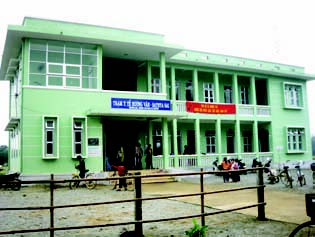
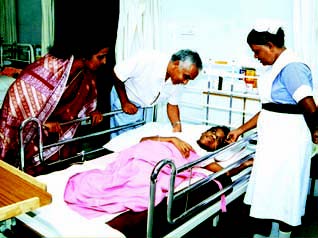
Disaster Relief
5
“It is essential that doctors should have the sterling virtues of love and compassion.”
–Sri Sathya Sai Baba, January 21, 1994
Natural disasters often cause widespread devastation affecting the individual, community, and society. To provide immediate assistance to the victims of such calamities, a proactive and broad approach is necessary. A comprehensive assessment of needs is required, not only at the individual level, but also at the family, community, and societal levels. These needs can be categorised as (a) medical needs, which encompass the physical, emotional, and psychological aspects, and (b) non-medical needs, such as proper shelter, sanitation, clean drinking water, healthy food and education, as well as spiritual and socioeconomic assistance. The need can also be designated as short and long term.
Whenever natural calamities have caused havoc to human life, the Sri Sathya Sai Organisation has been extremely responsive in providing assistance to the affected population. Under the direction and guidance of the Sri Sathya Sai Organisation in India and the International Medical Committee, teams of volunteers have quickly reached the affected areas, assessed the needs, and developed plans. The relief teams were composed of members in the medical, paramedical, and non-medical fields.
Medical services included administration of first aid, treatment of acute and chronic conditions, and eye care with the provision of eyeglasses. More importantly, because of the sudden catastrophic nature of such calamities, grief counseling was given to the affected individuals, families, and large groups. This allows the individual, the family, and the community to emotionally cope with the situation and move on with their lives. Non-medical relief included the provision of food, clean safe drinking water, shelters, sanitation, clothes, blankets, bed-sheets, cooking utensils, lighting supplies, and other basic necessities. Community-level needs were also addressed. These were mainly to reestablish educational infrastructure and provide school supplies. Tools of the trade such as sewing machines, bicycles, woodworking tools, etc., were provided so that people could return to their normal lives. All activities were carried out with an undercurrent of Divine Love, humility, compassion, empathy, and respect for the distressed. Below are summaries of several disaster relief activities organised all over the world.
India
Andhra Pradesh: Visakhapatnam District
Gurudev Express Train Accident The district rendered noteworthy assistance to the passengers of the Gurudev Express that had an accident at Duvvada on June 11, 2007. Sathya Sai Youth and other volunteers evacuated the passengers from the derailed railway cars and took them to the emergency relief camp. They put the injured in ambulances for further treatment in various hospitals. They also collected the luggage and handed it over to the owners and deposited the unclaimed luggage with railway authorities. They distributed about 6,000 water packets to the passengers at the accident site and relief camp and provided food and other assistance to the patients and attendants till their hospital discharge.
Bihar
Dirpul (Flood Relief) This is a story of what unfolded in one of the most-populous states of India—Bihar—in August 2008. Each year, the river Kosi flows into the inhabited lands of Bihar and destroys crops and property. On the night of August 18, the river broke its embankment at Kusaha in Nepal and through a huge 2-km breach in the dam a huge wall of 22 feet of water started rushing in furiously and washed away everything: buildings, people, cattle, castles, trees, etc. that were in its way. Thirteen districts were affected, but in four districts the damage was severe with Supaul being the worst.
The New York Times reported it as the worst flood in the area in 50 years; the headline pronounced: “Millions Displaced by Floods in India.” The prime minister of India declared it a “national calamity”. The Indian army and non-governmental organisations operated the biggest flood rescue operation in India in more than 50 years. More than 2.3 million people were stranded. At least 247,000 acres of wheat and rice paddy farmland were destroyed. Over 800 villages were destroyed and over 1,000 people lost their lives. It was unprecedented, unexpected, and the most severe devastation the state had seen in half a century.
Sathya Sai Organisation Response Members of the Sathya Sai Organisation of Supaul rushed to the site of devastation. They used motorcycles to immediately ride towards the affected areas and the sights they saw were staggering. They returned and immediately started preparing for relief work. The government and other non-governmental organisations, which were ill prepared for a calamity of such magnitude, were still trying to come to grips with the situation. Meanwhile, the spirited Sathya Sai volunteers collected essential food items and on the night of August 21 served more than 2,000 people. They went into villages that were completely isolated and difficult to approach. In fact, it was so risky to visit those remote pockets of inhabitants that the police were stopping people from entering those areas. However, Sathya Sai volunteers were not afraid and the Sathya Sai Organisation was the first to start relief work in this area. Loaded with poha (beaten rice), jaggery, biscuits, milk, salt, candles, bread, clothes, and medicines, these supplies were distributed to the various villages. Twenty volunteers served from 9 at night till 4 in the morning with the help of torches. They located every individual seeking help in the destroyed zone of Supaul and offered them food and clothes. Overwhelmed with gratitude, the flood victims thanked the volunteers of the Sri Sathya Sai Organisation for their unconditional love.
Orissa
2008 Floods Orissa witnessed one of the most severe floods in the last 40 years in September 2008. Out of 30 districts of Orissa, 18 were severely affected by floods. In this time of calamity, Sathya Sai workers worked day and night to save, feed and console flood victims. Relief in the form of dry food, cooked food, tarpaulins, drinking water, clothes, medicines, and other articles of daily need was provided to hundreds of thousands affected by the floods. New houses to homeless people were provided by the Sathya Sai Organisation.
Coromandel Train Accident On February 14, 2009, the Coromandel Express had a serious accident at Jajpur. Sri Sathya Sai Seva Organisation of Orissa, whose members were at a nearby Sai Mandir, responded immediately. A team of 60 members of the Sathya Sai Organisation carried the injured to the Sai Mandir. They saved lives, donated blood, and rescued trapped passengers.
Tamil Nadu
Disaster Relief Training Since 2005, Tamil Nadu has been actively providing disaster management training to the youth in Tamil Nadu. Recently the Sathya Sai Organisation was called upon to impart similar training to police inspector trainees at the newly inaugurated Tamil Nadu Police Academy, Vandalur, near Chennai. The trainees enthusiastically participated in the various emergency methods of rescue, first aid techniques, and practical demonstrations in fire fighting. The police officers and trainees were impressed by the commitment and dedication of the entire team of trainers of the Sathya Sai Organisation.
2008 Floods Many areas of Chennai and its suburbs were flooded in the wake of cyclone “Nisha” from November 27-30, 2008. Many low-lying areas and slums in the Kancheepuram and Thanjavur Districts were also flooded because of incessant rains. The Sri Sathya Sai Seva Organisation of Tamil Nadu immediately swung into action and provided food packets and drinking water to the affected people. A total of 1,522 volunteers participated in this service activity and distributed more than 10,000 food packets daily for three days to alleviate the suffering of the people who were completely stranded.
North America
USA
Hurricane Katrina On August 29, 2005, Hurricane Katrina made landfall in the State of Louisiana as a category 4 hurricane. It cut a swath of destruction that was the worst in American history over the last 100 years. It devastated the central Gulf Coast States of the United States. Cities such as New Orleans, Mobile and Gulfport bore the brunt of Katrina’s force. Its impact was far reaching, resulting in loss of life, property destruction, disease, and destruction of vital oil and water pipelines, which affected the national economy. Devastation by Katrina was immediately followed by Hurricane Rita that made landfall on September 24, 2005 causing widespread damage to Southern Louisiana and Southeastern Texas.
In response to these national tragedies, several volunteers from the Sathya Sai Organisation quickly prepared themselves and began rendering immediate aid. Several Sathya Sai volunteers underwent Red Cross training. Refugee families were adopted by local Sathya Sai Centres and were provided food, clothing, shelter, utensils and transportation. Children of all ages helped to pack 500 toiletry bags and, along with adults, helped take care of needy children. Family counseling services were also provided. Hurricane Rita had caused extensive damage to Jasper, St. Augustine, Newton, Sabine, and Tyler counties in Texas. On December 3, 2005, Sathya Sai volunteers especially several young adults who took leadership roles visited these areas to deliver 636 care packages consisting of bottled water, blankets, fruits, gloves, socks and other essential items. Personal visits were made to 140 homes on that day. On the same day, Sathya Sai doctors visited several homes to examine children and the elderly. A medical screening was set up to see patients and prescriptions were filled for them because they had lost their medications and/or their prescriptions, and the clinics they were attending were closed indefinitely. As part of the relief efforts, Sathya Sai volunteers have provided refrigerators and freezers to a food pantry and more than 300 school children have received shoes, socks and winter coats. In addition, assistance has been given to rebuild homes devastated by the hurricane.
Hurricane Rita Jasper, a small town in the state of Texas, was hit by Hurricane Rita. Six months later, the population was still recovering from the destruction and waterborne diseases resulting from the hurricane. In response to this major calamity, Sathya Sai volunteers from the Sathya Sai Centres in the states of Arkansas, Oklahoma, Texas, and Louisiana, working together selflessly, conducted a medical camp on February 4, 2006 providing free medical care to the needy. During this camp 400 patients were seen and preventive health screening was done for diabetes, hypertension, osteoporosis, etc. Groups of volunteers visited a nearby nursing home for the elderly and provided love and care to the residents.
Central America
El Salvador
Earthquake Relief �����������������������������������In 2001, Sathya Sai volunteers provided food and clothing along with medical relief immediately to the remote community of Talpetate after the region had been ravaged by two earthquakes. Medical service and food was provided to Guadalupe, a town that was also destroyed during the same earthquake. There were 6 medical camps held within 2 weeks of the quakes, including one where the healthcare team had to embark on canoes to get to an island in the Gulf of Fonseca in order to help the needy inhabitants. They were extremely grateful to the Sri Sathya Sai Organisation for their prompt response.
Mexico
Floods of 2007 Tabasco and Chiapas are agricultural states located on the Gulf of Mexico. Over a million people were left homeless after a week of torrential rains and floods damaged the towns in October 2007. A medical camp was held immediately following the disaster in the village of Villahermosa from November 9-11, 2007. Local government officials welcomed a team of Sathya Sai volunteers, including physicians and support personnel, at the airport and escorted them to the camp site, where the municipal president greeted them. During the three-day medical camp, 445 patients were seen and treated for acute waterborne illnesses. In addition, preventive health measures and health education were provided. The people, including government officials, were deeply moved and grateful for the loving selfless service rendered by the team of volunteers from the Sathya Sai Organisation.
South America
Peru
2007 Earthquake On August 15, 2007, an earthquake with a magnitude of 8.0 on the Richter scale hit the coast near Lima, killing 514 people and injuring 1,090. Over 35,500 buildings were destroyed. Sathya Sai volunteers visited the town of Centro Poblado La Garita, 213 km south of Lima, on September 1, 15, and 29, 2007 to render help because the town was completely destroyed by the earthquake. About two tonnes of food, water, clothing, and 248 heavy blankets were transported to the town through roads that were partly destroyed by the calamity. Sathya Sai volunteers set up five pre-fabricated homes for the displaced families. During the construction, some of the volunteers played with the children and talked to them to allay their fear and grief from the calamitous event. A workshop on proper nutrition with emergency rations was held, teaching them to use locally grown green vegetables and the donated soy beans for protein. Personal hygiene kits were distributed to 150 people. In addition, toys were given to children.
The local newspaper, La Verdad del Pueblo, reported on the care and love that people had received from the Sathya Sai Organisation.
Post Disaster Recovery Efforts For more than 16 months, Sri Sathya Sai Organisation of Peru has continuously provided tonnes of food, clothes, personal hygiene items, school supplies, wooden houses, etc., in the towns of Pozuelo, Chincha Baja, Magdalena, and Mariposa, which were severely affected by an earthquake on August 15, 2007. Sri Sathya Sai Organisation conducted several workshops on self-management, making stuffed toys for the children, preparing soy-based food products, and providing healthcare. Education in Human Values (EHV) workshops were also held. The children and adults of these towns were inspired by the EHV workshops. Medical services were provided free of charge, and free medicines were also provided to hundreds of people.
As a follow-up to the relief provided to the earthquake victims of La Garita in September 2007, Sathya Sai volunteers visited the devastated villages again on October 14, 2007. Eight hundred notebooks and pencils were provided to the children of a school in Chincha. Large quantities of food were distributed to the people of La Garita, and the sick were tended to in a Sathya Sai medical camp conducted by three internists, two gynaecologists, and three dentists. A total of 142 patients were given free and loving medical care. The follow-up and selfless service by the Sathya Sai volunteers was comforting to the earthquake victims.
Governmental Acknowledgment The mayor of the district of Chincha Baja, Emilio del Solar Salazar, praised the work of Sri Sathya Sai Organisation of Peru and presented the Medal of the City, in acknowledgement of the selfless service activities carried out by the Sathya Sai Organisation in various towns of the region. The medal is inscribed: “Medal of the City, District Municipality of Chincha Baja, presented to Sri Sathya Sai Trust of Peru.” Emilia Tapia, Principal of Pozuelos also admired the services of the Sri Sathya Sai Organisation.
Europe
UK
Sri Sathya Sai Organisation has provided clothes, essential household and medical items during the following disasters: (1) Orissa cyclone; (2) Gujarat earthquake; and (3) Sri Lanka Tsunami.
Russia
Floods of 2003 An international medical camp was held to help rebuild a town destroyed by severe floods in Kochubeevsky district of the Stavropolsky Region (Cossack villages Barsukovskaya, Nadzomoye, Zurabovka, and others) from June 27 to July 5, 2003. More than 200 members of the Sathya Sai Organisations of Russia, Ukraine, Belarus, Kazakhstan, the UK, Germany, Poland, and other countries took part in it. Approximately 8,800 people were examined by the medical team, and a further 1,250 patients received eye consultations and treatment. The nearby medical college invited the team leader to address local doctors about the uniqueness of the Sathya Sai vision in providing compassionate, selfless service combined with the best medical technology to the remotest corners of the world.
Rebuilding of the city The whole team worked together tirelessly in rebuilding a new school, an orphanage, and a prayer hall for the local people. Repair and construction work was also done in the hospital and the ambulance station, as well as in the houses of the elderly and the disabled. It was indeed inspiring to see the commitment of the local volunteers. Some of them had travelled long distances from the Ural Mountains (Siberia) and had taken five days to get to the disaster area. Concerts were held for the patients and the local population every day.
Asia
China
When a major earthquake struck the region of Sizhuan in 2008, the Sathya Sai Organisation responded immediately by sending 200 tents, 3,000 blankets, drinking water and bags of rice to the disaster victims.
Indonesia
2004 Earthquake In February 2004, an earthquake hit Karangasem village of East Bali. Sathya Sai Centres around Bali took up relief work for the distressed families by providing medical aid to the villages. Over 500 patients received medical care through these efforts. Several medical camps have been held since then: Bangli (155 patients); Sidetape and Kayuputih (500 villagers); remote areas of Palu in Sulawesi Island (95 people); and Tabanan village (150 people).
2005 Earthquake The world’s second-largest earthquake since 1964 (8.7 on the Richter scale) struck Indonesia on March 28, 2005. In responding to the massive disaster at Nias Island—North Sumatra, the Sathya Sai Study Groups of Jakarta and Medan dispatched a total of 14 cartons consisting of medicine and medical equipment to the victims in April 2005. One of the cartons containing 202 boxes of Vaccine anti-tetanus serum was delivered urgently to the general hospital in Gunung Sitoli (capital City of Nias Island).
Many schools were badly damaged, and children were left with no books or stationery to resume their study. In responding to this situation, Sathya Sai Groups organised a distribution of stationery and books on June 18, 2005, to Primary and Junior High School in Yayasan Budi Bhakti at Gunung Sitoli, capital city of Nias Island. Large quantities of writing pads, books, pencils, pens, rulers, and erasers were supplied to the schoolchildren. On July 3, 2005, food was distributed to 320 families. Each family received 5 kg of rice, eight packs of instant noodles, one bar of bath soap, and two pieces of cloth.
2006 Earthquake A massive earthquake measuring 6.3 on the Richter scale, struck the island nation of Indonesia early in the morning on May 27, 2006. This caused several thousand deaths, injured over 15,000 people and caused a million people to lose their homes. The quake was centred in the Indian Ocean about 38 km to the south of Yogyakarta at a depth of 33 km under the ocean. The members of Sri Sathya Sai Organisation of Indonesia sprang into action to provide immediate relief to the earthquake victims. Twenty-two Sathya Sai volunteers formed four teams and reached Yogyakarta the next day, along with much-needed medicines.
Comprehensive Disaster care On May 28, medicines were distributed to two hospitals, namely, Dr. Sarjito Hospital in Yogyakarta and Cakra Husada Hospital in Klaten. Medicines were distributed at these two hospitals, including thousands of antibiotic doses, syringes, bandages, and other necessary medical items. The distribution of food, clothes, and stoves was carried out in other afflicted areas. On the second day after the earthquake, the teams distributed emergency supplies including 40 tents, and hundreds of pieces of clothing. On the third day, 3 trucks full of supplies (consisting of over 3 tonnes of rice, 1,000 bottles of water, clothes, and other essential items) reached the area for distribution. In addition, over 3,000 mosquito repellants were distributed.
On the fourth day, two mobile medical teams began making house-to-house visits supported by another stationary team, helped by 10 youths who also started setting up kitchens. By the fifth day two public kitchens began feeding the hungry, as more supplies arrived, including 1½ tonnes of rice and more household supplies. Three hygienic public kitchens were set up in the areas of Klaten, Imogiri, and Gunung Cilik, and remained open till June 29, 2006. Fresh vegetables were supplied daily to the base camps from the Sathya Sai Centre in Yogyakarta. The volunteers, with the help of the local villagers, worked round-the-clock and served with love three meals a day for thousands of people.
Ongoing care Over the next few days, six medical teams were working to aid the survivors. Over 2½ tonnes of rice were given out and 50 stoves and many essential food and household items were distributed. Building materials, tools and volunteers arrived to help in rebuilding homes and 80 new homes were built. Thousands of items of clothing were distributed, including 10,000 pieces of clothing and 2,500 blankets donated by a company run by volunteers. By June 14 as many as 1,070 victims had been medically treated by Sathya Sai volunteers who also provided shelter and clothing to the homeless. The Sathya Sai Organisation also provided the finance and human resources for nine houses in the district of Bantul. In addition, they gave much-needed emotional support to the traumatized survivors. The Sathya Sai Study Group of Medan, Indonesia, also joined in the relief work and helped the victims.
Rebuilding of the community On June 3, 2006, Sathya Sai Organisation volunteers from Jakarta began building facilities to manufacture bricks for reconstruction of the many homes that were destroyed. The flow of relief materials, food, and clothes accelerated. On June 4, 2006, the Sathya Sai volunteers from Bali constructed many tents to house homeless victims. Working with the Sathya Sai Youth, they began reconstruction of the damaged homes. On June 5, rebuilding and rehabilitation work was initiated by Sathya Sai volunteers in several villages, and the Sri Sathya Sai Central Council provided financial aid, building materials, and financial resources to rebuild homes.
As this disaster relief was being rendered, on July 17, 2006, the southwestern coast of Java was again hit by a tsunami. The Sri Sathya Sai Organisation again rose to the occasion. Office-bearers visited the devastated areas, assessed the damage, ascertained the needs, drafted a plan to provide the urgently needed humanitarian aid, and began, without delay, to implement the plan.
Aceh Floods The province of Aceh in Indonesia has witnessed several natural disasters that have shocked the world and, at the same time, brought the world together in an unprecedented bond of compassion and solidarity. Unrelenting rain, floods, and devastation, displaced over 87,000 inhabitants and 23 people lost their lives. The flooding caused widespread damage to crops, plantations, cattle, poultry, fish ponds, roads, and bridges. Over 1,600 houses were completely destroyed, and more than 15,000 houses were damaged. The Sathya Sai Organisation sprang into action to provide immediate relief. Evacuation camps were set up for the displaced, and rescue operations were mobilised immediately. On January 14, 2007, service was rendered to Bukit Tempurung village in a subdistrict of Aceh Tamiang, where food was distributed to 1,065 households. It took 14 volunteers about four hours to drive each way to deliver the rations, including food, medications, sanitation facilities, and potable water.
Jakarta Flood, 2007 The capital city of Jakarta has repeatedly suffered natural calamities over the past years including a major flood that ravaged the city on February 10, 2007. With compassion and love, the Sathya Sai Organisation responded promptly on February 11, 2007, by coming to the aid of villagers stranded in Cakung. About 300 families were rendered homeless due to the floods and sought refuge in metal containers and concrete culverts. The Sathya Sai volunteers distributed food and potable water to these people. By February 14, 2007, the water levels had subsided, and the people were returning to their demolished and flooded homes. Sathya Sai volunteers donated mops, brooms, and pails while working with the victims to help restore their homes. Once the homes were habitable, on February 17, the volunteers distributed gas stoves, rice, and drinking water. An acute care medical camp was set up to look after patients with pulmonary and gastrointestinal disorders due to the floods and poor living conditions. The camp continued until March 11, 2007. Extensive insecticide spraying and water supply disinfection was carried out. Families were given mosquito repellants and coils. Flood victims were touched by the emergency relief provided with love by the Sathya Sai volunteers.
During a medical camp held in April 2007 (the fourth camp within a span of two months), 200 patients received medical care.
2007 Earthquake On September 12, 2007, an earthquake struck southern Sumatra in Indonesia with a magnitude of 8.4 on the Richter scale. This was followed over the next several days by earthquakes of magnitudes 7.8 and 6.7. About 88,000 houses, 2,000 educational facilities, and 620 health facilities were damaged by the earthquakes. In immediate response, Sathya Sai volunteers in Bengkulu distributed 2,000 kg of rice to 300 families in the villages of Lubuk Tanjung, Pasar Palik, and Tebing Kandang on September 16, 2007.
2009 Jakarta Fire A blazing fire on January 25, 2009 in Jakarta affected 133 families, and about 580 people were rendered homeless. Between January 26 and February 2, 2009, volunteers from Sathya Sai Study Group, Jakarta rendered loving service to all these people. Food was served on a daily basis. Approximately, 3,800 meals were served. Clothing and hygiene supplies were distributed, and school supplies and backpacks were distributed to children. On January 27 and January 30, 2009, doctors and Sathya Sai volunteers provided medical services for common ailments to approximately 95 people. Sai Spiritual Education (SSE) children and Sathya Sai Youth also participated in this selfless service activity, which touched the hearts of many people.
Myanmar
Sri Sathya Sai Baba Village On May 2, 2008, tropical storm Nargis hit Myanmar’s capital city, Yangon, and a large portion of the Ayerawaddy delta region. An estimated 200,000 people died, and an estimated 2.5 million others were affected. At the invitation of the Myanmar government, the Sathya Sai Baba Central Council of Malaysia (SSBCCM), with the help of volunteers from Singapore and Thailand, undertook the monumental task of building 51 new homes, a temple, and a school, to create a new village called “Sri Sathya Sai Baba Village.” The village was inaugurated on December 21, 2008.
The Myanmar government was touched and impressed with Sri Sathya Sai Baba’s mission and promised its full cooperation. The village was to be constructed in a remote area, about an eight-hour boat ride from Yangon, far from any towns, shops, roads, electricity, or facilities. Construction took place from July to December 2008. For the new village’s opening ceremony, officials from the village, the army, and schoolchildren gave a rousing welcome to SSBCCM volunteers. A big picture of Sri Sathya Sai Baba adorned the main wall of the school building, and the front wall of each house exhibited a Sarva Dharma (all faiths) symbol.
Sri Lanka
Post-Tsunami Housing Project: Volunteers in Sri Lanka have been working on providing housing for the most needy tsunami victims. The district of Hambantota is a set of villages located about 250 km southeast of Colombo, and it was devastated by the tsunami. Sathya Sai volunteers in Sri Lanka undertook a project to provide houses for those families. A total of 10 furnished houses were built and donated to families during December 2005.
Feeding the Children In a large cooperative effort by Sathya Sai volunteers of Ticino, Switzerland, and Sri Lanka, several container loads of milk and rice cereal have been distributed to malnourished children between the ages of one and five years in tsunami-devastated villages. This project has continued since the tsunami to the present day, and 254 children from several refugee camps have been given milk and rice cereal daily. The children are also visited by Sathya Sai physicians and screened and treated for any health-related problems.
Treating the Needy Sathya Sai Organisation in Sri Lanka carried out a massive service project to alleviate the suffering of those housed in refugee camps in the north and east areas of the island. There are five refugee camps in these locations with approximately 220,000 people, mostly from the Mannar, Killinochi, and Mullaithivu districts. Access was granted to the Sathya Sai medical teams to serve these people. Two medical camps were conducted over six days, during which approximately 5,000 patients were seen. The first medical camp was held from May 29-31, 2009 and the second from June 6-8, 2009. Approximately 40 volunteers, including doctors, nurses, pharmacists, first aid practitioners, volunteers, and youth took part in these camps. Sathya Sai volunteers constructed a 20-bed temporary hospital with a tarpaulin roof to care for the sick. In addition, mobile clinics were held to help patients who could not travel to the main hospital. Patients with complicated or serious illnesses were referred to nearby general hospitals. Free medicine and nutritional supplements were dispensed as needed. Patients received follow-up care, and patient education was provided at the medical camp. Fruit, infant milk powder, biscuits, and sweets were distributed to thousands of children. Many patients required special medicines for ailments such as heart disease or epilepsy. Sathya Sai volunteers collected such prescriptions, purchased the medicines, and distributed them to the patients. For several months, the Vavunia Sathya Sai Centre also distributed essential food items to hundreds of expectant mothers and small children.
Floods On a number of occasions the southern region of Sri Lanka was affected by floods. The Sathya Sai Organisation in Sri Lanka rose to the occasion by sending essential goods (food, clothing, etc.) to the affected areas. Truck loads of food for immediate consumption were supplied on each occasion when the affected areas were under water. Sathya Sai volunteers even risked their lives by going by boats to reach affected people to provide essential items.
In the aftermath of floods, at a time when diseases started spreading, medical camps were conducted in the badly affected areas. Over 500 hundred families benefitted from this project each time it was carried out.
Tsunami–Immediate Relief In the western zone, nearly 300 Sathya Sai volunteers served cooked meals to approximately 10,000 people in the worst affected areas in Modera (a suburb of Colombo) and the towns of Galle, Moratuwa, and Hikkaduwa. Three thousand parcels of cooked food, 35 crates of drinking water, toiletries, and clothes were transported to the eastern belt, which is about 160 km from Colombo. Four trips were carried out during the first week of the disaster.
In the northern zone of Sri Lanka, the coastal regions were severely damaged by the tsunami waves, and thousands of people had been displaced from their homes. One hundred eighty volunteers from the Sathya Sai Organisation served about 3,000 people with cooked food and clothing. They also provided medical services in the refugee camps for over five days. In total, 818 volunteers served 19,500 people during the relief operations in the immediate aftermath of the tsunami.
Housing Volunteers from the Sathya Sai Organisation in Sri Lanka undertook a project to build 10 houses in a remote village in Hambantota for tsunami-displaced persons. Each house is constructed on eight perches of land. The houses are constructed in accordance with government-approved standards. The floor area is 500 square feet and will include a toilet and kitchen. The houses will be provided with a water connection and electricity. In addition, the organisation provided each household with basic furniture and utilities (a transistor radio, bicycle, a two-burner gas cooker, crockery, etc.).
The Sathya Sai Organisation constructed two houses for displaced families in the village of Thelwatte.
A number of families who had been displaced from their homes as a result of the continuing civil unrest in the country and also affected by the tsunami had been living without proper shelter and access to water and sanitation. The Sathya Sai Organisation built six houses in different locations in the Jaffna peninsula and resettled the displaced families.
Self-Employment Project The village of Thelwatte is about 50 km south of Colombo. This is the village where a train was completely washed and dragged off the tracks and about 1,500 passengers were killed by the tsunami. The Sathya Sai Organisation donated sewing machines to seven families in the village and assisted five families with seed capital to start their own self-employment projects.
Fishing nets and Petromax lamps, kitchen utensils, clothes, and water pumps were distributed to 34 tsunami-affected fishermen in Veeranagar, Trincomalee.
Eight fishermen were provided with assistance to repair their boats and outboard motors.
With the objective of promoting self-employment, 24 poor women from Kuchchaveli village and Verugal village were provided with a sewing machine.
A group of six farmers from Verugal village and a poor family from Kuchchaveli village consisting of seven members were provided with two water pumps.
International Tsunami Medical Camps
The Sri Sathya Sai International Medical Committee initiated a disaster relief effort, providing medical treatment and counseling for the affected persons. Among the many relief missions from overseas, teams of doctors, nurses, and volunteers from the USA, Canada, Australia, and the UK under the Sathya Sai umbrella came to Sri Lanka and participated in a massive humanitarian effort. There were five such missions between January 5 and March 25, 2005. In these five missions 187 volunteers from the four countries listed above served 16,000 patients in several towns and villages in Sri Lanka.
Over the period of the mission the teams carried out the following tasks:
|
Task Performed |
Stats |
|
Cataract surgeries performed |
800 |
|
Chlorinated and purified drinking water wells |
6 |
|
Counseling adults and children (approx.) |
1,400 |
|
Distributed children’s clothing (approx.) |
15,000 |
|
Distributed milk powder to children and adults (approx.) |
1,800 |
|
Donated bicycles |
80 |
|
Donated carpentry tool sets |
50 |
|
Donated fishing nets |
300 |
|
Donated water tanks |
8 |
|
Installed water pumps |
12 |
|
Conducted medical camps for refugee population living in tents |
230 |
|
Performed orthopaedic and dental care (approx.) |
1,500 |
|
Screened schoolchildren and updated their health report cards (approx.) |
15,000 |
Upon completion of their mission, medical supplies, including medicines and medical equipment worth thousands of dollars, were donated to the hospitals for use by the local doctors where the teams had worked.
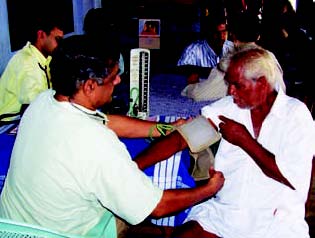
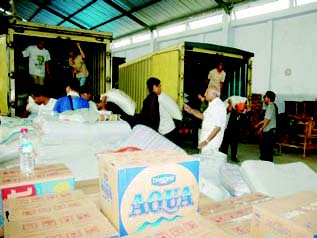
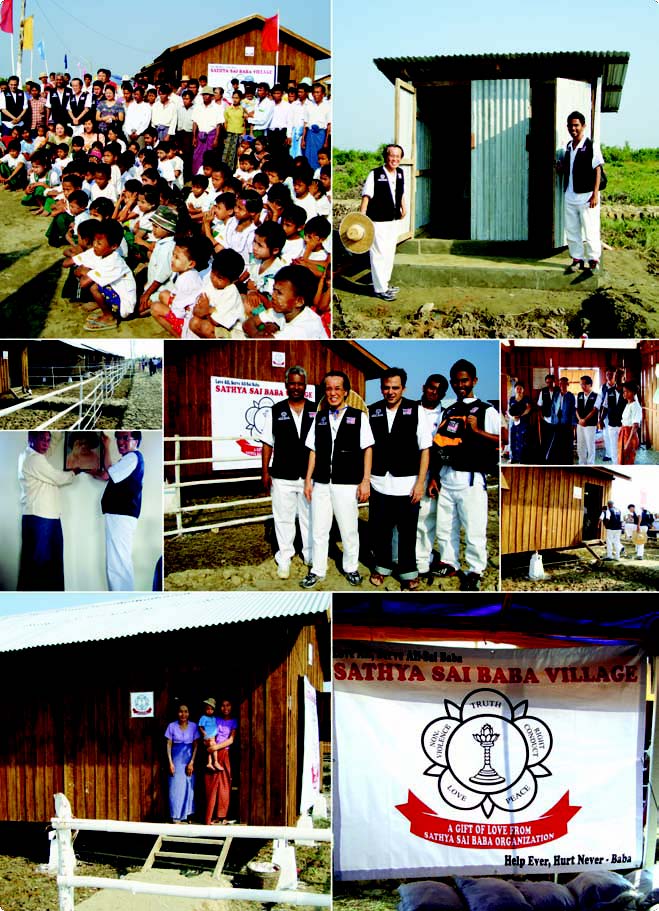
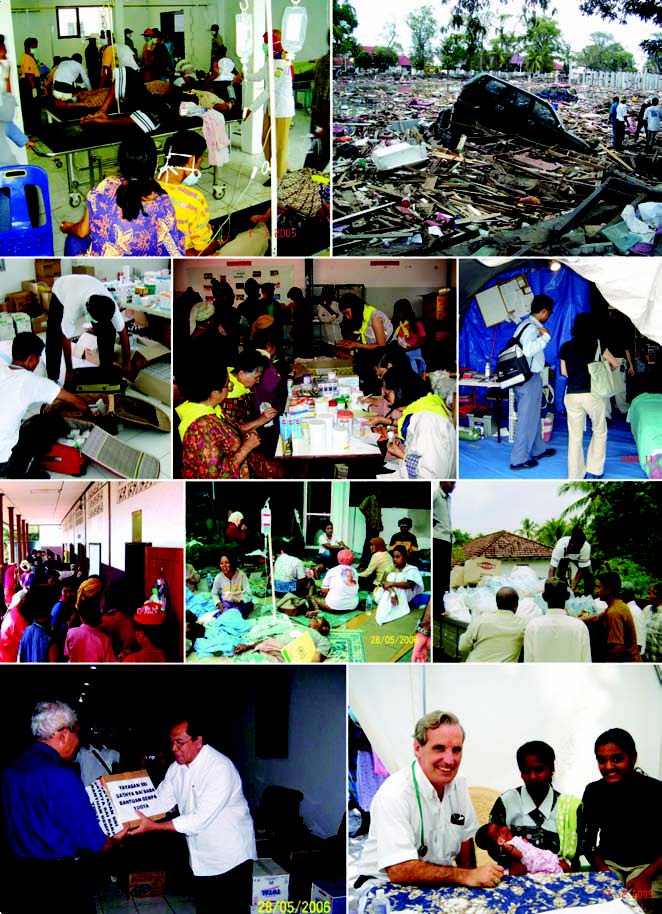
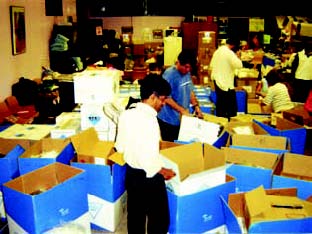
Rehabilitation Programmes
6
“One must continuously work. It is activity that confers authority. A doctor gains happiness in proportion to the work he puts in. The genuine doctor is one who delights in work.”
–Sri Sathya Sai Baba, January 23, 1994
People suffer from sequelae of illnesses and conditions that can be agonising and interfere with daily life even after they have gone through treatment processes. It is during this difficult phase of their life that they require specialised care that addresses their physical, psychological, and social well-being. In addition to medical care, these patients require empathy, love, and moral support to make them aware of their inherent potential and to rejuvenate their energy. By achieving this through the rehabilitation process, they will be capable of facing daily challenges and reconnecting with their life. It is the wish of Sri Sathya Sai Baba that healthcare should be universal, evidence based, and not only cure the disease, but also heal the body, mind, and spirit. Above all, it should be administered with love.
For millions of people worldwide, basic medical care is difficult to obtain. Therefore in such conditions, it is not easy to seek specialty care, such as rehabilitation treatments. Nevertheless, with empathy and love, Sri Sathya Sai Organisations worldwide have participated in rehabilitation programmes in countries such as India, Sri Lanka, the USA, Zambia, South America, Kuwait, and many others. Some groups created new programmes, whereas others participated in already established rehabilitation programmes that served a variety of health problems. One rehabilitation centre provided appropriate educational programmes to children with special needs, whereas another helped homeless and orphaned children stay away from the path to delinquency. In another rehabilitation programme, volunteers helped prison inmates learn to control their emotions and impulsive behaviour. Social support was also provided to the families of patients suffering from AIDS; it served as a reminder that disease and illness do not affect solely the patient but also the family. Expressing our care and concern while working with these patients reminds us that all those who are physically, mentally, and situationally disabled are not completely disabled; they can become functional if provided with the opportunity. Below are brief summaries of several rehabilitation programmes organised by Sri Sathya Sai Organisations all over the world.
North America
USA
Kentucky On July 6, 2008, Sathya Sai volunteers from the Sri Sathya Sai Baba Centre in Louisville, Kentucky assisted the American Council of the Blind (ACB) during their annual conference in Louisville. Following the instructions given by the coordinator for the ACB Chapter in Louisville (who is also visually impaired) the volunteers were to introduce themselves, and extend the left arm for the visually impaired individual to hold, and then walk normally. Most of the volunteers were involved in providing assistance with the registration, escorting the attendees to the lecture or exhibition halls. Some were involved in helping them find their rooms. The highlight of this conference was the fact that nearly 2,000 visually impaired attendees from every corner of the country including Hawaii were present. Approximately, a thousand seeing eye-dogs were also a part of this gathering. A remarkable observation was the absence of any barking from these seeing eye-dogs. The resilience, fortitude, and most of all a sense of humour displayed by all attendees were remarkable. Many of them were meeting each other after several years, and it was fascinating to see how they recognised each other from their voices. Indeed, there were a number of very interesting incidents that took place when the volunteers interacted with them. The volunteers thanked Sri Sathya Sai Baba for this unique service opportunity.
Central America
Costa Rica
Sathya Sai volunteers lovingly tutor mentally challenged children. Currently, there are two service groups: one group helps disabled children in a shelter, and the other helps people living with AIDS.
El Salvador
A home has been established that provides free living space for 20 disabled men in wheelchairs. Workshops are conducted so that they can have an independent livelihood.
South America
Colombia
For the past five years, the Laureles Sathya Sai Centre in Medellin has been working with children who are homeless and are addicted to drugs on the street. There are 29 children in the programme at present, and about 18 Sathya Sai volunteers participate. Some of the volunteers teach, while others prepare and serve meals for the children. They also provide education in human values (EHV) instruction once a week, and through constant interactions share Sri Sathya Sai Baba’s Love with the children. Many of these children have been motivated to return to school to study. This has resulted in their remarkable transformation from high-risk social delinquents to loving, responsible individuals.
Europe
Greece
On June 8, 2004, the Pindarou Sathya Sai Centre organised a celebration at the Institute for Chronic Illness of the Young, in Skaramanga. For the past 10 years, Sri Sathya Sai Organisation of Greece has been organising an annual spring celebration at the Institution for Chronic Illnesses in Agia Barbara, in the Aigaleo area of Athens. A team of volunteers regularly visits the elderly in nursing homes, spreading love and cheer.
Africa
Botswana
On July 31, 2004, in connection with Global Handicapped Day, Sathya Sai volunteers visited the Pudulogong Rehabilitation Centre for Blind Students at Mochudi, a town near Gaborone. The Centre donated two Braille machines and one copy of screen-reading software for the use of blind students. The Centre had earlier donated six Braille machines and one binder to this rehabilitation centre.
Nigeria
Since June 2005, Sri Sathya Sai Organisation of Nigeria has been running an orphanage called Sri Sathya Sai Seva Orphanage Home in Lagos. The orphanage currently has nine children between 4 and 13 years of age, of whom five are physically challenged. The orphanage home building has been completely renovated, and a weekly meal plan is prepared by consulting a nutritionist. The children are also taken to a nearby physician for regular health checkups. With the help of the efforts of the Sathya Sai Organisation, the physically challenged children who were once unable to ambulate are able to walk today.
Middle East
Kuwait
Many parents of low and middle incomes find it difficult to educate their children with special needs. In response to this, the Kuwait Sathya Sai Centre opened the School for Special Needs Children as a service project in 1998. The school presently has 18 children and 16 volunteers. Children between the ages of 4 and 16 who have conditions such as Down syndrome, autism, cerebral palsy, and other learning disabilities are admitted to the school. They are assessed with professional help before admission to decide their level of ability and their requirements and are then placed in different groups. The morning begins with prayers (and smiles) for these very special children, and the lessons are taught based on a structured curriculum.
Gross motor activities such as running, throwing, catching, and jumping are encouraged in the children through group activities. A range of fine motor activities is also carried out by the children to foster eye-hand coordination and to facilitate the development of small muscles. Skills to enable the children to be more independent are taught through steps like brushing teeth, washing, feeding, toilet training, personal hygiene, grooming, etc. Children are also encouraged to use all their senses—visual, auditory, taste, smell, and touch. They are encouraged to solve simple puzzles, gradually moving on to more complex cognitive skills such as problem solving and logical thinking. Reading, writing, and arithmetic are taught through conventional methods. Teaching aids such as videos and specially designed computer programmes are used to reinforce what is taught the conventional way. The volunteers teach art and crafts to the children as part of the curriculum and encourage students to perform cultural activities.
Asia
China
Service is performed by the volunteers and the youth team of Guangzhou at the home for the physically and mentally challenged children twice a month. They carry with them basic necessities like cooking oil, rice, soya sauce, fruits, cakes etc. They also feed the kids and interact with them.
Sri Lanka
The youth have been involved with the inmates of Ragama Rehabilitation Hospital since the mid-90s and have developed a close relationship with many physically challenged persons, who wish to live normal lives after rehabilitation. This project’s significance is that there is limited access for the physically challenged to public places. Youth assist in taking patients to places and events that would be otherwise very challenging for these inmates. The patients are taken on sightseeing tours to see several places and activities. The youth have also conducted musical shows for the inmates on World Handicap Day.
Taiwan
Over the past several years Sathya Sai volunteers including Sai Spiritual Education (SSE) children have been engaged in a variety of regular service projects. These include visits to a home for the elderly and a home for physically and developmentally challenged children where 60 seniors and approximately 70 disabled children are served with love and dedication. At the homes for the elderly, these Sathya Sai volunteers often bake cakes to celebrate the birthdays of the residents and hold their hands and feed them cake as if they were their own parents. The senior residents are moved to tears in response to this loving service. Similar scenes occur at the facilities for disabled children in Pali, where the young children cling to the volunteers, refusing to let them go during their visits.
On October 12, 2005 the volunteers of the Sathya Sai Centre in Tienmou visited a home for the elderly and distributed seven modern wheelchairs and a physiotherapy table. Two more wheelchairs were donated at a later date. Volunteers conduct service once a month at either the home for the physically challenged children or at a local home for the elderly.
Much of the work done in China and Taiwan prompted the China Post to remark on November 11, 2005, “Sri Sathya Sai Baba has inspired millions to pursue self-realisation and to serve others. … It is exhilarating to encounter His message of love and compassion.”
Fiji and New Zealand
Fiji
The Sathya Sai Organisation in Fiji received a container load of 550 wheelchairs for distribution to people who need one and cannot afford it. The Sathya Sai Organisation assembled the wheelchairs, assessed the application forms for free chairs, and then distributed them to people with amputated legs due to complications of diabetes, children with paraplegia, and victims affected by paralytic strokes.
The wheelchairs were sent by the Free Wheelchair Mission USA, which chose the Sathya Sai Organisation out of all the NGOs for distribution of the wheelchairs in Fiji. The president of the Free Wheelchair Mission, Don Schoendonfer, greatly admired the Sathya Sai Organisation for the volunteers’ selfless service in Fiji and said, “You set the standard for the rest of the world to follow. Your attention to detail is truly amazing. It reflects the awesome heart you have to serve the poorest of the poor.”
New Zealand
Toys for Rehabilitation to “Kids First Hospital” - Auckland
Patients in paediatric hospitals need toys to play. Some hospitals need specialty therapeutic toys that the staff can use to help in the rehabilitation of children who have been admitted with serious burns. The need was for the supply of new, specialty water toys that could be used in the saline baths that seriously burned young children were placed in to aid the changing of their dressings. The hospital gave a list of required toys to the Sathya Sai Organisation representative which included over 60 specialty toys, with the majority of them to be used in the baths. A date was agreed upon for the first delivery, after which deliveries would be every four months. Thanks to the volunteers’ enthusiasm, this service is still carrying on to this day as originally initiated. This programme is still ongoing twice a year.
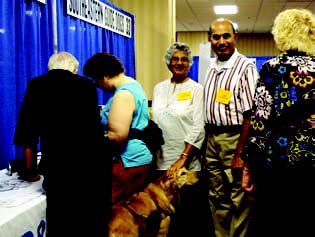
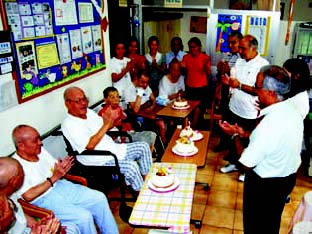
Sri Sathya Sai International Centre for Medical Services
7
“Doctors should realise what they owe to society, which has preserved and imparted to them their knowledge of the medical sciences. Medical knowledge has been enriched by the contributions of dedicated investigators over centuries. Doctors should be grateful to society for all the knowledge and skills they have acquired from the dedicated labours of others. They should realise their deep indebtedness to society for all they have received from it. Only then, they will use their knowledge and skills in the right way”
–Sri Sathya Sai Baba, February, 7, 1993
Sri Sathya Sai International Centre for Medical Services (SSSICMS) – Established to Ship Medical Supplies and Medical Equipment Free of Cost to Sai Medical Institutions in India and Other Parts of the World
With the Blessings and Grace of Sri Sathya Sai Baba, the Sri Sathya Sai International Centre for Medical Services (SSSICMS) was established in January 2009. This project was set up to ship donated medical supplies from the USA to Sri Sathya Sai medical institutions and hospitals in Puttaparthi and Whitefield, India.
An inaugural meeting, chaired by Dr. Narendranath Reddy, Chairman, Sri Sathya Sai International Medical Committee, was held on January 24, 2009. Doctors and many other professionals from all parts of the USA participated in the meeting to discuss and streamline operational procedures and protocols for this very special opportunity the Sri Sathya Sai Organisation in the USA has been blessed with. Dr. Reddy explained the importance of the Sri Sathya Sai Global Healthcare Mission and presented details of medical services offered at the Super Specialty Hospitals and General Hospitals in Puttaparthi and Whitefield, India. He added that the Sathya Sai medical institutions in India provide free medical care to all without regard to race, gender, age, nationality, caste or religion.
Regular rotations of surgical teams and medical personnel wishing to volunteer their services at the above Sri Sathya Sai medical institutions have been organised by the Sri Sathya Sai International Medical Committee. These medical professionals are from many parts of the world. They provide medical care for patients and also participate in medical education and teaching programmes at the hospitals. As a natural extension of volunteering their time, many doctors and volunteer teams have attempted to carry medical supplies and equipment to the medical institutions in India. Sometimes they encountered difficulties because of the regulations of Indian customs and the import duties and taxes of 34 percent on medical supplies. This problem is now resolved by the establishment of the SSSICMS.
The SSSICMS now operates on par with other charitable relief organisations that ship donated goods to India and other parts of the world. Much-needed supplies, such as heart valves and stents for cardiac surgeries, can now be shipped from the USA to India under an existing bilateral Indo-US agreement. Under this agreement, when the receiving entity in India and the sending entity in the USA are registered and approved by the Indian government, all medical supplies shipped as charitable donations under the bilateral Indo-US agreement will be completely free of import duty and taxes.
The Sri Sathya Sai Medical Trust, India was approved as a receiving entity in 2008, and the Sri Sathya Sai World Foundation, a non-profit charitable foundation and the governing body of the Sri Sathya Sai International Organisation, received approval as a sending entity in 2009. The SSSICMS now operates under this agreement.
Before shipment, a detailed list of medical supplies and equipment prepared by the SSSICMS is forwarded to the Sri Sathya Sai Medical Trust, India for approval. This initial procedure is adopted to ensure supplies shipped are in accordance with the medical institutions’ needs, depending on the services they provide. Once approved, the consignment is dispatched either by air or by sea, depending on the urgency of the need for the items or the quantities prepared for shipment.
The first shipment consisting of cardiac surgical • supplies was dispatched by air in March 2009.
The second shipment also carried cardiac surgical • supplies such as Bileaflet mechanical heart valves. In addition, Prolene sutures and medical equipment including an Echo probe was air freighted on August 28, 2009.
The third consignment by 40 foot container • shipped in September 2009 included medical supplies and equipment required for all departments of the Super Specialty Hospitals at Prasanthigram and Whitefield, India.
The SSSICMS has set up a main hub and three regional satellite hubs across the USA for receiving, storing, inventorying, packaging, and shipping medical supply donations.
The main hub is located in Los Angeles and serves also as a West Coast collection point for Regions 6-10 (Pacific North, Northern California and Nevada, Pacific South, Southwest, and South Central, stretching from Washington to Texas).
The other three hubs are in:
Rochester NY/Boston, Massachusetts (serving • Region 1—Northeast, and New York City),
Washington, DC (serving Regions 2 and 3—Mid-• Atlantic and Southeast),
Detroit, Michigan (serving Regions 4 and • 5—Mid-Central and North Central).
Questions about the project may be addressed to:
Dr. Ganesh Yadlapalli• (ngy51@hotmail.com)
Mr. Rohan Balasuriya• (RohanLBa@aol.com)
The regional hubs and contact persons are listed below. The contact individuals are available to answer questions from devotees, donors, physicians and allied healthcare professionals interested in participating in this noble service project.
|
Satellite Centres and Contacts by Region |
|
|
Northeast Satellite Centre – Region 1 and NYC Rochester NY/Boston Massachusetts Dr. Krishna Rao, srao@rochester.rr.com Mrs. Shantha Sarangapani, s.shantha@verizon.net |
Southeast Satellite Centre – Regions 2-3, (except NYC) Washington, D.C. Dr. Nandakumar Vellanki, nbvellanki@gmail.com Mrs. Sheela Nayak, sveryhappy@msn.com |
|
Midwest Satellite Centre – Regions 4-5 Detroit, Michigan Dr. Hari Conjeevaram, hconjeev@hotmail.com |
West Coast Centre, Regions 6-10 Los Angeles, California Dr. Chandra Das, drchandradas@gmail.com Mr. Rohan Balasuriya, RohanLBa@aol.com |
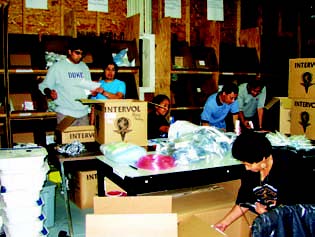
Medical Conferences and Seminars
8
“All of you have assembled here to discuss and exchange your knowledge and experience in the field of medical science. I wish you should discuss freely and find solutions to problems and render service to the people.”
–Sri Sathya Sai Baba, February 6, 1993
The state-of-the-art of medicine is ever expanding and ever changing. Having current medical knowledge and skills is very important in providing high-quality healthcare to patients. It is important for physicians and other clinicians to recognise this fact so that up-to-date treatment and care can be provided to patients at all times. It is well known that medical knowledge decays over a period of five to ten years from the time of completion of studies, which ultimately affects patient care. Several countries addressed this problem by imposing rules for passing recertification examinations and participating in continuing medical education (CME) programmes. However, in the majority of countries healthcare professionals are not required to attend CME programmes, and most importantly CME programmes are not easily available. Over the years, many CME programmes have been organised by members of the Sri Sathya Sai Organisation in Prasanthi Nilayam (in Puttaparthi, India) and in other parts of the world. The goal is to update the knowledge base of physicians by sharing with them information about new cutting-edge medical treatments and techniques.
Even if a strong knowledge base is achieved or already present, it does not guarantee that the healthcare provider will provide high-quality care. Besides medical knowledge, it is important that we incorporate the five human values given to us by Sri Sathya Sai Baba when serving and caring for patients. These five values are truth, righteousness, peace, love, and non-violence. The human value of love should especially be practised because the medicine of love is just as critical if not more critical in helping patients return to good health. Below are details of conferences organised by Sri Sathya Sai Organisations on medical knowledge and the role of human values in the delivery of healthcare.
Prasanthi Nilayam, India
Sri Sathya Sai International Medical Conference – 2005
On the occasion of the eightieth birthday of Sri Sathya Sai Baba, an historic international medical conference was held on September 3-4, 2005. This was organised jointly by the Sri Sathya Sai Baba Organisation of India and the International Medical Committee of the Prasanthi Council. The theme of the conference was “Sri Sathya Sai Healthcare Mission—Sai Ideal Healthcare.” This was the first such conference in the world to focus on the fundamental principles of healthcare postulated by Sri Sathya Sai Baba. The challenges and outcomes of delivering medical care with love, compassion, empathy, and the directed goal of patient welfare were discussed.
The conference was attended by over 900 delegates representing 27 different countries. Such a broad geographical distribution of delegates was remarkable for any medical conference.
The delegates began arriving in Prasanthi Nilayam in late August, but the majority arrived on September 1 and 2. Registrants were provided accommodation and meals during the conference. The delegates enjoyed a wholesome cuisine for the two days of the conference.
Several brochures, booklets, and reading materials were prepared for the conference. At the time of registration a handsome carrying case was distributed to every delegate with these publications outlining the central inspiring force of Sri Sathya Sai Baba’s Healthcare Mission, work done by the Sri Sathya Sai Hospitals, and Sri Sathya Sai Organisations, both in India and all over the world.
Among the materials distributed were a booklet, “Sri Sathya Sai Baba’s Healthcare Mission,” which provided a brief outline of Sri Sathya Sai Baba’s philosophy regarding all aspects of healthcare, and an issue of Swiss Med: A Review of Medicine and Medical Techniques, published in Switzerland, dedicated to the work done by the Sri Sathya Sai Institute of Higher Medical Sciences (SSSIHMS) in Bangalore and Puttaparthi.
In addition, there were two more booklets: “The Sai Health Mission Begins,” describing the history and work done at the Sri Sathya Sai General Hospitals in Puttaparthi and Whitefield, and “Sacrifice Is the Hallmark of a Doctor,” containing some of Sri Sathya Sai Baba’s Discourses regarding healthcare and articles by various doctors about the loving spirit of service.
Another brochure, “SAINET,” was included in the package. It described the massive malaria prevention programme undertaken in Kenya by the Kenyan Sri Sathya Sai National Trust in cooperation with the government of Kenya. A brochure and a programme booklet containing the schedule of events and brief resumes of the speakers were also included.
In addition to these reading materials, a binder, pen, and notepad were also distributed.
Before the inauguration of the conference, Sri Sathya Sai Baba blessed all the delegates with Divine Darshan, where He showered His Infinite Love and Grace on all for more than one and a half hours on the afternoon of September 2.
The morning of September 3 began with Sri Sathya Sai Baba’s visit to the exhibition hall. He toured the entire exhibition, paying close attention to all the posters that were exhibited. The exhibition showcased the extensive work that has been done in relation to Sri Sathya Sai’s Healthcare Mission worldwide by the Sri Sathya Sai Organisations and Sri Sathya Sai Hospitals.
The conference was inaugurated in the Divine Presence of Sri Sathya Sai Baba in the Sai Kulwant Hall. The welcome address and introduction to the conference were delivered by Dr. Michael Goldstein, Chairman of the Prasanthi Council, and Dr. A.N. Safaya, the Director of the Sri Sathya Sai Institute of Higher Medical Sciences.
Dr. Michael Goldstein spoke of Sri Sathya Sai Baba’s healthcare mission, its role as a solution to healthcare crises in many countries, and of the need in the world at this time for humane medicine. He noted how his own life and physical health have benefitted from adherence to Sri Sathya Sai Baba’s advice on healthy lifestyle choices. He also welcomed the wide representation of healthcare professionals to this historic conference. Dr. A. N. Safaya spoke of the significance of Sri Sathya Sai Baba’s health initiatives in rural India and mentioned some of the recent groundbreaking projects undertaken by the SSSIHMS in advancing compassionate and spiritual patient care. Both Dr. Goldstein and Dr. Safaya stressed that the path to better patient health is through the delivery of compassionate, loving, and spiritual healthcare.
This was followed by a lecture by the guest speaker, Dr. Alan Gradman. He thanked Sri Sathya Sai Baba for bringing him to His Divine Presence. Dr. Gradman recounted how he and his practice have changed to incorporate Sri Sathya Sai Baba’s teachings in his life and work. Emphasis was placed on the importance of compassion and human values in teaching and practising medicine.
The delegates were overjoyed to have the good fortune of being blessed by Sri Sathya Sai Baba with a Divine Discourse.
Sri Sathya Sai Baba gave a discourse on the importance of divesting ourselves of body consciousness and focusing instead on our fundamental “I” that is divine in order to serve our patients better. He began His discourse by emphasising that He, the Parthivasa (resident of Parthi), will always take care of each and every devotee.
In the afternoon, the conference proceedings were at the auditorium of the Sri Sathya Sai Institute of Higher Learning. Internationally renowned speakers who were experts in their respective professions highlighted the conference. There were several intellectually and spiritually enriching presentations by these speakers. Conference sessions were attended by a wide spectrum of healthcare professionals, ranging from physicians, nursing staff, leaders in medical education, health administrators, medical equipment suppliers, and government officials.
Dr. Narendranath Reddy, Chairman of the International Medical Committee of the Prasanthi Council and Assistant Clinical Professor of Medicine at the Keck School of Medicine, University of Southern California, presented an overview of all the healthcare service activities of the overseas Sri Sathya Sai Organisations, including medical and veterinary camps together with disaster relief work in the wake of the 2004 tsunami. Dr. Reddy emphasised the purpose of these medical services is to attain the goal of Unity, Purity, and Divinity and spread the message of Divine Love.
Dr. Kanwaljeet S. Anand, Professor of Paediatrics, Anesthesiology, Pharmacology, Neurobiology and Developmental Sciences, University of Arkansas for Medical Sciences and Arkansas Children’s Hospital, spoke about the four pillars of paediatric care, namely Prema (Love), Purity, Prevention, and Pain relief. Practising these four pillars contains the essence of Sai Ideal Healthcare.
Mr. Kalyan Ray, Senior Director of the United Nations and Senior Advisor to the Executive Director of UN-HABITAT, presented the SAINET project, an extensive Malaria prevention programme undertaken in Kenya. He discussed the role of governmental and non-governmental organisations’ partnering to provide effective large-scale preventive care.
The final speaker of the afternoon was Dr. Kishore Udipi, Research Director, Medtronic Vascular, Santa Rosa, California. He discussed the role of biomedical and pharmaceutical companies in making technological advances in the field of healthcare.
At the conclusion of the afternoon session, delegates and speakers were ushered back to Sai Kulwant Hall, where Sri Sathya Sai Baba blessed everyone with Divine Darshan for an hour and a half again. An unending stream of love and energy poured forth from Sri Sathya Sai Baba onto all assembled there.
The morning session on September 4 began in the auditorium with Dr. Neelam Desai, Head of the Department of Cardiothoracic Surgery, SSSIHMS, Puttaparthi. She presented astounding data on the types and numbers of surgeries carried out at the Superspecialty Hospital since its opening in 1991. The work done at Sri Sathya Sai Baba’s Hospitals is a testament that Sai Ideal Healthcare is here and now, providing state-of-the-art, specialised tertiary healthcare, free of charge to all without regard for colour, creed, or caste, but with the utmost humility, love, compassion, and empathy.
Dr. Hegde, Chairman of the Department of Neurosciences, SSSIHMS, Whitefield, presented data from the neurosurgical department. He cited a mortality rate of only 1.39 percent, which is far lower than that experienced by the most renowned neurosurgeons in the whole world. Yet, the cases selected are highly complex because they present late in the course of the disease, demonstrating that with Sathya Sai as our Saviour, we are merely His Instruments, as He does the Healing.
Dr. Ramchandiran Cooppan, Assistant Clinical Professor of Medicine, Harvard Medical School, discussed the imminent global epidemic of diabetes. He stressed the importance of preventive measures, including nutrition, diet, and exercise.
Dr. Keki Mistry, Director, D.Y. Patil Dental College and Hospital, New Mumbai, and Member of the World Health Organisation Expert Advisory Panel on Oral Health, presented a comprehensive overview of the medical and veterinary service activities provided by the Sri Sathya Sai Organisation of India.
The morning session concluded with a presentation by Dr. Anil Nanda, Professor and Chairman, Department of Neurosurgery, Louisiana State University Health Sciences Center. He referenced the earliest accounts of neurosurgical interventions mentioned in historical and spiritual texts to the latest technologies now available. Despite the technical mastery today, successful surgery rests on Divine Hands, which guide the surgeon during surgery. He stressed the importance of not getting carried away with the technology we have available; rather, we should treat the patient with utmost respect and reverence. A new line was added by Dr. Nanda to the Sanskrit verse “Matru Devo Bhava, Pitru Devo Bhava…” to include “Patient Devo Bhava”—respect the mother as God, the father as God, and now respect the patient as God.
The valedictory session was held in the Sai Kulwant Hall in the Divine Presence of Sri Sathya Sai Baba. The session began with a speech by Dr. Michael Rakoff, a paediatrician and healthcare consultant, outlining his experience of applying the human values to the practice of medicine. He noted that everyone in the conference had a sense of unity, harmony, humility, love, and sacrifice—ideals that are present as a direct result of Sri Sathya Sai Baba’s teachings.
Dr. Venkatraman Sadanand, Fellow in Paediatric Neurosurgery, Chicago, also spoke of the spirit of sacrifice that is the hallmark of a good doctor.
Concluding observations were made by a number of the speakers. Dr. Goldstein and Dr. Safaya suggested a need for more visibility of all the good work done in the healthcare field by the Sri Sathya Sai Organisations so that more people can find inspiration to carry out such noble selfless service.
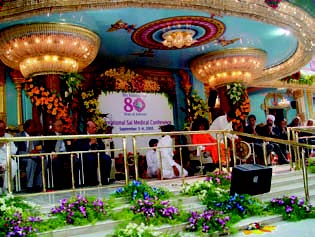
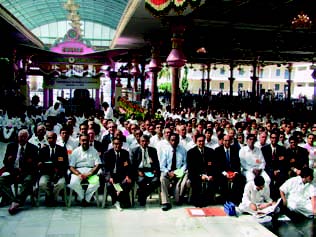
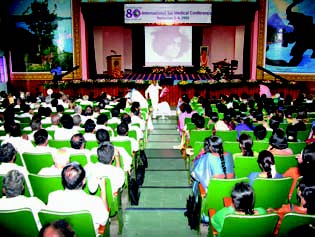
Prasanthi Nilayam, India
Sri Sathya Sai International Orthopaedic Conferences 2008 and 2009
The love and compassion of Sri Sathya Sai Baba for humanity has resulted in the expansion of the free, compassionate care offered at the Sri Sathya Sai Institute of Higher Medical Sciences. This selfless love has been expressed by the emergence of the Orthopaedic Department. Since its inception on July 13, 2006, the Orthopaedic Department has grown and provided much needed, specialised care to the suffering.
In addition to the clinical services provided by the department, it has hosted two CME conferences over the last two years. The Sri Sathya Sai First Annual Orthopaedic CME Conference was conducted at Sri Sathya Sai Institute of Higher Medical Sciences – Prasanthigram (SSSIHMS–PG) from July 11-12, 2008. The conference was attended by 92 delegates. Besides topics on orthopaedics, a presentation was given by Dr. Narendranath Reddy on Sathya Sai Ideal Healthcare and Global Health Mission. There was also a hands-on workshop on knee arthroscopy. The quality of the conference was considered to be excellent.
The highlight of the conference was Sri Sathya Sai Baba’s visit during which He delighted every one at the conference by showering His Grace and Blessings. Sri Sathya Sai Baba presented trophies as mementos to the faculty members. He then blessed all those who were at the conference.
The second orthopaedic conference, The Sri Sathya Sai International Orthopaedic Conference was held at SSSIHMS-PG, at Puttaparthi from July 10-12, 2009. Sri Sathya Sai Baba inaugurated the conference at approximately 4.00 PM on July 10. He also perused each one of the 52 posters, which depicted departmental statistics, several operative case reports, and activities of other departments in the hospital.
Approximately 150 delegates attended. The faculty consisted of three eminent orthopaedic surgeons, Dr. Leo Whiteside from the USA, Dr. Ian Learmonth and Dr. John Skinner from the UK, five reputed orthopaedic surgeons from India, and three orthopaedic surgeons from SSSIHMS.
Dr. R. Varadachari, Chairman of the Department, introduced the faculty, followed by the inaugural address given by Dr. A.N. Safaya, Director of the SSSIHMS-PG and Dr. Narendranath Reddy, Director, Sri Sathya Sai World Foundation. In his welcome address, Dr. Safaya spoke of the SSSIHMS as one of Sathya Sai healthcare institutions where ideal healthcare is practiced. Dr. Narendranath Reddy spoke on Sathya Sai Ideal Healthcare and the Sathya Sai Global Health Mission.
Many enlightening lectures were given on the theme of the conference, “Advances in Arthroplasty.” In addition, a state-of-the-art live surgery, a cementless total knee replacement, the first of its kind performed in India (symmetric porous condylar knee) was performed by Dr. Whiteside from the USA on July 11. Dr. Ian Learmonth of the UK performed the “metal on metal” cementless total hip replacement (ceramic on metal) on the 12th. These live surgeries were viewed by the delegates on television monitors.
The conference concluded on July 12, with a closing ceremony. The Orthopaedic Department honoured all 11 faculty. The entire faculty, and all the delegates were deeply touched by the love and compassion of Sri Sathya Sai Baba and the serene atmosphere prevailing in the ashram and the SSSIHMS. The delegates and faculty unanimously expressed that the high quality of the educational presentations, arrangements, food, and loving hospitality were well above the international standards. The visiting international faculty members commented that this was a unique conference due to the combination of state-of-the-art scientific, educational, and spiritual values that were expressed during the conference. They also felt the loving, compassionate, guiding touch of Sri Sathya Sai Baba. This conference left an indelible mark on the hearts and intellect of the delegates and teaching faculty.
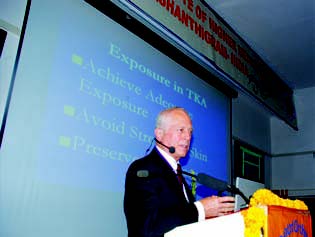

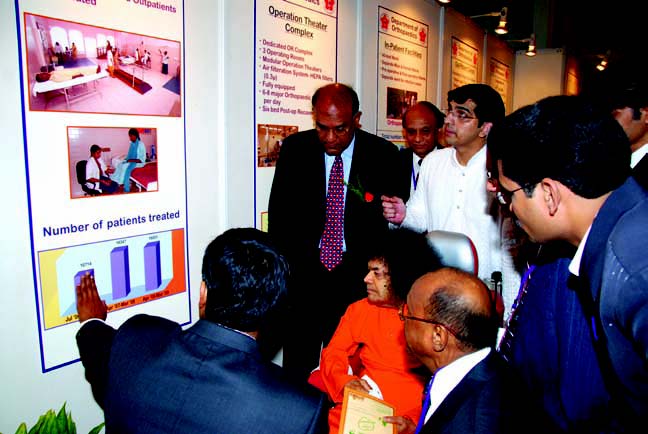
Sri Sathya Sai Baba visiting the conference exhibition
Prasanthi Nilayam, India
Sri Sathya Sai International Dental Conference 2009
The First International Dental Conference was held at Sri Sathya Sai Institute of Higher Medical Sciences (SSSIHMS), Prasanthigram, on January 17-18, 2009. This was organised by Sri Sathya Sai Medical Trust and the Sri Sathya Sai International Medical Committee.
The conference was inaugurated on Saturday, January 17, at 11 am. Dr. Ravi Dabir, Chairman of the Conference, welcomed all of the dignitaries and the 119 delegates from six countries around the world. Dr. Safaya, Director of SSSIHMS, Prasanthigram, welcomed the delegates and shared his thoughts about the Sathya Sai Health Care Mission. He said doctors have an obligation to treat their patients with love and compassion.
In his presentation, Dr. Narendranath Reddy, Chairman of the Sri Sathya Sai International Medical Committee, discussed the principles of Sathya Sai Ideal Healthcare and how they are implemented in the Sathya Sai Global Healthcare Mission. Dr. Reddy described how Sri Sathya Sai Baba laid the foundation for the first General Hospital in Prasanthi Nilayam on November 23, 1954. This hospital, which began with only 2 beds and 1 doctor, is now a 100-bed institution. From its inception, Sri Sathya Sai Baba has guided the physicians in the delivery of healthcare. Today there are many Sathya Sai Hospitals and Clinics, not only in India but also in other countries, providing healthcare with love and compassion to the needy. These facilities are treating countless people free of charge, irrespective of their financial status, caste, creed, nationality, or religion. Dr. Reddy also expounded on Sri Sathya Sai Baba’s message to healthcare professionals over the past 50 years regarding healthy living, preventive care, and compassionate care.
In his keynote address, Dr. Vijayendra, Head of the Department of Periodontics, RV Dental College, Bangalore, explained how periodontal disease (gum disease) is prevalent in India and Southeast Asia due to lack of dental care and dental hygiene. He recommended that everyone should have regular dental checkups and teeth cleaning by a dental professional to prevent gum disease. He said that according to the scientific evidence, gum disease plays a significant role in systemic diseases. He further discussed treatment modalities of gum diseases.
Dr. Archana Lakkaraju, who received her Master’s degree in Public Health in the USA, and is currently a practising dentist at Sri Sathya Sai General Hospital, Puttaparthi, stressed the importance of regular dental cleaning. She mentioned the consequences of neglect, such as loss of teeth leading to malnutrition.
The theme for the second day of the conference was how selfless and loving service could be provided to our fellow men. Dr. Prithvi Raval, a leading dentist in Bangalore, explained how he provided free dental service in remote places such as Guatemala in Central America, the Philippines, and Manali in the Himalayas. Dr. Volcheck and Dr. Bala from Arizona, USA, described how free dental services were provided in an urban setting like Phoenix, Arizona. They said that an affluent country like the USA also has needy and homeless people who cannot afford either medical or dental care.
Dr. Keki Mistry, Professor Emeritus of Orthodontics, GDC&S, Mumbai, and a prominent dentist and educator for the past 40 years, mentioned that Sri Sathya Sai Baba has been his spiritual guide and exhorted all to join hands to serve the needy with love.
In his closing remarks, Dr. Ravi Dabir thanked everyone who helped make the conference a success. He said that these types of conferences not only educate dentists in their respective fields but also inspire them to treat their patients with love and compassion and recommended that such conferences be held more often. Dr. Safaya also thanked the delegates and said that Sri Sathya Sai Baba has given us opportunities to redeem and sanctify our lives by selflessly serving the needy.
At the conclusion of the conference, the delegates felt uplifted. They were happy with the conference and the blessings they received from Sri Sathya Sai Baba.
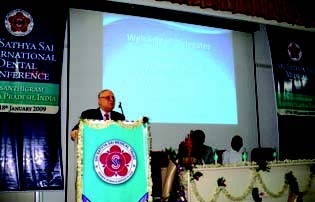
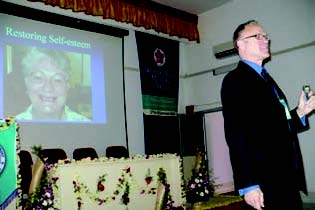
Central America
El Salvador – 2009
The name of the country El Salvador means “the Saviour,” referring to Jesus Christ, and the city San Salvador, means, “Saviour Saint.” A total of 260 volunteers from 8 countries participated and enjoyed the message and Divine Love of Sri Sathya Sai Baba at a Sai Baba Conference held in San Salvador during Easter Week, April 9-11, 2009.
Keynote speaker, Dr. Narendranath Reddy, Chairman of the Sri Sathya Sai International Medical Committee, spoke on the Sathya Sai Global Health Mission as it relates to Sri Sathya Sai Ideal Healthcare. He emphasised the principles of Sri Sathya Sai Ideal Healthcare and its implementation in the delivery of healthcare services, free of cost, with love and compassion, around the globe by Sri Sathya Sai medical professionals.
Dr. Simone Monteiro, a physical therapist from Brazil, spoke about her personal transformation as a practicing therapist. Dr. Omar Viera, a homeopathic practitioner from Venezuela shared his experiences with Sri Sathya Sai Baba and how these experiences have changed his attitude towards his profession in doing selfless service. Dr. Hector Castaneda, a neurologist, and member of the Sri Sathya Sai International Medical Committee for Latin America, spoke about the practise of human values (Truth, Right Conduct, Peace, Love and Non-violence) and their impact on health. Dr. Wilfredo Barrilas, a practising obstetrician and gynaecologist related a touching story of how even trimming toe nails of old people in the nursing homes gave him as much professional satisfaction and joy as performing the most complicated procedures. Many participated, including the country chairmen from Guatemala, Honduras, Nicaragua, Costa Rica, and El Salvador.
Guests were shown the awe-inspiring service projects done by the Sathya Sai Organisation of El Salvador. The youth presented a drama of the true story of a miraculous recovery by a terminally ill teen youth in El Salvador by the Blessings and Grace of Sri Sathya Sai Baba. Each evening featured a captivating musical programme by local artists. These Divine memories left an indelible impression on the hearts of the attendees.
Europe
Germany – Hannover Medical School April 2008
The first medical conference of Sri Sathya Sai Organisation of Germany was held at Hannover Medical School on April 25, 2008. The objective of the conference was to make the general public and health professionals aware of the significance of Sathya Sai Human Values in the field of medicine and give an overview of the humanitarian healthcare projects undertaken by Sri Sathya Sai Baba all over the world. About 150 participants, consisting of medical professionals from Germany, Austria, and the UK and members of the German Sri Sathya Sai Organisation, attended the conference. Three keynote speakers illustrated the guiding principles of Sathya Sai Ideal Healthcare with personal experiences in their own medical practice.
The first keynote speaker, Dr. Venkatraman Sadanand, a renowned paediatric neurosurgeon from Canada and a member of the International Medical Committee of Sri Sathya Sai Organisation, presented the philosophy and core elements of Sri Sathya Sai Ideal Healthcare. He shared his personal experiences and gave specific examples from Sri Sathya Sai Baba’s teachings on how to practise human values—Truth, Righteousness, Peace, Love, and Non-violence in the field of healthcare. The next speaker, Dr. Joseph Phaneuf, a dermatologist from the USA and Vice Chairman of the USA Medical Committee of Sri Sathya Sai Organisation, presented the Ashland Free Medical Clinic in California as an example of providing free healthcare with love and compassion. He also shared his valuable experiences of practising the human values. Dr. Surendra Upadhyay, a consultant ophthalmologist from the United Kingdom and a member of the International Medical Committee of Sri Sathya Sai Organisation, spoke on many of his experiences with the international medical camps in Russia and Africa. The conference concluded with a question and answer session. At the end of the conference, the Dean of the medical school in Hannover praised the humanitarian mega projects of Sri Sathya Sai Baba and hoped that more healthcare workers would learn from Sri Sathya Sai Baba’s Love, which is the basis for the success of these major projects.
UK – Medical Conference: “The Humanisation of Medicine”
A national medical conference was held in London on May 21, 2006 on the theme “The Humanisation of Medicine.” The purpose of the conference was to draw attention to the healthcare mission of Sri Sathya Sai Baba. The first speaker was Sri Ishver Patel, Central Coordinator of Sathya Sai Organisation in the UK and Ireland. He described the activities undertaken by Sathya Sai physicians in the world: the international medical camps, the General Hospital rotations and the medical activities in the UK and Ireland. The next speaker was Dr. Suresh Govind, an infectious diseases specialist. He said that the humanisation of medicine required the practice of harmony of thought, word and deed in daily life. By attending medical camps in deprived areas, doctors themselves would gain tremendously because they would gradually develop an attitude of compassion and love towards each individual they treated.
The next speaker was Dr. Puvanachandra, Member, International Medical Committee. He spoke on the Prasanthi General Hospital rotations for physicians. As part of his talk, he gave a detailed background of the evolution of the hospital, a succinct synopsis of the criteria for enrolling on the roster and the benefits to be gained by working in the Temples of Healing built by Sri Sathya Sai Baba. Another member of the International Medical Committee, Dr. Surendra Upadhyay, recalled numerous anecdotes about medical camps, experiences with Sri Sathya Sai Baba and about the late Mother Teresa. The next speaker was the National Service Coordinator, Sri Bharat Handa, who spoke on service activities in the United Kingdom and explained the key aspects of selfless service. He was followed by Professor Keith Critchlow, architect of the Super Specialty Hospital, Puttaparthi who spoke on “Temples of Healing and the Divine Architect.” He also showed photographs of the very first sketch of the Puttaparthi Hospital. It was remarkable how the initial sketch was identical to the finished hospital. The conference concluded with a comprehensive summary by Ms. Shobhna Patel, the Chairperson of the Sathya Sai Organisation of the United Kingdom.
Australia, Fiji and New Zealand
Fiji – Medical Conference: “Make the Difference”
The inaugural Combined Medical Conference of the Sathya Sai Service Organisation of Australia, University of Fiji, and the Sathya Sai Service Organisation of Fiji was held on July 12, 2008, at the Saweni, Lautoka campus of the University of Fiji. The theme of the conference was “Make the Difference.” The conference was opened by the high commissioner for the government of India. The Dean of the University of Fiji Medical School, the vice chancellor of the university, and the Chairman of the Sathya Sai Service Organisation participated in the opening ceremony. Prof. Rajat Gyaneshwar, Dr. Gunu Naker and Dr. Nadana Chandran organised the conference.
The main goals of this conference were to emphasise the principles of Sri Sathya Sai Ideal Healthcare, to identify the healthcare problems in Fiji and establish strategies to address those problems, and to encourage healthcare professionals to take part in service projects. There were excellent presentations from several of the medical team members and invited speakers. The invited speakers included the Director of Curative Services from the Fiji Ministry of Health, Dr. Ami Chand, and a senior physician from the Colonial War Memorial Hospital, Dr. Gyaneshwar Rao. A Sydney orthodontist, Dr. Christine Underhill, Dr. Shanta Muller from the University of Fiji, and Dr. Namrita Mesuria, a young dentist from Fiji, were the other three invited speakers. Dr. Ami Chand stated that the Ministry of Health has identified a triple health burden for the country: non-communicable diseases (NCD) such as diabetes and cardiovascular disease, communicable diseases (dengue and typhoid), and psychosocial health problems (suicide, MVA, domestic violence, and sports injuries). He said the major challenge facing the Ministry of Health in providing healthcare was a lack of resources (workforce, infrastructure, equipment, supplies). Dr. Gyaneshwar Rao told the conference that 82 percent of deaths in Fiji were due to NCD, 10 percent were due to communicable diseases, maternal, and perinatal causes, and 8 percent were due to injuries and poisoning. He argued that the provision of healthcare should not be constrained by lack of resources. Much can be done within existing resources by exercising common sense and good medical practice.
Medical Seminars
Argentina
Medical education and health care policies: For the first time in Argentina, a one-day seminar was organised for public health professionals on August 9, 2006. The seminar covering the topic of loving, compassionate healthcare and quality of life was organised by the Sathya Sai Baba Organisation and co-sponsored by the Institute of Neurobiology and the Secretary of Science and Technology. The meeting was attended by 70 health professionals. In his opening address, the Director of the Institute of Neurobiology remarked that this was the first time such an approach to modern medicine was being taken, and he thanked the leadership of the Sathya Sai Baba Organisation for it. Other speakers reiterated that paying attention to the patient’s mind and spirit complements the role of modern medicine, citing the example of such pioneering work in healthcare by the Sri Sathya Sai Institute of Higher Medical Sciences in India. This was followed by a description of the work done by the Sathya Sai Baba Organisation in Argentina with particular reference to weekly medical camps run in villages. All participants expressed a sense of gratitude to the Sathya Sai Baba Organisation for the renewed approach to healthcare with attention to the body, mind, and spirit.
Communal Medical Services Internships• An internship in communal medical services is offered for new medical practitioners in the medical camps of Gran Buenos Aires.
Communal Mental Health Course• Periodic meetings are organised with professionals specialising in mental health in order to structure and supervise the communal mental health activities.
Health and Human Values Research• A group of volunteers select all relevant information regarding human values in health. Periodic meetings are held that are focused on the research and deepening of this subject.
Bolivia
On February 12-15, 2008, the Doctor Percy Boland Municipal Hospital for Women in Santa Cruz, Bolivia, hosted the Sri Sathya Sai Human Values Seminar. The four-day seminar attended by 207 staff members was designed to help medical professionals infuse human values into their work. Participants learned how the five human values, especially love, can be even more important than medicine in bringing patients back to good health. Feedback from the medical professionals who attended the seminar confirmed that this was a very inspiring event. Many doctors commented that the human values seminar helped them to be more effective in their professional practice. It also made them happier while doing their work. The hospital administration has agreed to follow up the human values seminar by stipulating one human value to be practised by the staff every month, using materials supplied by Sri Sathya Sai Organisation.
Bosnia and Herzegovina
Seminars were conducted for medical professionals in the medical college and for the general public on May 21, 2005 in the city of Modrièki Lug in the Republika Srpska region of Bosnia and Herzegovina.
Colombia
The Sathya Sai Organisation conducts conferences every month on spirituality and health, which are open to the public. To date, 18 conferences have taken place, attended by approximately 4,000 people. Proceedings of the conferences have been made available to the public.
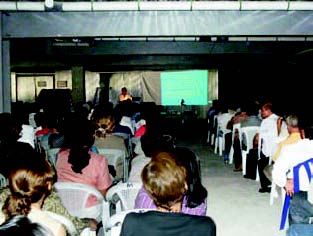
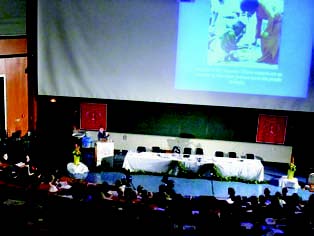
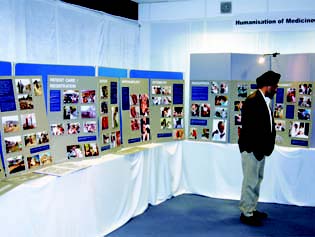
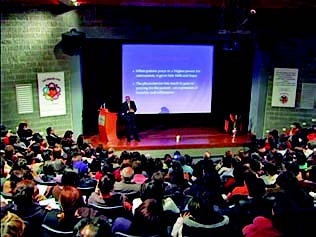
A monthly Sathya Sai Health Seminar in Colombia
Summary
Sri Sathya Sai Baba has said that the duty of the physician is not just to treat, but to treat with love and compassion and teach the patient in such a way that the patient is better informed about disease factors and does not have to frequently return to the physician.
These conferences and seminars are a testimony to the fact that Sri Sathya Sai Baba’s Healthcare Mission is rapidly taking root in several countries throughout the world. Sai Ideal Healthcare is globally achievable and sustainable if individuals, spiritual organisations, and healthcare professionals commit themselves to this goal.
In addition, this ideal healthcare philosophy reinforces the delivery of patient-centred care at all levels of the industry with diligence, dedication, and determination together with love, humility, humanity, compassion, empathy, and self-sacrifice. This approach has been the singular goal in the wide spectrum of activities undertaken under the direction and inspiration of Sri Sathya Sai Baba. The outpouring of love and appreciation by all concerned during these activities has been touching and phenomenal.
Many countries are presently experiencing serious problems with healthcare delivery, making healthcare an important topic of their political agendas. Sri Sathya Sai Baba’s message and healthcare mission provides a different perspective to those issues by making medicine more humane and patient-centred.
The essence of Sri Sathya Sai ideal healthcare is reflected by an excerpt from Sri Sathya Sai Baba’s discourse in August 1976:
“Look upon (your patients) as your own kith and kin, as your special guests and as your closest friends, and attend to them lovingly and with unflinching care. I call you to maintain this attitude in every situation.”
At these various medical conferences and seminars, delegates from all over the world were inspired by Sri Sathya Sai Baba’s healthcare mission and His teachings on patient care. They took this message to their own communities, and through their own examples, will serve as beacons of Sathya Sai Ideal Healthcare.
Vision for the Future
9
“I conclude…with the benediction that in the years to come all people should lead healthy and ideal lives.”
–Sri Sathya Sai Baba, February 7, 1993
Impact of Telehealth on Healthcare
Sri Sathya Sai Baba, has given us the model for ideal healthcare. He has established two general hospitals and two super specialty hospitals to serve as a model for the rest of the world as to how hospitals should function: free of charge without any bias regarding race, status, or wealth, providing excellent universal healthcare with love and compassion. However, only a small fraction of the patient population is able to access healthcare for various reasons, including distance and expense. Conversely, there are many physicians and other healthcare professionals that would like to serve, especially in Sri Sathya Sai Baba’s ideal healthcare mission, but find it difficult for various reasons, including conflicting work schedules and travel issues.
It would be wonderful if those who need healthcare had easy access to free healthcare and those medical professionals seeking to serve were easily accessible to help. We have the technological capability to address both of these issues. This article will focus on how technological advances are utilised, not only in patient care but also in physician education and training. At the centre of this teleconsulting and tele-education network is the Sri Sathya Sai Institute of Higher Medical Sciences (SSSIHMS). The clinical component currently includes satellite-based consulting (teleconsulting) for preliminary diagnosis, presurgical and postsurgical follow-up, scheduling appointments for hospital visits, expert opinion, and patient counselling. The educational component involves participation in continuing medical education (CME), training of DNB students (physicians in residency training), and exchange of state-of-the-art practices and expertise between participating institutions. This telehealth initiative would facilitate support for rural health initiatives by increasing access to Sri Sathya Sai ideal healthcare for the rural populace.
The Sri Sathya Sai telehealth project was initiated to extend the reach of the free, high-quality healthcare provided by Sri Sathya Sai Baba’s medical institutions. The Sri Sathya Sai Medical Trust (SSSMT) established by Sri Sathya Sai Baba operates two super specialty hospitals, two general hospitals, and a mobile hospital. These institutions provide free healthcare to patients from all over India and even adjacent countries such as Nepal, Sri Lanka, and Bangladesh.
Phase 1 of the telehealth project was established at SSSIHMS-Whitefield, SSSIHMS-Prasanthigram, and Sri Sathya Sai Seva Kendra, Barrackpore Cantonment, West Bengal, in association with the Indian Space Research Organisation (ISRO). ISRO is well known for its pioneering role in supporting telehealth services in India, whereby rural health centres are linked with super specialty hospitals via satellite. ISRO provided the software, hardware, communication equipment, and satellite bandwidth and helped link all three sites. The whole process of equipment transfer, installation, testing, and staff training was completed in a record span of only 24 days! Routine teleconsultations from SSSIHMS-Whitefield to the Barrackpore site began in September 2007 for neurosurgery, and cardiac teleconsultations began in June 2008. Phase 2 of the project was established in May 2009 with routine teleconsultations between Sri Sathya Sai Seva Samiti, Kharvel Nagar, Bhubaneshwar, Orissa, and SSSIHMS-Whitefield commencing in June 2009.
A well-trained local physician (trained by SSSIHMS) is available at the remote site. Using a local physician helps ensure proper communication and transfer of information. The observations and progress notes of the local physician are recorded into an electronic medical record (EMR). Medical reports are scanned into the system. Diagnostic images are uploaded into the system, if needed. This completes the registration process for the teleconsultation. The consultants at SSSIHMS can then review the uploaded file. The patient and the local physician from the remote site come online, and a televideo conference takes place with live interaction with SSSIHMS. While the videoconference is occurring, the consultant has all the pertinent information simultaneously on the EMR. The consultant can also review previous SSSIHMS records from earlier patient visits (physically in the hospital or virtually through telemedicine) on the hospital information system (HIS). The consultation that is then rendered is entered into the EMR and is available to the remote site to be printed and given to the local physician and patient. The SSSIHMS records are also electronically updated to reflect the encounter.
The majority of telemedicine patients at present are patients from SSSIHMS-Whitefield, and the patient information (previous visit details, laboratory test results, radiology, pathology, discharge summary, etc.) is available in the HIS. This information is accessible and will soon be integrated into the picture archiving and communication system (PACS) so that the radiology images will also be accessible to the consultant on demand.
Since implementation of the telehealth services in September 2007, SSSIHMS-Whitefield has offered 1,783 teleconsultations in 249 sessions (1,326 neurosurgery; 457 cardiac) as of August 31, 2009. There has been a significant impact on these patients and their families, with a significant reduction in cost of travel, less inconvenience for the patient, and less stress for these patients and their families/attendant. Communication has also been improved by using local well-trained physicians. It is well known that better communication results in fewer medical errors and improved patient care. As part of the next phase of the telehealth project, the videoconferencing infrastructure of the telemedicine centre at SSSIHMS-Prasanthigram will be upgraded to enable the site to also participate in teleconsultation services with the states of West Bengal and Orissa.
The second important role of telemedicine is physician education. Physician education includes CME and resident education. An example of tele-education CME at SSSIHMS-Prasanthigram is the ophthalmology teleconference from Sankara Nethralaya, a respected eye hospital in Chennai. Nearly 270 such conferences, roughly 2 to 3 classes per week, have taken place as of August 31, 2009. The urology department is planning to have tele-CME conferences every week with another hospital from South India. The ophthalmology department at SSSIHMS-Prasanthigram attended live international ophthalmology conferences via the telemedicine link in January 2008 and in January 2009.
A tele-CME conference on diabetes-related complications will be conducted by Dr. Mohan’s Diabetes Specialities Centre, Chennai, for DNB residents in orthopaedics, urology, ophthalmology, cardiology, and anaesthesiology at SSSIHMS-Prasanthigram. The DNB residents (family medicine) from the general hospital, Prasanthigram, will also participate in this programme via the telemedicine facility. The schedule for various topics is being finalised now, and the programme will begin in September 2009.
Many physicians travel from various parts of India and from many countries to serve at Sri Sathya Sai Baba’s institutions. These physicians have been coming for many years for the opportunity to serve in Sri Sathya Sai Baba’s healthcare mission at the general and super specialty hospitals in teaching and clinical roles. This process has been beneficial for the residents and staff at Sri Sathya Sai Baba’s medical institutions and the visiting doctors. The radiology department at SSSIHMS-Whitefield and Prasanthigram has been using Internet-based teleconferences for several years. Improvements in bandwidth and software have facilitated videoconferences and online meetings. Using inexpensive commercially available software, Web-based teaching conferences are now held almost daily. The ability to share a desktop makes it possible to give Powerpoint presentations to multiple locations and to instantaneously look up articles online and share them with the residents and staff. This powerful teaching method also suits radiology well because this specialty is inherently technology based and the residents are comfortable with the Internet and online teaching experience. Online teaching sessions include didactic Powerpoint lectures, case presentations, and oral boards review case sessions simulating the oral board examinations. Currently experienced radiologists from the UK and USA are participating in these tele-education conferences. Typically the conferences include the radiology residents at SSSIHMS-Prasanthigram and SSSIHMS-Whitefield and the instructing physician in a three-way conference that lasts 60 to 90 minutes.
Consulting radiologists primarily from the USA and UK with subspecialty expertise, especially in neuroradiology and musculoskeletal radiology, have also helped in patient care. Difficult cases are presented to the consulting radiologist. The clinical problem and diagnostic imaging are discussed. The treatment plan and follow-up are reviewed using the aforementioned PACS system at the SSSIHMS-Prasanthigram and Whitefield. In the future, the general hospitals may also be linked with this system, allowing for efficient use of experienced radiologists to provide timely, accurate interpretations and facilitate patient care. This system also facilitates image retrieval and improves the ability of the residents to show cases for discussion.
The pathology department has also been looking into use of telemedicine for difficult cases and second opinions. At SSSIHMS-Whitefield digital images of pathology slides have been sent to an expert in the USA for a second opinion. However, with the new HTML-based PACS system, it should be possible in the near future to upload histopathology images into the PACS system for remote viewing. This type of remote viewing of information will allow the PACS/HIS to be shared by approved experts for consultations in various fields, including radiology and pathology. This system should allow for a robust communication that will help in patient care, CME, and resident education.
In summary, technological advances are useful not only for providing the highest quality, free medical care, but also for expansion of Sri Sathya Sai ideal healthcare. This includes expansion of healthcare to rural/remote areas so patients can be served in the future. Also, this service will reduce the cost of travel and inconvenience for the patient. Furthermore, well-trained physicians from around the globe will be able to participate in the practice of Sri Sathya Sai ideal healthcare via telehealth initiatives. They will not need to travel to India or remote locations and will become an integral part of the Sri Sathya Sai ideal healthcare mission and receive immense spiritual and professional benefit. In addition, the telemedicine initiatives will continue to aid resident education and CME.
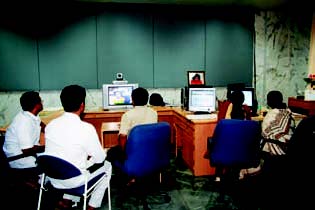

Mobile Clinics
There are many communities where access to basic medical care is not available. The purpose of mobile clinics is to provide healthcare to these areas and help promote healthy living. Because of limited resources, these individuals cannot afford to travel to clinics or hospitals far from their communities to access routine and sometimes urgent health care. This is a grassroots organisation where volunteers working in the mobile hospitals and clinics work side by side with community leaders and volunteers to care for those in need. The broad areas of services include (i) primary care, (ii) acute care, and (iii) preventive medical care.
The Sathya Sai Mobile Hospital under the guidance of Sri Sathya Sai Baba serves with the noble mission of bringing healthcare to the rural doorstep. The mobile clinic with its team of doctors and volunteers visit several villages around Puttaparthi, India each month and offers diagnostic and therapeutic medical, dental, and surgical services to the people in these villages. Additionally, patients who need urgent care, advanced medical needs, and/or further follow-up are promptly referred to the local Sri Sathya Sai hospitals for continued treatment. The purpose of the Mobile Hospital is also to help foster awareness on preventive medicine and emphasise the importance of spirituality in one’s health.
The medical voids served by these mobile clinics are not unique to underdeveloped areas of the world but is evident in communities everywhere. For example, in developed countries such as the United States there are designated medically underserved areas and health professional shortage areas that are federally designated geographic areas with a scarcity of primary healthcare services. It is in these medically underserved areas and in rural and remote areas throughout the world that the services provided by the mobile clinics are essential and serve as models of ideal healthcare.
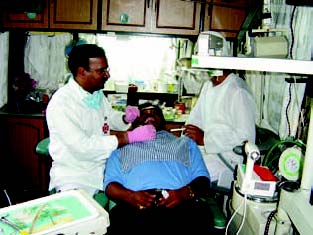
India
Gujarat
In order to provide medical facilities to villagers of interior areas, a mobile medical van with general medicine, cardiogram, laboratory, eye department, and mother and child care facilities has been procured by Sri Sathya Sai Service Organisation, Bhavnagar. On the occasion of its inauguration, a heart checkup camp was also conducted with the help of Sri Sathya Sai Heart Hospital, Rajkot. In the camp, about 250 patients were checked, 19 patients were given dates for surgery, and 62 patients were advised to undergo angiography.
Kerala
For effective implementation of Sri Sathya Sai Village Integrated Programme, the Sri Sathya Sai Mobile Clinic was inaugurated in Thiruvananthapuram district on November 17, 2007. All facilities for various types of medical checkups, laboratory tests, etc., are arranged as part of this mobile clinic. Now this mobile clinic is going to the interior parts of the district and taking care of patients who are immobile.
The Sri Sathya Sai Mobile Clinic for the Ernakulam District was started on February 22, 2008. This was the second mobile clinic of the Sathya Sai Organisation of Kerala.
Sri Sathya Sai Mobile Hospital
Sri Sathya Sai Mobile Hospital is a unique free rural outreach health service which was launched by Sri Sathya Sai Baba on March 3, 2006. The service operates from the 1st to 12th day of every month at 12 nodal points (base villages) and each of these serve 6 surrounding villages. Seventy two villages are thus currently being serviced by the Mobile Hospital, although in practice, patients are drawn from nearly 400 villages in the region.
The Mobile Hospital is managed on an entirely voluntary basis. About 500 doctors from the state of Andhra Pradesh belonging to 12 specialties dedicate their skills and they come in rotation to serve on an ongoing basis. Some of the unique features of the Mobile Hospital include diagnostic facilities such as an ultra- sonogram, an x-ray plant with automatic processor and a laboratory, which can do most of the routine pathological and bio-chemical investigations. The presence of this diagnostic support ensures quality and credibility to the services provided.
Since this is an outreach programme, the theme of the Mobile Hospital has included three main aspects of service consisting of (i) Curative drive (ii) Preventive focus and (iii) Spiritual base.
The curative drive owes its strength to the presence of doctors belonging to nine specialities on any particular day including medicine, surgery, paediatrics, orthopedics, ENT, dentistry, ophthalmology, gynaecology, and radiology. These specialists work under a common roof integrating their efforts to solve many of the intricate problem people present with. About 600 to 700 patients are seen every day at each of the nodal points. On the diagnostic front, for tests which cannot be done in the bus, blood samples are collected and are delivered to the laboratories in the Sathya Sai Institute of Higher Medical Sciences, Puttaparthi for testing and reporting, thus ensuring that everyone is being provided a loving door-step service. The curative work is further strengthened by a strong pharmacy which ensures that patients with chronic ailments like diabetes, hypertension, heart disease, asthma, epilepsy, etc., are all provided with continuous and uninterrupted supply of medicines (one month supply till the next month’s visit).
Patients requiring follow-up treatment like surgical intervention are referred to the Sri Sathya Sai hospitals and their medical conditions are monitored till the logical solutions are addressed.
The preventive work consists of health education, which is extensive and detailed covering several aspects of keeping good health. Five major health-related topics are discussed: cleanliness (environmental, home and individual), nutrition, healthy air and water, harmful effects of smoking and alcoholism, proper physical exercise and mind relaxation. Education on these subjects is done at the individual, family, and community levels using a variety of tools that includes audiovisual presentations, demonstrative sessions, interactive meetings, photo exhibition and is further reinforced by showing these presentations regularly in the local cable television.
The spiritual base of the service involves telling and motivating the villagers on the importance of positive thinking, human values, prayer and meditation, all of which foster positive health. A variety of programmes that focus on these values are conducted.
Comprehensive healthcare is provided to these communities through preventive healthcare and diagnosis and treatment of common minor and chronic ailments. Only problems requiring major surgical intervention are referred to the tertiary-care hospitals.
The impact of the Mobile Hospital services has been tremendous. On the curative front, it has given a sense of great security to people living in nearly 100 villages around Puttaparthi. It is a boon for patients with chronic ailments who can never dream of buying medicines on a continuous basis. The preventive services have created a huge wave of awareness on major health issues, which is slowly getting translated into changing habits, for the better. The spiritual component of the service has strengthened the community bonds and has reminded people that spirituality is the way of life and practicing human values leads to positive health and happiness. The Mobile Hospital is thus acting as a silent vehicle for providing comprehensive healthcare and is also becoming an instrument for dissemination of the ideals of healthcare which Sri Sathya Sai Baba has set for all. It is not only a state-of-the-art rural outreach service but also a state-of-the-heart caring and loving service. •
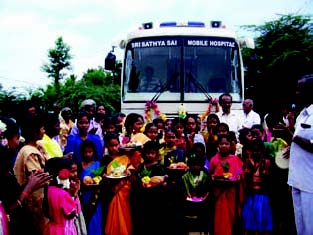
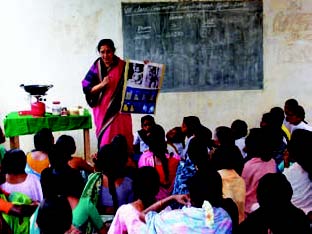
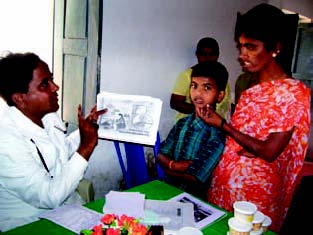
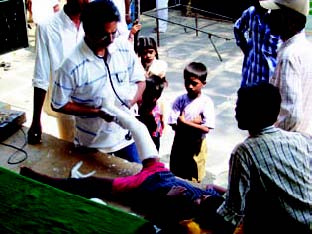
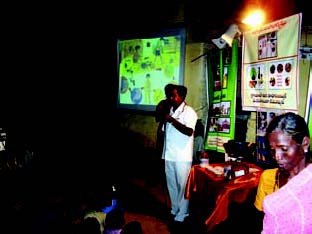
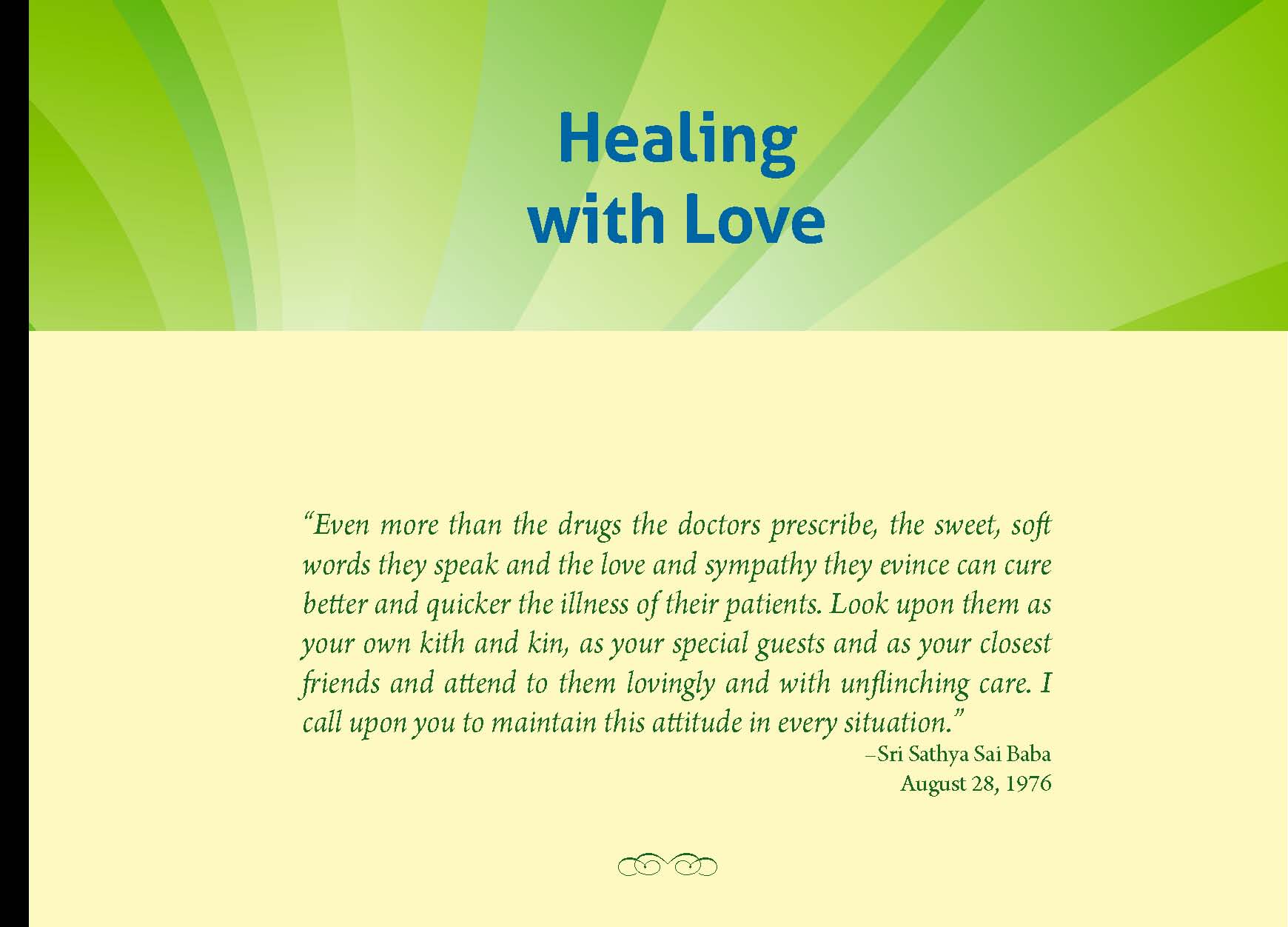
Healing
with Love
“Even more than the drugs the doctors prescribe, the sweet, soft words they speak and the love and sympathy they evince can cure better and quicker the illness of their patients. Look upon them as your own kith and kin, as your special guests and as your closest friends and attend to them lovingly and with unflinching care. I call upon you to maintain this attitude in every situation.”
–Sri Sathya Sai Baba
August 28, 1976
••
“It is your good fortune that you have become doctors. Sacrifice is the hallmark of a true doctor. So, doctors should have the spirit of sacrifice. They should be compassionate and considerate towards the poor. There are many poor people who are losing their lives as they cannot afford costly treatment. Your love alone can sustain such lives. The more you develop the spirit of sacrifice in you, the greater will be the world’s progress.”
–Sri Sathya Sai Baba
January 19, 2001






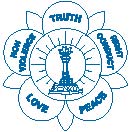
Sri Sathya Sai World Foundation